Digital Dog Training Textbook
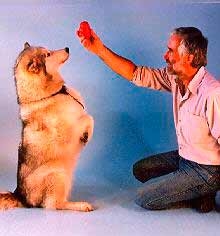
Dogs will be dogs. They are guaranteed to pee, poop, chew, dig, bark and bite. So if you invite a dog to live in your home, it is up to you to teach them where, when and how.
Raising a puppy can be a wonderfully enjoyable, or horribly frustrating experience, depending on what you know. We believe that proper dog training information is so important that it should be freely available to all, with the hope that dogs (and their humans) will be happier and healthier because of it. This is why we have created the:
The Dog Star Daily Online Digital Dog Training Textbook
It is our hope that many owners will read this information before they get their puppy, so that they will be fully prepared when they bring their pup home. If you are thinking about getting a puppy, we suggest starting at the beginning with Chapter One: BEFORE You Get Your Puppy.
However, if you already have a puppy or dog, you can go immediately to the age-relevant section for your pet. If you not only have a dog, but also have a specific behavior problem, you can go immediately to Chapter Six: Dog Behavior Problems for help.
Every page of the Training Textbook has a “Related Videos” section in the right hand column, which will display videos relevant to the section.
If you have a question about our site or your dog, please contact us.
Whether you live with a Chihuahua or a German Shepherd, a Rottweiler or a Dachshund, a Golden Retriever or a Labrador Retriever, an English Bulldog or a French Bulldog, a Beagle or a Boxer, a Yorkie, a Poodle or a Shih Tzu, all dogs need to be trained.
Whether you live with a puppy, an adolescent, an adult, or a geriatric, all dogs need to be trained. And if you are living with a puppy or an adolescent dog, your dog’s socialization and training are both essential and extremely urgent.
There is simply no excuse to deny your dog an education. By following my advice and watching the many free videos in this section, you will find that dog training is not only quick and easy, but also lots and lots of fun. I have only recommended dog-friendly training techniques that may be easily mastered by all family members, especially including children.
For easy access, I have organized the socialization and training tips chronologically, according to the age of your puppy/dog. Obviously, it is essential to learn how to choose and raise and train a dog before bringing one home. Socialization and training have many crucial deadlines, especially during the first few weeks and months after your puppy comes home. Your puppy needs to be errorlessly housetrained and chewtoy-trained within the first week at home (if not before), socialized by three months of age, and develop bite inhibition by five months.
Puppy classes are absolutely essential for your dog to learn bite inhibition and develop a soft mouth. Doggy adolescence is a turbulent time and you will have to be extra especially vigilant to make sure that your dog’s manners, behavior and temperament do not regress.
Once your dog matures, at about two years of age for small breeds but not until three years of age for large breeds, temperament and habits will become more resistant to change.
If you have followed the puppy training advice above, you will now be happy to know that your dog’s well-established good habits are just as hard to break as bad habits. If on the other hand, your adult dog has developed some behavior, temperament or training problems, retraining is still possible, but it will take much more time than preventative puppy training and, you’ll have to use different training techniques (all-or-none reward training) than the lure/reward training techniques that worked so well with your puppy.
Additionally, I have included special sections on behavior problems, dog behavior and dog-dog play, and having fun playing games with your dog.
The Dog Star Daily Digital Dog Training Textbook is an Amazing Resource.
If you want an even more amazing resource, check out The Best Online Puppy Training Programs:
The Top Dog Academy. Filled with videos, worksheets, podcasts, and more, the Top Dog Academy has everything you need to know about dog training, including, puppy training, socialization and how to resolve any type of behavior problem. When you join the Top Dog Academy you also get access to personalized email support so you can train your dog yourself. Use this link to get your first month for free.
SIRIUS Puppy Training. Looking for more support? Get personalized, real-time, video dog training guidance from an expert SIRIUS Instructor. Dr. Dunbar's SIRIUS Puppy & Dog Training classes revolutionized the world of pet dogs when they were first created. Now, our online small-group classes allow you to get the expert assistance you need from the comfort of your home.
Ch 1: Before You Get Your Puppy
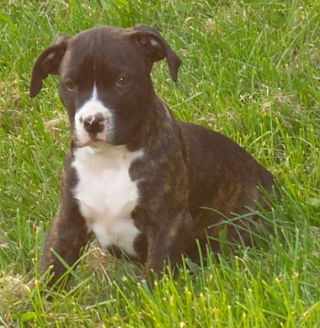
Congratulations on beginning your search for a puppy. Please take your time making your decision. Your puppy’s quality of life as an adult dog pretty much depends on his socialization and training during his first few weeks in your home.
Puppies grow up fast. One day you have a bumbling ball of fur and the next you have a raging adolescent. It is essential that you know how to raise and train a puppy before you get one. The first three months of their lives are a critical period for socialization and training, during which time they will develop the foundation of their lifelong behavior and temperament. You need to be aware of their developmental priorities as well as the basics of raising a puppy and teaching manners and obedience.
Additionally, you should put a lot of thought into which puppy to choose. When and where you get your puppy, the type or breed to choose and the specific puppy you pick, then check our shopping list and buy the necessary puppy training tools so your house is ready to welcome your pup.
Most of all, please take your decision to get a puppy seriously. Each year, several million dogs are abandoned, given to shelters and euthanized, almost entirely because easily preventable and utterly predictable puppy problems were allowed to develope into much more difficult to resolve adult behavior, training and temperament problems.
Please remember that every unwanted adult shelter dog began his life as a perfectly normal puppy. The time to rescue unwanted adult dogs is right now, when you are searching for, choosing, and deciding how to raise and train your puppy. Please, DO NOT CREATE YET ANOTHER UNWANTED SHELTER DOG!
Basically, dogs are abandoned or surrendered to shelters because they misbehave. Dogs misbehave (act like dogs), simply because no one taught them how to behave appropriately when living with people.
The sequence of events is predictable and much too common. A new puppy is given too much freedom and too little supervision. Not surprisingly, the puppy makes housesoiling and chewing mistakes. The puppy is confined to the yard, where he eliminates and chews indiscriminately and also learns other bad habits — digging, escaping, and excessive barking. Neighbors complain of the barking and the adolescent dog is confined to the garage or basement, which the dog destroys. In solitary confinement, the dog quickly desocializes and becomes fearful of people in particular and life in general. By six to eight months of age, the dog is surrendered to a shelter where the dog is confined to a cage. Shelter workers try to rehabilitate and rehome unwanted dogs. Some get a second chance, some don’t.
Please take the time to learn how easy and how enjoyable it is to train your puppy to be a sociable and mannerly canine companion, who will enjoy his entire life in his original home — yours.
Whether you choose a Chihuahua or a German Shepherd, a Dachshund or an English Bulldog, a Rottweiler or a Shih Tzu, a Boxer or a Golden Retriever, a Beagle, a Yorkshire Terrier, or a poodle, your puppy will still need to be socialized and trained. By the time you chose you puppy at eight weeks of age, the Critical Period of Socialization is nearly two-thirds over! And so, by the time your new puppy comes home, the urgency for socialization will be extreme.
Behavioral developmental may vary hugely from puppy to puppy at eight weeks of age. Some puppies are well socialized and confident, housetrained and chewtoy trained, and will happily come when called and sit, lie down and rollover. Other puppies are shy and fearful and have been taught no manners whatsoever. In the absence of basic kennel husbandry, puppies have learned to eliminate anywhere and everywhere, to chew anything and everything and to vocalize excessively, and this, of course, is how your puppy will behave when you take him home. You will be playing behavioral catch-up from the getgo.
Eight-week-old puppies should be well socialized, housetrained, chewtoy trained and have a good understanding of basic manners.
You have a choice and so, choose wisely. And when you chose your puppy, please give him the education that he deserves. Please review the hundreds of free dog training videos on dogSTAR daily before making your choice. You must learn how to raise and train a puppy BEFORE you get one.
Before you look for your perfect puppy, you need to know what sort of dog to look for, where to get it, and when to get it. An educated choice is generally far better than an impulsive puppy purchase. Additionally, you need to thoroughly familiarize yourself with canine developmental deadlines; they become urgent and crucial the day you select your puppy. Take your time to review dogSTAR, read books, watch DVDs, observe a number of puppy classes. Talk to owners at puppy class and discover what types of problems they are experiencing. New puppy owners are ruthlessly honest when describing their puppy's problems. But above all, test-drive as many adult dogs as possible. Then, make a thoughtful choice.
When choosing a puppy, you need to know how to determine whether his behavioral development and education are up to par. Assessing a pup's developmental and educational status depends on your education about puppy education.
Your pup's first month in your home is the most crucial developmental period of his life. This short, make-or-break period pretty much determines whether your puppy will develop into a well-mannered and good-natured companion that will bring joy to your life for many years to come, or whether your puppy will develop numerous, predictable behavior problems and grow up to be fearful and unfriendly. You prospective puppy stands at the crossroads and the course of your puppy's development and future quality of life is entirely in your hands.
Familiarize yourself with the common and predictable puppy problems, be aware of the timetable for their development, and make sure you are familiar with dog-friendly preventative measures and solutions, including the overwhelming importance of early socialization, confinement, and lure/reward training techniques.
It is vital that you know what and how to teach your puppy, before you get him. Your dog's future depends on it.
Adapted from BEFORE You Get Your Puppy by Dr. Ian Dunbar
Your Education About Puppy Education
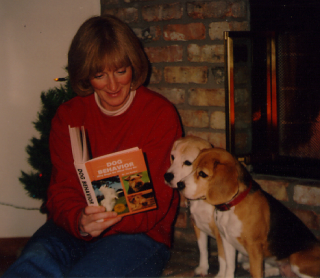
Sadly, the majority of puppies fail to live long enough to enjoy their second birthday. They suffer from the terminal illness of being unwanted — failing to live up to the expectation of the Lassie–Benji–Eddie dream. Instead they develop a number of extremely common and utterly predictable behavior, training, and temperament problems and are surrendered to animal shelters to play lotto with their lives. Many people blame irresponsible ownership for this tragic situation. I would simply cite lack of know-how. Most prospective puppy owners are simply unaware of the problems that lie ahead and unfortunately, they have little idea how to prevent or resolve them. Ironically, the demise of many dogs stems from novice owners following misleading, erroneous, and in some cases downright bad advice from out-of-date training books.
If you have your heart set on raising and training a puppy, do make sure you train yourself beforehand. Remember, it takes only a few days to ruin an otherwise perfect puppy. Without a doubt, the most important developmental deadline comes before you even think of getting your puppy — your education about puppy education!
Many first-time puppy owners are surprised when they discover their new companion bites, barks, chews, digs, and marks the house with urine and feces. Yet these are all perfectly normal, natural, and necessary doggy behaviors.
Your canine newcomer is just itching to learn human house manners. He wants to please, but he needs to be taught how to please. It's no good keeping house rules a secret. Somebody has to tell the puppy. And that somebody is you.
Puppy Pointers
Whether selecting your prospective pup from a professional breeder or from a family breeding a litter for the very first time, the criteria are the same. Look for puppies raised indoors around human companionship and influence — specifically around people who have devoted lots of time to the puppies' education.
Your puppy needs to be prepared for the clamor of everyday domestic living — the noise of the vacuum cleaner, pots and pans dropping in the kitchen, football games screaming on the television, children crying, and adults arguing. Exposure to such stimuli while his eyes and ears are still developing allows the puppy (with his blurred vision and muffled hearing) to gradually become accustomed to sights and sounds that might otherwise frighten him when older.
Avoid pups that have been raised in an outdoor run or kennel. Remember, you want a puppy to share your home, so look for a puppy that has been raised in a home. Basement- and kennel-raised puppies are certainly not pet-quality dogs. They are "livestock" on par with veal calves and battery hens. They are neither housetrained nor socialized, and they do not make good companions. Look for litters that have been born and raised in a kitchen or living room.
Choosing a breed is a very personal choice — your choice. But you will save yourself a lot of unnecessary problems and heartbreak if your choice is an informed and educated one. Choose the breed you like, investigate breed-specific qualities and problems, and then research the best way to raise and train your pup. Make sure you test-drive several adult dogs of your selected breed or type before you make your final choice. Test-driving adult dogs will quickly teach you everything you need to know about a specific breed. Test-driving adult dogs will also pinpoint gaps in your education about dog behavior and training.
Regardless of your choice, please do not kid yourself that you will get a "perfect" adult dog simply by selecting the "perfect" breed and the "perfect" individual puppy. Any puppy can become a marvelous companion if appropriately socialized and trained. And, no matter what the breed or breeding, any puppy can also become a doggy delinquent if not properly socialized and trained. Please make an intelligent, researched choice when selecting your puppy, but remember: appropriate socialization and training is the single biggest factor determining how closely the dog will approach your view of perfection in adulthood.
No matter your eventual choice — success or failure is entirely in your hands. Your puppy's behavior and temperament now depend completely on good husbandry and training.
Your puppy's living quarters need to be designed so that housetraining and chewtoy-training are errorless. Each mistake is a potential disaster, since it heralds many more to come.
Long-term confinement prevents your puppy from learning to make mistakes around the house, and allows your puppy to teach himself to use an appropriate toilet, to settle down quietly and calmly, and to want to chew appropriate chewtoys. Confinement with chewtoys stuffed with kibble and treats teaches your puppy to enjoy his own company and prepares him for those times when he might be left at home alone.
Short-term close confinement also prevents your puppy from learning to make mistakes around the house, while allowing your puppy to teach himself to settle down quietly and calmly, and to want to chew appropriate chewtoys. Additionally, short-term confinement enables you to accurately predict when your puppy needs to relieve herself, so that you may take your puppy to an appropriate toilet area and reward her for using it. The knack of successful housetraining focuses on being able to predict when your puppy "wants to go."
Without a doubt the most important developmental deadline comes before you even begin your search for a puppy: namely, your education about puppy education. Just as you would learn how to drive before setting off in a car, you should learn how to raise and train a puppy before you get one.
Some owners want heaven and earth from their pups; others only demand magic and miracles. Owners want the puppy to be perfectly well-behaved and to amuse herself when left at home alone for hours on end. And they assume the pup will magically grow up to act this way without guidance. It is simply not fair to keep house rules a secret from your puppy, only to moan and groan when she predictably finds doggy ways to entertain herself and break rules she didn't even know existed. If you have house rules, somebody needs to teach them to the puppy. And that somebody is you.
Luckily, dogs have their natural activity peaks at dawn and dusk, so many are quite happy to settle down and snooze the day away. However, some dogs are not. Some dogs are simply more active than others, and when left at home alone become exceedingly stressed and may destroy the house and garden in the space of a day.
Puppy owners are often surprised when their new puppy bites, barks, chews, digs, and decorates the floors with urine and feces. Yet this is what dogs do. How did you expect your dog to communicate? To moo? To meow? And what did you expect your dog to do to pass the time of day? Housework? To mop and clean floors and dust the furniture? Or to amuse herself reading books, watching television, or doing crosswords?
Many owners appear to be at a further loss when confronted by utterly predictable problems, such as jumping up, pulling on-leash, and expressing the boundless energy and exuberance accompanying doggy adolescence. Additionally, owners are incredulous if their adolescent or adult dog bites or fights. When dogs are undersocialized, harassed, abused, frightened, or otherwise upset, what do we expect them to do? Call a lawyer? Of course they bite! Biting is as normal an ingredient of canine behavior as wagging the tail or burying a bone.
Before inviting a puppy to share your life, surely it is only wise and fair to find out beforehand what you might expect from a normal developing puppy, which behaviors and traits you might consider unacceptable, and how to modify the pup's inappropriate behavior and temperament accordingly. Specifically, owners need to know how to teach the youngster when to bark, what to chew, where to dig, where to perform his toilet duties, to sit when greeting people, to walk calmly on-leash, to settle down and shush when requested, to inhibit his otherwise normal biting behavior, and to thoroughly enjoy the company of other dogs and of people, especially men, strangers, and children.
Adapted from BEFORE You Get Your Puppy by Dr. Ian Dunbar
Developmental Priorities
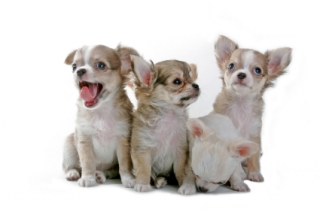
The most urgent priority is to continue socializing your puppy to a wide variety of people, especially children, men, and strangers. Well-socialized puppies grow up to be wonderful companions, whereas antisocial dogs are difficult, time-consuming, and potentially dangerous. Your puppy needs to learn to enjoy the company of all people and to enjoy being handled by all people, especially children and strangers.
The most important priority is that your puppy learns reliable bite inhibition and develops a soft mouth before he is eighteen weeks old. Whenever a dog bites a person or fights with another dog, the seriousness of the problem depends on the seriousness of the injury. Hence, the ease and success of retraining depends almost entirely on the dog's degree of bite inhibition. The reliability of your dog's bite inhibition determines whether you have a minor problem which may be easily corrected with a few safe, basic training exercises, or whether you have a serious and potentially dangerous problem which is going to be extremely difficult to resolve.
In a perfect world, you will successfully socialize your puppy so that he thoroughly enjoys the company and actions of all people, all dogs, and all animals. More realistically, though, accidents happen. Someone accidentally shuts the dog's tail in the car door. Someone runs to answer the telephone and accidentally treads on a sleeping dog's leg. A child runs and trips and falls on top of the dog while he is gnawing on a bone. When dogs are hurt or startled, their natural response is to snap, lunge, and even bite. Even wonderfully friendly dogs may feel inclined to protect or defend themselves when picked on by other dogs and people.
For example, when hurt or frightened a dog may snap and lunge at a person. But if a dog has well-established bite inhibition it is unlikely his teeth will even touch the skin. Or if there is skin contact, it is unlikely that the teeth will break the skin. The dog has caused no damage. On the other hand, if the dog has inadequate bite inhibition and his teeth puncture the skin, then you have a serious situation which may be difficult and time-consuming to resolve.
Similarly, dogs with well-established bite inhibition never cause damage when fighting with other dogs. The problem is minor because your dog is simply squabbling in a socially acceptable manner. On the other hand, if your dog ever hurts another dog or another animal, you have a major problem and resolution is unlikely.
Bite inhibition must be established in puppyhood, before eighteen weeks of age, since it is difficult to instill bite inhibition in an adolescent or adult dog. Learning the skills and techniques to ensure your puppy develops a reliable bite inhibition and an ultra-soft mouth is the primary reason for you to attend off-leash puppy classes. Your puppy needs to play with other puppies. Playing with adult dogs at home or in the park is simply not sufficient.
The most enjoyable priority of dog ownership is to accustom your well-socialized, soft-mouthed puppy to the world at large and prevent the development of predictable adolescent problems, thus assuring that he remains well-socialized and soft-mouthed. Remember, your dog will only remain sociable if he continues meeting and greeting unfamiliar people and unfamiliar dogs every day. Meeting the same people and dogs over and over is not sufficient. You want your dog to practice the art of meeting and getting along with strangers, not simply getting along with old friends. Consequently, regular walks with your dog are as essential as they are enjoyable.
Your life is about to change. You are about to enjoy all the joys of dog ownership — long, energetic, or relaxing walks, trips in the car, afternoons in the dog park, picnics on the beach, plus so many enjoyable organized doggy activities.
Here are your puppy priorities listed in order of urgency and ranked in terms of importance.
1. HOUSEHOLD ETIQUETTE - from the very first day your puppy comes home. Housetraining, chewtoy-training, and teaching your dog alternatives to recreational barking are by far the most pressing items on your puppy's educational agenda. From day one, employ errorless management teaching programs, comprising confinement schedules plus the liberal use of chewtoys (Kongs, Biscuit Balls, Squirrel Dudes, and sterilized longbones) stuffed with kibble. Simple behavior problems are so easily preventable, yet they are the most common reasons for people's dissatisfaction with their dogs and the most common reasons for dog euthanasia. Without a doubt, behavior problems are the #1 terminal illness for domestic dogs. Teaching household manners should be your number one priority the first day your puppy comes home. #1 Urgency Rating — Household etiquette is by far the most pressing item on your new puppy's educational agenda. If you want to avoid annoying behavior problems, training must begin the very first day your puppy comes home. #3 Importance Rating — Teaching household etiquette is extremely important. Puppies quickly become unwelcome when their owners allow them to develop housesoiling, chewing, barking, digging, and escaping problems.
2. HOME ALONE - during the first few days and weeks your puppy is at home. Sadly, the maddening pace of present-day domestic dogdom necessitates teaching your puppy how to enjoy spending time at home alone — not only to ensure your pup adheres to established household etiquette when unsupervised, but more importantly to prevent your puppy from becoming anxious in your absence. Normally, these go hand in hand because when puppies become anxious, they tend to bark, chew, dig, and urinate more frequently. From the outset, and especially during his first few days and weeks in your home, your puppy needs to be taught how to entertain himself quietly, calmly, and confidently. Otherwise he most certainly will become severely stressed when left at home alone. #2 Urgency Rating — Teaching your pup to confidently enjoy his own company is the second most urgent item on his educational agenda. It would be unfair to smother your puppy with attention and affection during his first days or weeks at home, only to subject the pup to solitary confinement when adults go back to work and children go back to school. During the first few days and weeks when you are around to monitor your puppy's behavior, teach him to enjoy quiet moments confined to his puppy playroom or doggy den. Especially be sure to provide some form of occupational therapy (stuffed chewtoys) for your puppy to busy himself and enjoyably pass the time while you are away. #4 Importance Rating — Preparing your puppy for time alone is extremely important both for your peace of mind (i.e., preventing housesoiling, chewing, and barking problems), and especially for your puppy's peace of mind. It is absolutely no fun for a pup to be over-dependent, stressed, and anxious.
3. SOCIALIZATION WITH PEOPLE - especially before twelve weeks of age but forever thereafter. Many puppy training programs focus on teaching your puppy to enjoy the company and actions of people. Well-socialized dogs are confident and friendly, rather than fearful and aggressive. Show all family members, visitors, and strangers how to get your puppy to come, sit, lie down, roll over, and enjoy being handled for pieces of kibble. Living with an undersocialized dog can be frustrating, difficult, and potentially dangerous. For undersocialized dogs, life is unbearably stressful. #3 Urgency Rating — Many people think that puppy classes are for socializing puppies with people. Not strictly true. Certainly puppy classes provide a convenient venue for socialized puppies to continue socializing with people. However, puppies must be well socialized toward people before they attend classes at twelve weeks of age. The time-window for socialization closes at three months of age, and so there is some urgency to adequately socialize your puppy to people. During your pup's first month at home, he needs to meet and interact positively with at least one hundred different people! #2 Importance Rating — Socializing your puppy to enjoy people is vital — second only in importance to your pup learning to inhibit the force of his bite and develop a soft mouth. Socialization must never end. Remember, your adolescent dog will begin to de-socialize unless he continues to meet unfamiliar people every day. Walk your dog or expand your own social life at home.
4. DOG-DOG SOCIALIZATION - between three months and eighteen weeks of age to establish reliable bite inhibition and forever after to maintain friendliness to other dogs. As soon as your puppy turns three months old, it is time to play catch up vis-a-vis dog-dog socialization, time for puppy classes, long walks, and visits to dog parks. Well-socialized dogs would rather play than bite or fight. And well-socialized dogs usually bite more gently, if ever they should bite or fight.#4 Urgency Rating — If you would like to have an adult dog who enjoys the company of other dogs, puppy classes and walks are essential, especially since many puppies have been sequestered indoors until they have been immunized against parvovirus and other serious doggy diseases (by the very earliest at three months of age).#6 Importance Rating — It is hard to rate the importance of dog-dog socialization. Depending on the lifestyle of the owners, dog-friendliness may be an unnecessary or an essential quality. If you would like to enjoy walks with your adult dog, early socialization in puppy classes and dog parks is essential. Surprisingly, though, very few people walk their dogs. Whereas large dogs and urban dogs tend to be walked quite frequently, small dogs and suburban dogs are seldom walked. Regardless of the desired sociability of your adult dog, dog-dog play and especially play-fighting and play-biting during puppyhood are absolutely essential for the development of bite inhibition and a soft mouth. For this reason alone, puppy classes and trips to the dog park are the top priority at three months of age.
5. SIT AND SETTLE DOWN COMMANDS - begin anytime you would like your puppydog to listen to you. If you teach your dog just a couple of commands, they would have to be Sit and Settle Down. Just think of all the mischievous things your puppydog cannot do when he is sitting. #5 Urgency Rating - Unlike socialization and bite inhibition which must occur during puppyhood, you may teach your dog to sit and settle down at any age, so there is no great urgency. However, because it is so easy and so much fun to teach young puppies, why not start teaching basic manners the very first day you bring your puppy home, or as early as four or five weeks if you are raising the litter? The only urgency to teach these simple and effective control commands would be if ever your puppy's antics or activity level begin to irritate you. Sit or Settle Down will solve most problems.#5 Importance Rating - It is difficult to rate the importance of basic manners. Personally, I like dogs that can enjoy being dogs without being a bother to other people. On the other hand, many people happily live with dogs without any formal training whatsoever. If you consider your dog to be perfect for you, make your own choice. But if you or other people find your dog's behavior to be annoying, why not teach him how to behave? Indeed, a simple sit prevents the majority of annoying behavior problems, including jumping-up, dashing through doorways, running away, bothering people, chasing his tail, chasing the cat, etc., etc. The list is long! It is so much easier to teach your dog how to act appropriately from the outset, i.e., to teach the one right way (e.g., to sit), rather than trying to punish the dog for the many things that you think he does wrong. Regardless, it would be unfair to get on your dog's case for bad manners if he is only breaking your rules that he didn't even know existed.
6. BITE INHIBITION - by eighteen weeks of age. A soft mouth is the single most important quality for any dog. Hopefully, your dog will never bite or fight, but if he does, well-established bite inhibition ensures that your dog causes little if any damage. Socialization is an ongoing process of ever-widening experience and confidence building that helps your pup to comfortably handle the challenges and changes of everyday adult life. However, it is impossible to prepare your puppy for every possible eventuality, and on those rare occasions when adult dogs are badly hurt, frightened, scared, or upset, they seldom call a lawyer or write letters of complaint. Instead, dogs customarily growl and bite, whereupon the level of bite-inhibition-training from puppyhood predetermines the seriousness of the damage. Adult dogs with poor bite inhibition rarely mouth and seldom bite, but when they do, the bites almost always break the skin. Adult dogs with well-established bite inhibition often mouth during play, and should they bite, the bites almost never break the skin because during puppyhood the dog learned how to register a complaint without inflicting any damage.Bite inhibition is one of the most misunderstood aspects of behavioral development in dogs (and other animals). Many owners make the catastrophic mistake of stopping their puppy from mouthing altogether. If a puppy is not allowed to play-bite, he cannot develop reliable bite inhibition. Pups are born virtual biting machines with needle sharp teeth for one reason only — so that they learn their bites hurt before they develop the jaw strength to cause appreciable harm. However, they cannot learn to inhibit the force of their bites if they are never allowed to play-bite and play-fight. Bite inhibition training comprises first teaching the puppy to progressively inhibit the force of his bites until painful puppy play-biting is toned down and transformed into gentle puppy mouthing, and then, and only then, teaching him to progressively inhibit the incidence of his mouthing. Thus the puppy learns that any pressured bite is absolutely unacceptable and that mouthing is by and large inappropriate.#6 Urgency Rating - You have until your puppy is four and a half months old, so take your time to ensure your puppy masters this most important item in his educational curriculum. The more times your puppy bites in play, the safer his jaws will be as an adult since he has had more opportunities to learn that biting hurts. If you are at all worried about your puppy's biting behavior, seek further advice from a Certified Pet Dog Trainer (CPDT) and enroll in a puppy class immediately, so that your puppy may redirect many of his bites towards other puppies during play sessions and so develop stellar bite inhibition.#1 Importance Rating - Bite inhibition is of crucial importance and by far the single most important quality of any dog, or any animal. Living with a dog that does not have reliable bite inhibition is unpleasant and dangerous. Bite inhibition must be acquired during puppyhood. You must fully understand how to teach your puppy bite inhibition. Attempting to teach bite inhibition to an adolescent or adult dog is often extremely difficult, dangerous, and time-consuming.
Adapted from BEFORE You Get Your Puppy by Dr. Ian Dunbar
Choosing Your Puppy
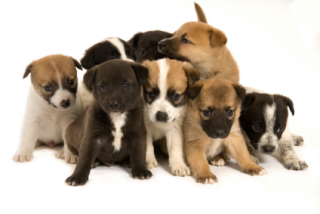
Choosing a puppy is a very important decision, and everyone who lives in the household should agree before any puppy is brought into the home. If the puppy is to truly become a member of the family, then all family members will need to be involved in training. Before you choose your puppy (usually at eight weeks of age), you need to know:
· How to evaluate and select a good breeder
· How to evaluate and select a good puppy and specifically, how to assess your puppy's behavioral development.
Also, you must keep in mind that there are no perfect puppies. In this chapter we recommend giving careful consideration to where, when and how you choose your puppy, but please remember, any puppy you pick will need to be trained if you want to live with a well-behaved, friendly and mannerly dog.
In preparation for household living, the litter of puppies must have been raised indoors and around people and not in some secluded backyard or fancy kennel. If raised in kennel-isolation, your prospective puppy's social and mental development is already likely to be severely retarded and sadly, you will be playing catch-up for the rest of her life. Your puppy will require remedial socialization and training for a long time to come.
By eight weeks of age:
· Your puppy should already have been handled by many people, especially men, children, and strangers
· Your puppy must have become thoroughly accustomed to a home physical environment, especially to all sorts of potentially scary noises
· Your puppy's errorless housetraining and chewtoy-training should be underway
· Your puppy should already have a rudimentary understanding of basic manners. At the very least, your puppy should come, sit, lie down, and roll over when requested.
Make absolutely certain the puppies have been raised indoors in close contact with people who have devoted lots of time to their education.
If a dog is expected to live in a household with people, obviously she needs to have been raised in a household with people. Your puppy needs to be prepared for the clamor of everyday domestic living: the noise of the vacuum cleaner, pots and pans dropping in the kitchen, football games screaming on the television, children crying, and adults arguing. Exposure to such stimuli while her eyes and ears are still developing allows the puppy (with her blurred vision and muffled hearing) to gradually become accustomed to sights and sounds that might otherwise frighten her when older.
There is not much point in choosing a puppy that has been raised in the relative social isolation of a backyard kennel, basement, barn, or garage, where there is precious little opportunity for interaction with people and where a puppy has become accustomed to soiling her living area and yapping a lot. Puppies raised in physical seclusion and partial social isolation are hardly prepared for household living, and they are certainly not prepared for encounters with children or men. Backyard- and kennel-raised puppies are certainly not pet-quality dogs; they are livestock on par with veal calves and battery hens. Look elsewhere! Look for litters born and raised indoors — in a kitchen or living room.
If you want a companion dog to share your home, she obviously should have been raised in a home, not in a cage or a kennel.
An essential ingredient of puppy husbandry is regular (several times a day) handling, gentling, and calming by a wide variety of people, especially children, men, and strangers. These exercises are especially important during the early weeks and especially with those breeds that are notoriously tricky when handled by strangers — that is, several Asian breeds, plus many herding, working, toy and terrier breeds — in other words, most breeds of dog!
It is so important that dogs enjoy interacting with people and being hugged and handled, especially by children, men, and strangers. Early socialization easily prevents serious adult problems.
If you want a cuddly adult dog, he needs to have been cuddled regularly as a puppy. Certainly, neonatal pups are pretty fragile and helpless critters; they can barely walk and they have a number of sensory constraints. But they still need to be socialized. Neonatal pups are extremely sensitive and impressionable, and this is the very best time to accustom them to being handled. Neonatal puppies may not see or hear very well, but they can smell and feel. Of course, neonatal and early puppy socialization, being of paramount importance, must be done gently and carefully.
The puppy should be fully desensitized to sounds before he is four weeks old. Likewise, his housetraining program should be well underway, his favorite toy should be a chewtoy (stuffed with puppy chow), and he should happily and eagerly come, follow, sit, lie down, and roll over when requested. If these are not so, either your puppy is a slow learner or he has had a poor teacher. In either case, look elsewhere.
If You Really Want a Challenge
If you really want to set yourself a housetraining challenge, buy a three-month-old puppy from a kennel or pet store window littered with shredded paper and straw with no specific toilet area. This puppy has been trained to eliminate anywhere, anytime. And that's exactly what she will do when you get her home. You'll be cleaning up urine and feces for a very long time!
Adapted from BEFORE You Get Your Puppy by Dr. Ian Dunbar
Which Type of Dog?
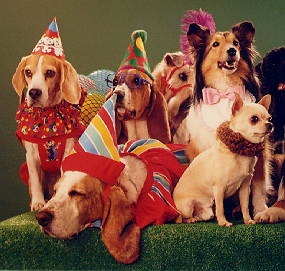
There are many considerations when choosing a puppy, including which breed or type, and the optimal age of acquisition. Obviously, you want to choose a dog that is best suited to you and your lifestyle. Rather than listing my preferences, I will discuss some of the more important guidelines.
First, please do not kid yourself that all you have to do is select the "perfect" breed and the "perfect" individual puppy and he will automatically grow up into the "perfect" adult dog. Any puppy can become a marvelous companion if appropriately socialized and trained. And, no matter what his breed or breeding, any puppy can become a doggy delinquent if not properly socialized and trained. Please make an intelligent, researched choice when selecting your puppy, but remember: appropriate socialization and training is the single biggest factor determining how closely the dog will approach your view of perfection in adulthood.
Second, seek advice from the best sources. Common mistakes are to take breed advice from veterinarians, health advice from breeders, and all-important behavior and training advice from veterinarians, breeders, and pet-store personnel. The best plan is to seek training and behavior advice from trainers and behavior counselors, health advice from veterinarians, breed advice from breeders, and product advice from pet-store personnel. And if you really want to know what's going on, check out a local puppy class and chat with the owners; they'll give you the cold, hard facts regarding what it's really like to live with a puppy.
Third, seek advice from several sources and evaluate all advice carefully. Apply the common sense principle: does it make sense to you? Is the advice relevant to your family and your lifestyle? Whereas most advice is sound, some can be irrelevant, hypocritical, preachy or questionable. And occasionally, "advice" can be just downright bad.
Example 1: One breeder told a couple they could not buy a puppy unless they had a fenced yard and one of them was home all day. Yet the breeder herself had no fenced yard and her twenty or so dogs lived in crates in a kennel a good forty yards away from her house and any hope of human companionship. Duh!?!
Example 2: Many people are advised not to get a large dog if they live in an apartment. On the contrary! As long as they receive regular walks, large dogs make wonderful apartment companions. Compared with smaller dogs, large dogs often settle down better and bark less. Many little dogs exasperate owners and neighbors by being active and noisy, and running amuck and treating apartment furniture like an agility course. Smaller dogs make wonderful apartment companions, however, so long as they are trained to settle down and shush.
Example 3: Many veterinarians advise that Golden Retrievers and Labrador Retrievers are the best dogs with children. All breeds of dog can make good companions for children, provided that they have been trained how to act around children, and provided that the children have been taught how to act around dogs! Otherwise, all dogs — including Goldens and Labs — are likely to be frightened and irritated by children, or excited and incited by their antics.
Remember, you are selecting a puppy to live with you for a good long time. Choosing a puppy to share your life is a very personal choice — your choice. You will save yourself a lot of unnecessary problems and heartbreak if your choice is an informed and educated one.
In reality, though, people seldom pay heed to well-meaning advice and usually end up choosing with heart instead of head. Indeed, many people end up choosing a dog along the same lines as they might choose a lifelong human companion: based on coat color, conformation, and cuteness. But regardless of the many reasons for selecting a particular puppy — whether pedigree, conformation, cuteness, or general health — the success of the endeavor ultimately depends almost entirely on the pup's education regarding appropriate behavior and training.
Adapted from BEFORE You Get Your Puppy by Dr. Ian Dunbar
Another great way to find the dog of your dreams is to use the Dogtime matchup.
Mixed Breed or Pure Breed?
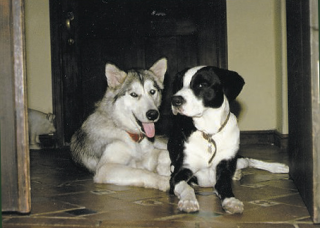
This decision is a personal choice that only you can make. The most obvious difference is that pure breeds are more predictable in terms of looks and behavior, whereas each mixed breed is utterly unique — one of a kind.
Regardless of your personal preference for attractiveness, attentiveness, and activity, you would do well to consider general health and life expectancy. By and large, due to lack of inbreeding, mixed breeds are healthier genetic stock; they tend to live longer and have fewer health problems. On the other hand, at a pure-breed kennel, it is possible to check out the friendliness, basic manners, general health, and life expectancy of several generations of your prospective puppy's forebears.
Which Breed?
A Border Collie or a French Bulldog? A Golden Retriever or a Belgian Malinois? I am strongly opposed to suggesting breeds for people. Recommending specific breeds may sound like helpful and harmless advice, but it is insidiously dangerous and not in the best interests of dogs or of dog-owning families. Advice either for or against specific breeds often leads owners to believe that training is either unnecessary or impossible. Thus many poor dogs grow up without an education.
Breed recommendations often lead unsuspecting owners to believe that once they have selected the right breed, there is nothing more to do. Thinking they have the best possible breed, many owners suffer the misconception that training is unnecessary and so don't bother. This, of course, is when things start to go downhill.
Even more disturbing, when certain breeds are recommended, other breeds are automatically being advised against. "Experts" often suggest that certain breeds are too big, too small, too active, too lethargic, too fast, too slow, too smart, or too dumb, and therefore too difficult to train. Well, we know that regardless of helpful "advice," people are probably going to pick the breed they wanted in the first place. But now they may feel disinclined to train the puppy, feeling that the process is going to be difficult and time consuming. Furthermore, owners may rationalize their negligence by citing any one of the pack of convenient excuses listed above.
Some people like to rank order breeds in terms of supposed relative intelligence, citing Border Collies and Golden Retrievers as being smart and Bassett Hounds, Coonhounds, Irish Wolfhounds and Afghan Hounds as being not so smart. Certainly, analyzing differential responses to cognitive tests and puzzles is interesting, but generalizing about breed intelligence can have sad repercussions. For example, a Border Collie owner didn’t bother training their puppy because they thought it was so smart that training was unnecessary. And an Afghan Hound owner didn’t bother training their puppy because they thought it lacked smarts and that training would be impossible.
Breed is a very personal choice. Choose the breed you like, investigate breed-specific qualities and problems, and then research the best way to raise and train your pup. If you select what others consider an easy breed to raise and train, train your pup so that he becomes the very best individual — an ambassador — of that breed. And if you select a breed that some people consider difficult to raise and train, train him, train him, and train him, so that he becomes the very best example — an ambassador — of that breed.
Regardless of your eventual choice, and certainly once you have made it, success or failure is now entirely in your hands. Your puppy's behavior and temperament now depend completely on good husbandry and training.
When evaluating different breeds, the good points are obvious. What you need to find out are the breed's bad points. You need to investigate potential breed-specific (or line-specific) problems and to know how to deal with them. If you want to find out more about a specific breed, find at least six adult dogs of the breed you have selected and talk to their owners at length, but most importantly, meet the dogs! Examine and handle them; play with them and work them. See if the dogs welcome being petted by a stranger — you. Will they sit? Do they walk nicely on leash? Are they quiet or noisy? Are they calm and collected, or are they hyperactive and rambunctious? Can you examine their ears, eyes, and rear end? Can you open their muzzle? Can you get them to roll over? Are the owners' houses and gardens still in good condition? And most important, do the dogs like people and other dogs?
Learn what to expect, because when your eight-week-old puppy comes home, he will grow up with frightening speed. Indeed, in just four month’s time, your pup will develop into a six-month-old adolescent that has gained almost adult size, strength, and speed, while at the same time retaining many puppy constraints on learning. Your puppy has so much to learn before he collides with impending adolescence.
In terms of personality, behavior, and temperament, please be aware that dogs of the same breed may show considerable variation. If you have siblings or more than one child you probably appreciate the incredible range of temperaments and personalities of children from the same parents. Dogs are similar. Indeed, there may be as much variation of behavior among individuals of the same litter as there is among dogs of different breeds.
Environmental influences (socialization and training) exert a far greater impact on desired domestic behavior and temperament than genetic heredity. For example, the temperamental differences between a good (educated) Alaskan Malamute and a bad (uneducated) Alaskan Malamute or between a good Golden Retriever and a bad Golden Retriever are much greater than temperamental differences between a Golden and a Malamute with an equivalent experiential and educational history. A dog's education is always the biggest factor determining his future behavior and temperament.
Please make sure you fully understand the above paragraph. I am not saying training necessarily has a greater effect on dog behavior than genetic heredity. Rather, I am stating quite categorically that attaining a desired domestic dog behavior is almost entirely dependent on socialization and training. For example, dogs bark, bite, urine mark, and wag their tails largely for genetic reasons — because they are dogs. The frequency of their barks, however, the severity of their bites, the location of their urine marks, and the enthusiasm of their tail wags depends pretty much on the nature of their socialization and training. Your dog's domestic success is in your hands.
Movie DogStars
EddieWhen selecting a breed, don't be duped by celebrity dogs appearing in films or on television. These dogs are highly trained canine actors. In fact, Lassie has been played by at least eight different canine actors. The dogs are acting, and often the requirements of their role mask their true breed and individual characteristics. This is no different from Anthony Hopkins playing Hannibal Lecter in The Silence of the Lambs and C. S. Lewis in Shadowlands — two very different roles, and both of them completely different from what we may suppose is the real Anthony Hopkins. It's acting, and in a sense you need to teach your puppy how to act — that is, how to act appropriately in a variety of domestic settings, such as the living room and the park.
Eddie (Moose) appears to be calm and controlled on the set of Frasier, because "Moose the Active" was trained to be calm and controlled to play the role of Eddie. Moreover, Eddie's endearing television demeanor and his acquired social savvy, charming manners, and acting skills have successfully overcome his original delinquent disposition. Why not hear about the real Moose from Eddie’s trainer, Mathilde DeCagny?
Adapted from BEFORE You Get Your Puppy by Dr. Ian Dunbar
Another way to find the right dog for you is to use the Dogtime matchup.
When to Get a Puppy
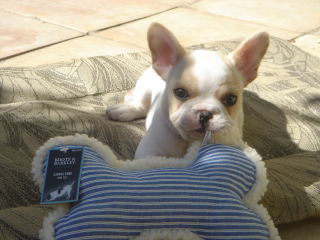
Aside from the obvious answer — not before you are ready — the time to get a dog is when you have completed your doggy education. And when the pup is ready.
An important consideration is the age of the pup. Most puppies change homes at some time in their life, usually from the home where they were born to the homes of their new human companions. The optimal time for a puppy to change homes depends on many variables, including his emotional needs, his all-important socialization schedule, and the level of doggy expertise in each household.
Leaving home can be traumatic, and limiting the pup's emotional trauma is a prime consideration. If the puppy leaves home too early, he will miss out on early pup-pup and pup-mother interactions. And since the first weeks in a new home are often spent in a doggy social vacuum, the developing puppy may grow up undersocialized toward his own kind. On the other hand, the longer the puppy stays in his original home the more attached he becomes to his doggy family and the harder the eventual transition. A delayed transition also postpones all-important socialization with the new family.
Eight weeks of age has long been accepted as the optimal time to acquire a new pup. By eight weeks, sufficient dog-dog socialization has taken place with mother and littermates to tide the puppy over until he is old enough to safely meet and play with other dogs in puppy class and dog parks. Yet the puppy is still young enough to form a strong bond with the human and canine members of his new family.
The relative level of doggy expertise in each home is a vital consideration in determining whether the puppy is better off staying longer in his original home or leaving earlier to live with his new owners. It is often assumed that breeders are experts and owners are rank novices, so that it makes sense to leave the pup with the breeder as long as possible. A conscientious breeder is usually better qualified to socialize, housetrain, and chewtoy-train the puppy. When this is true, it makes sense to get the puppy when he is older. (In fact, I often ask novice owners whether they have considered a socially mature and well-trained adult dog as an alternative to a young pup.)
This of course presupposes the breeder's superior expertise. Unfortunately, just as there are excellent, average, novice, and irresponsible owners, there are also excellent, average, novice, and irresponsible breeders. With the combination of an experienced owner and a less-than-average breeder, the puppy would be better off moving to his new home as early as possible, certainly by six to eight weeks at the latest. If you feel you are a qualified puppy raiser but the breeder will not let you take your pup home before eight weeks of age, look elsewhere. Remember, you are searching for a puppy to live with you, not with the breeder. In fact, you might be better off looking elsewhere anyway, since a less-than-average breeder probably produces less-than-average puppies.
Adapted from BEFORE You Get Your Puppy by Dr. Ian Dunbar
Where to Get a Puppy
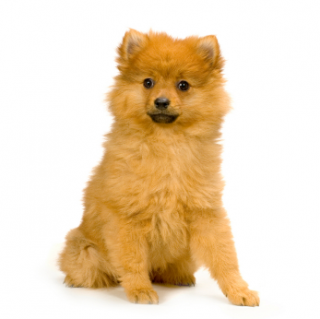
Whether selecting your prospective pup from a professional breeder or from a family breeding a litter for the very first time, the criteria are the same.
First, look for puppies raised indoors around human companionship and influence. Avoid pups raised in an outdoor run or kennel. Remember, you want a puppy to share your home, and so look for a puppy that has been raised in a home. See Choosing Your Puppy: How To Select A Good Breeder
Second, assess your prospective puppy's current socialization and education status. Regardless of breed, breeding, pedigree, and lineage, if your prospective puppy's socialization and training programs are not underway well before eight weeks of age, he is already developmentally retarded.
Adapted from BEFORE You Get Your Puppy by Dr. Ian Dunbar
Puppy vs. Adult
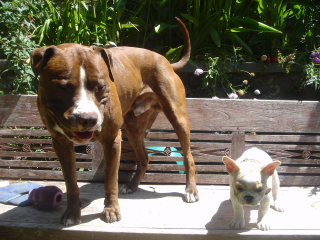
Before rushing ahead and getting a puppy, it's a good idea to at least consider the pros and cons of adopting an adult dog. There are certainly several advantages to getting a pup, the foremost being you may mold the puppy's behavior and temperament to suit your own particular lifestyle. This, of course, presumes you know how to train and have the time to do it. Sometimes you might not. And so in a lot of ways an adolescent or adult dog with a Kennel Club obedience title and a Canine Good Citizenship Test may make a more suitable companion — especially for a two-income family whose members barely have the time to get together as a family themselves.
Additionally, a two-year-old (or older) adult dog's habits, manners, and temperament are already well established, for better or for worse. Traits and habits may change over time, but compared with the behavioral flexibility of young puppies, an older dog's good habits are as resistant to change as their bad habits. Consequently, it is possible to test drive a number of adult shelter dogs and select one free of problems and with an established personality to your liking.
Adopting an adult dog from an animal shelter or rescue organization can be a marvelous alternative to raising a puppy. Some shelter and rescue dogs are well-trained and simply need a home. Others have a few behavior problems and require remedial puppy education in adulthood. However, other dogs have significant problems, such as generalized fearfulness, that will require months and months of dedicated rehabilitation. Some dogs are purebred; most are mixed breeds. The key to finding a good shelter or rescue dog is selection, selection, selection! Take plenty of time to test drive each prospective candidate. Each dog is unique.
If you still have your heart set on raising and training a puppy, do make sure you educate yourself beforehand. Only search for a puppy after you have learned how to raise and train one. Remember, it takes only a few weeks to ruin an otherwise perfect puppy.
Please ask yourself, “Where do shelter dogs come from?” All shelter dogs were once perfect puppies that were abandoned or surrendered because they developed annoying behavior, training, and temperament problems, simply because their owners did not know how to train them.
The sequence of events is utterly predictable: too much initial freedom and too little supervision and education all but teach a newly acquired puppy to chew household articles and eliminate in the house. In the owner’s attempt to manage these common and foreseeable problems, the puppy is relegated outdoors, where he quickly becomes de-socialized and develops other annoying habits, such as barking, digging, and escaping. After spending day after day in social isolation, the puppy is so excited when asked indoors that he enthusiastically runs around, barks, and jumps up to greet his long-lost human companions. Soon, the overly rambunctious pup is no longer allowed indoors at all. Either he is captured by animal control after he escapes from solitary confinement, or neighbors complain about his excessive barking and he is confined to the garage or basement — usually only a temporary measure before the now unwanted adolescent dog is abandoned or surrendered to a shelter. And he is barely six months old.
All behavior, temperament, and training problems are so utterly predictable, and so easily preventable. Even most existing problems may be resolved fairly easily. Education is the key.
Adapted from BEFORE You Get Your Puppy by Dr. Ian Dunbar
A good place to search for the right dog for you is the Dogtime matchup.
How to Select a Good Breeder
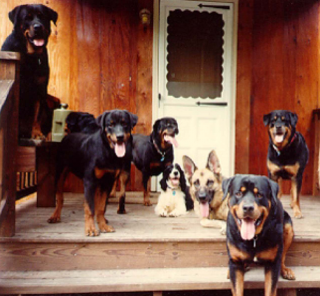
A good breeder will be extremely choosy in accepting prospective puppy buyers. A prospective owner should be equally choosy when selecting a breeder. A prospective owner can begin to evaluate a breeder's expertise by noting whether she ranks the puppies' mental well-being and physical health above their good looks. Assess several factors:
· whether your prospective puppy's parents, grandparents, great-grandparents, and other relations live to a ripe old age
· whether the breeder's adult dogs are all people-friendly and well-trained
· whether your prospective pup is already well-socialized and well-trained, i.e., evaluate the breeder’s socialization and training program.
Basically, this breeder is under the impression the dog is so dumb he can not tell the difference between two simple instructions such as "Sit" and "Stand." Look elsewhere. Just because the breeder is prepared to live with dogs that haven't even been taught to sit does not mean to say you should! Also, if the puppy hasn't even been taught basic manners, there are probably many other things the breeder has failed to teach.
Longevity
The single best indicator of general health, good behavior, and temperament is the overall life expectancy of a kennel line. Long-lived dogs advertise good temperament and training, since dogs with behavior and temperament problems generally have short life expectancies. Check to see that your prospective puppy's parents, grandparents, great-grandparents, and other relations are still alive and healthy, or that they died at a ripe old age. Conscientious breeders will have telephone numbers readily available of previous puppy buyers and of the breeders of the other dogs in your prospective puppy's pedigree. If the breeder is not eager to share information regarding life expectancy and the incidence of breed-specific diseases, look elsewhere. You will eventually find a breeder who will accommodate your concerns. Before you open your heart to a young pup, you certainly want to maximize the likelihood that the two of you will be spending a long and healthy life together.
Meet The Parents
Meet and test-drive as many of your prospective puppy's adult relatives as possible. Friendly dogs are self-apparent when you meet them. Friendly dogs are living proof of good socialization by a good breeder.
Beware the breeder who is only willing to show you puppies.
A good breeder will take the time to see how you get along with adult dogs before letting you anywhere near the pups.
A good breeder wouldn't let you leave with a puppy if you didn't know how to handle an adult dog, which your puppy will be in just a few months. Make sure the breeder teaches you how to handle and train her adult dogs.
You want to evaluate as many adult dogs as possible from your prospective puppy's family and line before you let a litter of super-cute puppies steal your heart. If all the adult dogs are people-friendly, well behaved and well trained, it is a good bet that you have discovered an exceptional breeder with exceptional dogs.
Assess Socialization & Training Program
Observe: Are the puppies being raised indoors?
Is there a specific doggy toilet in the puppies' living area?
How many piles and puddles are in the toilet versus on the floor? This will offer a good indication of where the puppy will eliminate if she comes to your home.
How many hollow chewtoys (such as Kongs, Biscuit Balls, Squirrel Dudes, or sterilized bones) stuffed with kibble and treats can you see in the puppies’ play area?
Ask the breeder:
To demonstrate the puppies' basic obedience skills, for example, to come, sit, lie down, and roll over
How many people have handled and gentled the pups daily?
How many children, men, and strangers have trained, and played with the pups daily?
Have the pups been exposed to loud and unexpected noises, such as adults shouting, children crying, television (male voices shouting and screaming on ESPN), radio, and music (Country, Rock, and Classical—maybe Tchaikovsky's 1812 Overture)?
For a progress report on the litter's ongoing errorless housetraining and chewtoy-training program.
Remember: You are choosing a pup to come and live in your home and adapt to your lifestyle, so please make sure the puppy has been prepared for domestic life in general and is suitable for your lifestyle in particular.
Beware of statements like:
"We haven't taught the puppies to sit because they are showdogs." or "He's the scaredy-cat of the litter."
Certainly in any litter individual dogs will display different tendencies toward approaching strangers (you), but no eight-week-old puppy should be scared to approach people. Any shyness, fearfulness, or tendency to avoid people should have been noticed and dealt with as early as four weeks ago. The shy puppy should have been supersocialized. A single scaredy-cat puppy in a litter indicates that the breeder has not been vigilant in assessing day-to-day socialization. There are most probably other good puppies in the litter, but I suggest that you be vigilant when assessing their socialization status.
Adapted from BEFORE You Get Your Puppy by Dr. Ian Dunbar
How to Select a Good Puppy
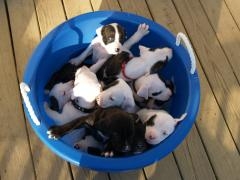
When choosing the puppy, it is so important that all family members agree. You want to select the puppy you all like best, and you want to select a puppy that likes all of you. Sit down quietly as a family and see which puppies make contact first and which ones stay around the longest.
You want to select a puppy that likes you and enjoys being hugged and handled (restrained and examined). You want to select a puppy who is socialized, confident, housetrained, chewtoy-trained, and obedience trained.
Social Attraction
For years it was dogmatically stated that puppies that approached quickly, jumped-up, and bit your hands were totally unsuitable as pets, since they were aggressive and difficult to train. On the contrary, these are normal, well-socialized, eight-week-old puppies, which are simply saying hello in true puppy fashion without the benefit of manners. With some very basic training to redirect the pup's delightful exuberance, you'll have the fastest recalls and the quickest sits in puppy class. Also, puppy biting is both normal and absolutely necessary. In fact the more dogs bite as puppies, the softer and safer their jaws in adulthood.
I would be more concerned about puppies that were slow to approach or remained in hiding. It is completely, utterly, and absolutely abnormal for a well-socialized six- to eight-week-old puppy to be shy when approaching people. If the puppy acts shy or scared, then without a doubt he has not been sufficiently socialized. Look elsewhere. If, however, you really have your heart set on taking a shy puppy, only do so if each family member can coax the pup to approach and take a food treat. A shy puppy represents a substantial time commitment, since he will need to be hand-fed kibble every day from a variety of strangers. To rehabilitate this pup, you'll certainly have your work cut out for you during the next four weeks.
Make sure the puppy quickly and happily approaches all family members.
Handling and Gentling
Your prospective puppy should feel thoroughly at ease being handled by strangers — you and your family. Handle each puppy to see how he enjoys being cuddled (gently restrained) and stroked and massaged (examined) around his neck, muzzle, ears, paws, belly, and rear end. Your puppy should relax like a rag doll. If the puppy struggles, see how long it takes for the pup to calm down.
Make sure all family members handle the puppy.
Sound Sensitivity
Exposure to a variety of sounds should commence well before the eyes and ears are fully opened, especially with sound-sensitive dogs, such as herding and obedience breeds. It is quite normal for puppies to react to noises. What you are trying to evaluate is the extent of each pup's reaction and the pup’s bounce-back time. For example, we expect a puppy to react to a sudden and unexpected loud noise, but we do not expect him to go to pieces. Judge whether the puppy reacts or overreacts to sounds, and time how long it takes for the puppy to approach and take a food treat (the bounce-back time). Expect immeasurably short bounce-back times from bull breeds, and short bounce-backs from working dogs and terriers, but be prepared for longer bounce-back times from toys and herding breeds. Regardless of a dog's breed or type, however, excessive overreaction, panic, or extremely lengthy bounce-back times are all proof of insufficient socialization. Unless successfully rehabilitated, such pups may become extremely reactive when they grow up.
Evaluate the puppies' response to a variety of noises: people talking, laughing, crying, and shouting, a whistle, a hiss, or a single hand clap.
Household Etiquette
If the puppies have no available toilet and the entire puppy area has been covered with sheets of newspaper, the puppies will have developed a strong preference for going on paper and will need specialized housetraining in their new home. Moreover, if there is no toilet and the entire area has been littered with straw or shredded paper, the puppies will have learned they may eliminate anywhere and everywhere, which is what they will do in your home. The longer the puppy has been raised in these conditions, the more difficult she will be to housetrain.
Try to observe the litter for at least two hours and pay attention to where each puppy eliminates and what each puppy chews.
Basic Manners
Evaluate each puppy's response to your lure/reward training attempts using pieces of kibble or chewtoys as lures and rewards. Make sure each family member trains the puppy to come, sit, lie down, stand and rollover.
Singleton Puppies
Most pups have adequate opportunity to play with their littermates during their first eight weeks. Singleton and hand-reared pups have had insufficient opportunity to play (play-fight and play-bite) and therefore teaching bite inhibition is a top priority. If you select a singleton puppy, make sure you enroll in a puppy classes as soon as your puppy reaches three months of age. Play and socialization are essential for puppies to develop and maintain a soft mouth.
Adapted from BEFORE You Get Your Puppy by Dr. Ian Dunbar
Shopping List For a New Puppy
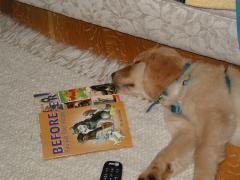
Once you have completed your doggy education, it is time to shop for your prospective puppy. Many training books, pet stores, and dog catalogs display an awesome and confusing array of doggy products and training equipment. Consequently, I have listed a number of essentials with personal preferences in parentheses. 1. Books and DVDs about puppy behavior and training (instructions for use) 2. Dog crate (Vari Kennel), and maybe an exercise pen or baby gate barrier 3. At least six chewtoys to stuff with kibble and treats (The Kong Company’s Kong and Biscuit Ball, Premier’s Squirrel Dude and Football, and sterilized long bones are the best.) 4. Doggy toilet (Construct your own — turf in a litter pan) 5. Water bowl (Only buy your pup a food bowl once he is socialized, well-trained, and has impeccable household manners.) 6. Dog food (dry kibble) During his first weeks at home, make sure your puppy receives all food stuffed in chewtoys, or handfed as rewards for socialization and training. 7. Freeze-dried liver for men, strangers, and children to win your puppy's confidence and as rewards for housetraining 8. Edible Chewies 9. Interactive Toys 10. Plush (squeaky) Toys 11. Martingale collar, leash, and maybe a Gentle Leader (Premier Pet Products)
Ch 2: Raising A Puppy
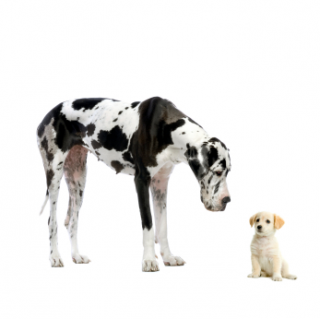
From the very first day your puppy comes home the clock is ticking. All aspects of puppy training and behavior modification will only get harder as time goes by, so don’t wait, start training today!
The first item on the agenda is errorless housetraining and chewtoy-training. You can’t expect your new pup to magically know where to pee and poop, what to chew, or when to bark. Instead, you need to teach her. Additionally, you will need to teach your pup that these rules still apply when she is home alone, and that there’s no need to be anxious in your absence. All of this is easy with a doggy den and puppy playpen: short- and long-term confinement areas for your puppy that will help her learn to have free reign of the house.
It is essential to teach your pup to like people and to enjoy being handled. If you don’t actively socialize your puppy to numerous unfamiliar people, she will most certainly develop fears about strangers, especially men and children. These fears can escalate into defensive and aggressive behavior, and a generally unhappy and stressed dog.
As your pup grows older, you must remember to continue socialization outside the home, certainly in puppy classes where your pup can learn to play appropriately with other pups and develop bite inhibition, but also you should strive to incorporate positive training into all aspects of your dog’s life. By training on your walks, in the car and at the park, you will raise a dog who is confident and relaxed in all situations.
Want to raise the perfect puppy?
Learn more about puppy training with The Best Online Puppy Training Programs:
The Top Dog Academy. Learn how to deal with puppy biting, crate training, toilet training, socialization and more with videos, worksheets and podcasts about puppy training. When you join the Top Dog Academy you also get access to personalized email support so you can train your puppy yourself. Use this link to get your first month for free.
SIRIUS Puppy Training. Looking for more support? Get personalized, real-time, video dog training guidance from an expert SIRIUS Puppy Training instructor. Dr. Dunbar's SIRIUS Puppy & Dog Training classes revolutionized the world of pet dogs when they were first created. Now, our online small-group classes allow you to get the expert assistance you need from the comfort of your home.
Puppy's First Week at Home (8-9 weeks)
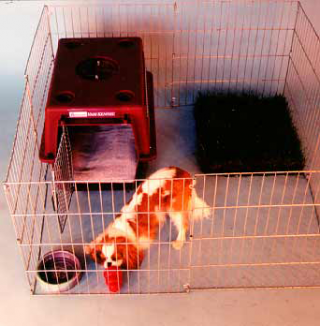
Start housetraining your pup the moment he comes home. It is important, and surprisingly easy, to train your puppy without him making a single toilet or chewing mistake. Each mistake will make training considerably more difficult. Puppies quickly establish toilet habits and even a single mistake heralds many more in the future. Also, punishing puppies for soiling the house or making chewing mistakes inadvertently teaches them to soil the house or chew on shoes while their owners are away (and therefore, cannot punish). Remember, good habits are just as hard to break as bad habits and so, housetrain your puppy from the outset.
Confinement is the secret to errorless housetraining — using a doggy den and a puppy playroom) to make sure your unsupervised puppy will not make any mistakes. The whole point of confining puppies while they are young is so that they will be able to have as much freedom as possible when they are older. Alternatively, if you let your new puppy roam free and form bad house-habits, you will no doubt confine him as an adult. Also, of course, make sure you teach your puppy to love his den and playroom.
With the proper use of a doggy den it is very easy to predict when your puppy will need to use the toilet. This means you can take your puppy to your chosen toilet location and know they will promptly pee or poop so that you may reward them extravagantly and play with them indoors, knowing they won’t have an accident. Additionally, you are in complete control of what objects they have access to in their confinement areas, so they may learn to chew only appropriate items. Hollow chewtoys stuffed with food will teach them what is appropriate to chew, and reward them for quietly enjoying some appropriate recreational chewing.
Regular, early confinement will help your puppy learn to enjoy spending time at home alone.
You need to ensure that an errorless housetraining and chewtoy-training program is instituted the very first day your puppy comes home. During the first week, puppies characteristically learn good or bad habits that set the precedent for weeks, months, and sometimes years to come. Never forget, good habits are just as hard to break as bad habits!
(For more information about your Puppy's First Week at Home, including videos, worksheets, and personalized email support, join Dr. Ian Dunbar's Top Dog Academy. Use this link to get your first month for free.)
The Very First Day Your Puppy Comes Home
Your canine newcomer is just itching to learn household manners. She wants to please, but she has to learn how. Before the young pup can be trusted to have full run of the house, somebody must teach the house rules. There's no point keeping house rules a secret. Somebody has to tell the pup. And that somebody is you. Otherwise, your puppy will let her imagination run wild in her quest for occupational therapy to pass the time of day. Without a firm grounding in canine domestic etiquette, your puppy will be left to improvise in her choice of toys and toilets. The pup will no doubt eliminate in closets and on carpets, and your couches and curtains will be viewed as mere playthings for destruction. Each mistake is a potential disaster, since it heralds many more to come. If your pup is allowed to make "mistakes," bad habits will quickly become the status quo, making it necessary to break bad habits before teaching good ones.
Begin by teaching your puppy good habits from the very first day she comes home. Your puppy's living quarters need to be designed so that housetraining and chewtoy-training are errorless.
Be absolutely certain that you fully understand the principles of long-term and short-term confinement before you bring your new puppy home. With a long-term and short-term confinement schedule, housetraining and chewtoy-training are easy, efficient, and errorless. During her first few weeks at home, regular confinement (with chewtoys stuffed with kibble) teaches the puppy to teach herself to chew chewtoys, to settle down calmly and quietly, and not to become a recreational barker. Moreover, short-term confinement allows you to predict when your puppy needs to relieve herself, so that you may take her to the right spot and reward her for eliminating.
From the moment you choose your puppy, there is some considerable urgency regarding socialization and training. There is no time to waste. Basically, an adult dog's temperament and behavior habits (both good and bad) are shaped during puppyhood — very early puppyhood. It is easy to make horrendous mistakes during your puppy’s first few weeks at home. Such mistakes usually have an indelible effect, influencing your pup's behavior and temperament for the rest of his life. This is not to say that unsocialized and untrained eight-week-old pups cannot be rehabilitated. They can, if you work quickly. But while it’s easy to prevent behavior and temperament problems, rehabilitation can be both difficult and time-consuming, and it is unlikely that your pup will ever become the adult dog he or she could have been.
Mistakes
If your pup is ever left unsupervised indoors he will most certainly chew household articles and soil your house. Although these teeny accidents do little damage in themselves, they set the precedent for your puppy's choice of toys and toilets for many months to come.
Any housesoiling or chewing mistake you allow your puppy to make is absolute silliness and absolute seriousness: silliness because you are creating lots of future headaches for yourself, and seriousness because millions of dogs are euthanized each year simply because their owners did not know how to housetrain or chewtoy-train them.
You should treat any puppy housesoiling or house-destruction mistake as a potential disaster, since it predicts numerous future mistakes from a dog with larger bladder and bowels and much more destructive jaws. Many owners begin to notice their puppy's destructiveness by the time he is four to five months old, when the pup is characteristically relegated outdoors. Destruction is the product of a puppy's boredom, lack of supervision, and a search for entertainment. Natural inquisitiveness prompts the lonely pup to dig, bark, and escape in his quest for some form of occupational therapy to pass the day in solitary confinement. Once the neighbors complain about the dog's incessant barking and periodic escapes, the dog is often further confined to a garage or basement. Usually though, this is only a temporary measure until the dog is surrendered to a local animal shelter to play the lotto of life. Fewer than 25 percent of surrendered dogs are adopted, of which about half are returned as soon as the new owners discover their adopted adolescent's annoying problems.
The above summarizes the fate of many dogs. Without a doubt, simple and predictable behavior problems are the number one terminal illness for domestic dogs. This is especially sad because all these simple problems could be prevented so easily. Housetraining and chewtoy-training are hardly rocket science. But you do need to know what to do. And you need to know what to do before you bring your puppy home. Make certain that your puppy does not develop life-threatening behavior problems.
If you already have a puppy and feel that you are behind, do not throw in the towel. You must acknowledge, however, that you are behind and that your puppy's socialization and education are now a dire emergency. Immediately do your best to catch up. Immediately, seek help from a pet dog trainer. To locate a Certified Pet Dog Trainer (CPDT) in your area contact the Association of Pet Dog Trainers.
Maybe take a week or two off of work to devote to your puppy. The younger your puppy, the easier and quicker it is to catch up on her developmental timetable and minimize losses. Every day you delay, however, makes it harder.
Want to raise the perfect puppy?
Learn more about puppy training with The Best Online Puppy Training Programs:
The Top Dog Academy. Learn how to deal with puppy biting, crate training, toilet training, socialization and more with videos, worksheets and podcasts about puppy training. When you join the Top Dog Academy you also get access to personalized email support so you can train your puppy yourself. Use this link to get your first month for free.
SIRIUS Puppy Training. Looking for more support? Get personalized, real-time, video dog training guidance from an expert SIRIUS Puppy Training instructor. Dr. Dunbar's SIRIUS Puppy & Dog Training classes revolutionized the world of pet dogs when they were first created. Now, our online small-group classes allow you to get the expert assistance you need from the comfort of your home.
Puppy Playroom & Doggy Den
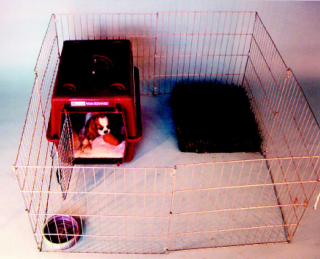
Successful domestic doggy education involves teaching your puppy to train herself through confinement. This prevents mistakes and establishes good habits from the outset. When you are physically or mentally absent, confine your puppy to keep her out of mischief and to help her learn how to behave appropriately.
The more you confine your puppy to her Puppy Playroom and Doggy Den during her first few weeks at home, the more freedom she will enjoy as an adult dog for the rest of her life. The more closely you adhere to the following puppy-confinement program, the sooner your puppy will be housetrained and chewtoy-trained. And, as an added benefit, your puppy will learn to settle down quickly, quietly, calmly, and happily.
When You Are Not at Home
Keep your puppy confined to a fairly small puppy playroom, such as the kitchen, bathroom, or utility room. You can also use an exercise pen to cordon off a small section of a room. This is your puppy’s long-term confinement area, which should include:
1. A comfortable bed
2. A bowl of fresh water
3. Plenty of hollow chewtoys (stuffed with dog food)
4. A doggy toilet in the farthest corner from her bed
Obviously, your puppy will feel the need to bark, chew, and eliminate throughout the course of the day, and so she must be left somewhere she can satisfy her needs without causing any damage or annoyance. Your puppy will most probably eliminate as far as possible from her sleeping quarters — in her doggy toilet. By removing all chewable items from the puppy playpen — with the exception of hollow chewtoys stuffed with kibble — you will make chewing chewtoys your puppy's favorite habit. A good habit!
The Purpose of long-term confinement is:
· To confine the puppy to an area where chewing and toilet behavior are acceptable, so the puppy does not make any chewing or housesoiling mistakes around the house
· To maximize the likelihood that the puppy will learn to use the provided toilet
· To maximize the likelihood that the puppy will learn to chew only chewtoys (the only chewables available in the playroom)
· To maximize the likelihood that the puppy will learn to settle down calmly and quietly, i.e., without barking
When You Are at Home
Enjoy short play and training sessions hourly. If you cannot pay full attention to your puppy’s every single second, play with your pup in his Puppy Playpen, where a suitable toilet and toys are available. Or, for periods of no longer than an hour at a time, confine your puppy to his Doggy Den (short-term close confinement area), such as a portable dog crate. Every hour on the hour, release your puppy and quickly take him to his doggy toilet. Your puppy's short-term confinement area should include a comfortable bed, and plenty of hollow chewtoys (stuffed with dog food).
It is much easier to watch your pup if he is settled down in a single spot. Either you may move the crate so that your puppy is in the same room as you, or you may want to confine your pup to a different room to start preparing him for times when he will be left at home alone. If you do not like the idea of confining your puppy to a dog crate, you may tie the leash to your belt and have the pup settle down at your feet. Or you may fasten the leash to an eye-hook in the baseboard next to your puppy's bed, basket, or mat. To prevent the chewtoys from rolling out of reach, also tie them to the eye-hook.
The Purpose of Short-term Close Confinement is:
· To confine the puppy to an area where chewing behavior is acceptable so the puppy does not make chewing mistakes around the house
· To make the puppy a chewtoyaholic (since chewtoys are the only chewables available and they are stuffed with food)
· To teach the puppy to settle down calmly and happily for periodic quiet moments
· To prevent housesoiling mistakes around the house
· To predict when the puppy needs to eliminate
Dogs naturally avoid soiling their den, so closely confining a puppy to his bed temporarily inhibits urination and defecation. This means the pup will need to relieve himself when released from the crate each hour. You will then be there to show the puppy the right spot, reward him for eliminating in the right spot, and then enjoy a short play/training session with the delightfully empty puppy.
Train Your Puppy to Train Himself
Housetraining and chewtoy-training will be quick and easy if you adhere to the puppy confinement plan above, which prevents the puppy from making mistakes and prompts the puppy to teach herself household etiquette. If you vary from the program, you will likely experience problems. Unless you enjoy problems, you must reprimand yourself for any mistakes you allow your puppy to make.
Want to raise the perfect puppy?
Learn more about puppy training with The Best Online Puppy Training Programs:
The Top Dog Academy. Learn how to set up your pup's crate and playpen, and teach them to love spending time there with videos, worksheets, podcasts, and more. When you join the Top Dog Academy you also get access to personalized email support so you can train your puppy yourself. Use this link to get your first month for free.
SIRIUS Puppy Training. Looking for more support? Get personalized, real-time, video dog training guidance from an expert SIRIUS Puppy Training instructor. Dr. Dunbar's SIRIUS Puppy & Dog Training classes revolutionized the world of pet dogs when they were first created. Now, our online small-group classes allow you to get the expert assistance you need from the comfort of your home.
Errorless Housetraining
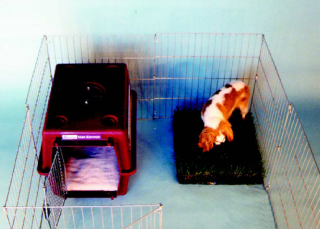
Housesoiling is a spatial problem, involving perfectly normal, natural, and necessary canine behaviors (peeing and pooping) performed in inappropriate places.
Housetraining is quickly and easily accomplished by praising your puppy and offering a food treat when she eliminates in an appropriate toilet area. Once your pup realizes that her eliminatory products are the equivalent of coins in a food vending machine — that feces and urine may be cashed in for tasty treats — your pup will be clamoring to eliminate in the appropriate spot, because soiling the house does not bring equivalent fringe benefits.
Housesoiling is also a temporal problem: either the puppy is in the wrong place at the right time (confined indoors with full bladder and bowels), or the puppy is in the right place at the wrong time (outdoors in the yard or on a walk, but with empty bladder and bowels).
Timing is the essence of successful housetraining. Indeed, efficient and effective housetraining depends upon the owner being able to predict when the puppy needs to eliminate so that she may be directed to an appropriate toilet area and more than adequately rewarded for doing the right thing in the right place at the right time.
Usually, puppies urinate within half a minute of waking up from a nap and usually defecate within a couple of minutes of that. But who has the time to hang around to wait for puppy to wake up and pee and poop? Instead it's a better plan to wake up the puppy yourself, when you are ready and the time is right.
Short-term confinement to a dog crate offers a convenient means to accurately predict when your puppy needs to relieve herself. Confining a pup to a small area strongly inhibits her from urinating or defecating, since she doesn't want to soil her sleeping area. Hence, the puppy is highly likely to want to eliminate immediately after being released from confinement.
Housetraining Is as Easy as 1-2-3
When you are away from home or if you are too busy or distracted to adhere to the following schedule, keep your puppy confined to her puppy playroom where she has a suitable doggy toilet. Otherwise, when you are at home: 1. Keep your puppy closely confined to her doggy den (crate) or on-leash. 2. Every hour on the hour release your pup from confinement and quickly run her (on-leash if necessary) to the toilet area, instruct your pup to eliminate, and give her three minutes to do so. 3. Enthusiastically praise your puppy when she eliminates, offer three freeze-dried liver treats, and then play/train with the pup indoors; once your puppy is old enough to go outside, take her for a walk after she eliminates.
If errorless housetraining is so easy, why do so many dog owners experience problems? Here are some common questions and answers that help make errorless housetraining work.
(For more information about Errorless Housetraining, including videos, worksheets, and personalized email support, join Dr. Ian Dunbar's Top Dog Academy. Use this link to get your first month for free.)
Why confine the pup to his doggy den? Why not his playroom?
Short-term close confinement allows you to predict when your puppy wants to go so that you may be there to direct him to the appropriate spot and reward him for doing the right thing in the right place at the right time. During the hour-long periods of close confinement, as your puppy lies doggo in dreamy repose, his bladder and bowels are slowly but surely filling up. Whenever the big hand reaches twelve and you dutifully release the pup to run to his indoor toilet or backyard doggy toilet to relieve himself, your puppy is likely to eliminate pronto. Knowing when your puppy wants to go allows you to choose the spot and most importantly to reward your puppy handsomely for using it. Rewarding your puppy for using his toilet is the secret to successful housetraining. If on the other hand the puppy were left in his playroom, he would most likely use his indoor toilet but would not be rewarded for doing so.
What if my puppy doesn't like going in his crate?
Before confining your puppy to his crate (doggy den), you first need to teach him to love the crate and to love confinement. This is so easy to do. Stuff a couple of hollow chewtoys with kibble and the occasional treat. Let your puppy sniff the stuffed chewtoys and then place them in the crate and shut the door with your puppy on the outside. Usually it takes just a few seconds for your puppy to beg you to open the door and let him inside. In no time at all, your pup will be happily preoccupied with his chewtoys. When leaving the puppy in his long-term confinement area, tie the stuffed chewtoys to the inside of the crate and leave the crate door open. Thus, the puppy can choose whether he wants to explore the small area or lie down on his bed in his crate and try to extricate the kibble and treats from his chewtoys. Basically, the stuffed chewtoys are confined to the crate and the puppy is given the option of coming or going at will. Most puppies choose to rest comfortably inside the crate with stuffed chewtoys for entertainment. This technique works especially well if your puppy is not fed kibble from a bowl but only from chewtoys or by hand, as lures and rewards in training. To use this method, each morning measure out the puppy’s daily ration of food into a bag to avoid overfeeding.
What if I don't like putting my puppy in a crate?
Short-term confinement, whether to a crate or tie-down, is a temporary training measure to help you teach your puppy where to eliminate and what to chew. A dog crate is the best housetraining tool to help you accurately predict when your dog wishes to relieve herself and is the best training tool to help you to teach your puppy to become a chewtoyaholic. Once your puppy has learned to eliminate only in appropriate areas and to chew only appropriate objects, she may be given free run of the house and garden for the rest of her life. You will probably find however, that after just a few days your puppy learns to love her crate and will voluntarily rest inside. Your puppy's very own den is a quiet, comfortable, and special doggy place. If, on the other hand, your puppy is given unsupervised free run of the house from the outset, the odds are that she will be confined later on — first to the yard, then to the basement, then to a cage in an animal shelter, and then to a coffin. Without a doubt, housesoiling and destructive chewing are the two most prevalent terminal illnesses in dogs. Using a dog crate will help you prevent these problems from ever developing in your puppy.
Why not just leave the puppy outdoors until he is housetrained?
Who is going to housetrain your pup outside — a shrub? If the dog is left outside unattended, he will become an indiscriminate eliminator. Basically, your puppy will learn to go wherever he wants, whenever he wants, and he will likely do the same whenever you let him indoors. Puppies left outdoors and unsupervised for long periods of time seldom become housetrained. Also, they tend to become indiscriminate barkers, chewers, diggers, and escapists, and they may be more easily stolen. Outdoor puppies also become so excited on the few occasions they are invited indoors that eventually they are no longer allowed inside at all.
Why release the pup every hour?
Why not every 55 minutes or every three hours? Is it really necessary to do it on the hour? Puppies have a 45-minute bladder capacity at three weeks of age, 75-minute capacity at eight weeks, 90-minute capacity at twelve weeks and two-hour capacity at 18 weeks. Releasing your puppy every hour offers you an hourly opportunity to reward your dog for using a designated toilet area. You do not have to do this precisely each hour, but it is much easier to remember to do so each hour on the hour.
Why run the puppy to the toilet? Why not walk sedately?
If you take your time getting your puppy to his doggy toilet, you may find that he pees or poops en route. Hurrying your puppy tends to jiggle his bowels and bladder so that he really wants to go the moment you let him stand still and sniff his toilet area.
Why not just put the puppy outside by himself? Can't he do it on his own?
Of course he can. But the whole point of predicting when your puppy wants to relieve himself is so you can show him where and offer well-deserved praise and reward. Thus your puppy will learn where you would like him to go. Also, if you see your puppy eliminate, you know that he is empty; you may then allow your empty puppy supervised exploration of the house for a while before returning him to his den.
Why instruct the pup to eliminate? Doesn't he know he wants to go?
By instructing your puppy to eliminate beforehand and by rewarding him for eliminating afterward, you will teach your pup to go on command. Eliminating on cue is a boon when you are traveling with your dog and in other time-constrained situations. Ask your pup to "Hurry up," "Do your business," "Go Pee and Poop," or use some other socially acceptable, euphemistic eliminatory command.
Why give the puppy three minutes? Isn't one minute sufficient?
Usually, a young pup will urinate within 30 seconds of being released from short-term confinement, but it may take one or two minutes for him to defecate. It is certainly worthwhile to allow your pup three minutes to complete his business
What if the puppy doesn't go?
Your puppy will be more likely to eliminate if you stand still and let him circle around you on leash. If your puppy does not eliminate within the allotted time, no biggie! Simply pop the pup back in his crate and try again in half an hour. Repeat the process over and over until he does eliminate. Eventually, your puppy will eliminate outdoors and you will be able to reward him. Therefore, on subsequent hourly trips to his toilet your puppy will be likely to eliminate promptly.
Why praise the puppy? Isn't relief sufficient reward?
It is far better to express your emotions when praising your puppy for getting it right, than when reprimanding the poor pup for getting it wrong. So really praise that pup: "Gooooooooood Puppy!" Housetraining is no time for understated thank yous. Don't be embarrassed about praising your puppy. Embarrassed dog owners usually end up with housesoiling problems. Really reward your puppy. Tell your puppy that he has done a most wonderful and glorious thing!
Why offer treats? Isn't praise sufficient reward?
In a word, no! The average person cannot effectively praise a moribund lettuce. And specifically, many owners—especially men—seem incapable of convincingly praising their puppies. Consequently, it might be a good idea to give the pup a food treat or two (or three) for his effort. Input for output! "Wow! My owner's great. Every time I pee or poop outside, she gives me a treat. I never get yummy treats when I do it on the couch. I can't wait for my owner to come home so I can go out in the yard and cash in my urine and feces for food treats!" In fact, why not keep some treats in a screw-top jar handy to the doggy toilet?
Why freeze-dried liver?
Housetraining is one of those times when you want to pull out all of the stops. Take my word for it: When it comes to housetraining, use the Ferrari of dog treats — freeze-dried liver.
Do we really have to give three liver treats when the puppy pees or poops? Isn't this a wee bit anal retentive?
Yes and no. Certainly you do not have to give your puppy exactly three treats every time. But it's a funny thing: If I suggest that people offer a treat each time their puppy eliminates promptly in the right place, they rarely follow instructions. Whenever I tell people to give three treats, however, they will painstakingly count out the treats to give to their puppy. Here’s what I am trying to say: Handsomely praise and reward your puppy every time he uses a designated toilet area.
Why play with the puppy indoors?
If you reward your pup for using his doggy toilet, you will know he is empty. "Thank you, empty puppy!" What better time to play with or train your puppy indoors without facing the risk of a messy mistake. Why get a puppy unless you want to spend some quality (feces-free) time with him?
Why bother to take an older puppy outdoors for a walk when he's empty?
Many people fall into the trap of taking their puppy outside or walking him so that he may eliminate, and when he does they bring him indoors. Usually it takes just a couple of trials before the puppy learns, "Whenever my urine or feces hits the ground, my walk ends!" Consequently, the pup becomes reluctant to eliminate outside, and so when brought home after a long jiggling play or walk, he is in dire need to relieve himself. Which he does. It is a much better plan to praise your puppy for using his doggy toilet and then take him for a walk as a reward for eliminating. Get in the habit of taking an older puppy to his doggy toilet (in your yard or curbside in front of your apartment building), standing still, and waiting for the pup to eliminate. Praise the pup and offer liver treats when he does: "Good dog, let's go walkies!" Clean up and dispose of the feces in your own trash can, and then go and enjoy a poopless walk with your dog. After just a few days with a simple "no poop—no walk" rule, you'll find you have the quickest urinator and defecator in town.
What should I do if I've done all the above and I catch the puppy in the act of making a mistake?
Pick up a rolled newspaper and give yourself a smack! Obviously you did not follow the instructions above. Who allowed the urine-and-feces-filled puppy to have free-range access to your house? You! Should you ever reprimand or punish your puppy when you catch him in the act, all he will learn is to eliminate in secret—that is, never again in your untrustworthy presence. Thus you will have created an owner-absent housesoiling problem. If you ever catch your pup in the act of making a mistake that was your fault, at the very most you can quickly, softly, but urgently implore your pup, "Outside, outside, outside!" The tone and urgency of your voice communicates that you want your puppy to do something promptly, and the meaning of the words instruct the puppy where. Your response will have limited effect on the present mistake, but it helps prevent future mistakes.
Never reprimand your dog in a manner that is not instructive. Nonspecific reprimands only create more problems (owner-absent misbehavior) as well as frightening the pup and eroding the puppy-owner relationship. Your puppy is not a "bad puppy." On the contrary, your puppy is a good puppy that has been forced to misbehave because his owner could not, or would not, follow simple instructions. Please reread and follow the above instructions!
The Doggy Toilet
For the best doggy toilet, equip a litter box or cover a flat tray with what will be the dog's eventual toilet material. For example, for rural and suburban pups that will eventually be taught to relieve themselves outside on earth or grass, lay down a roll of turf. For urban puppies that will eventually be taught to eliminate at curbside, lay down a couple of thin concrete tiles. Your puppy will soon develop a very strong natural preference for eliminating on similar outdoor surfaces whenever he can. If you have a backyard dog toilet area, in addition to the indoor playroom toilet, take your pup to his outdoor toilet in the yard whenever you release him from his doggy den.
If you live in an apartment and do not have a yard, teach your puppy to use his indoor toilet until he is old enough to venture outdoors at three months of age.
For a goog indoor or balcony doggy toilet check out PetaPotty or The Pet Loo.
Training Your Dog to Use an Outdoor Toilet
For the first few weeks, take your puppy outside on-leash. Hurry to his toilet area and then stand still to allow the puppy to circle (as he would normally do before eliminating). Reward your puppy each time he "goes" in the designated spot. If you have a fenced yard, you may later take your puppy outside off-leash and let him choose where he would like to eliminate. But make sure to reward him differentially according to how close he hits ground zero. Offer one treat for doing it outside quickly, two treats for doing it within, say, five yards of the outdoor doggy toilet, three treats for within two yards, and five treats for a bull's eye.
Once your dog has not had a housesoiling mistake for at least three months, you may increase your puppy's playroom to two rooms. For each subsequent month without a mistake your puppy may gain access to another room, until eventually he enjoys free run of the entire house and garden when left at home alone. If a housesoiling mistake should occur, go back to the original puppy confinement program for at least a month.
Want to learn more about how to toile train a dog without a single single mistake?
Check out The Best Online Puppy Training Program:
The Top Dog Academy. Learn how to crate train your dog so you can prevent toilet training mistakes and reward your dog when they eliminate in the correct place with videos, worksheets and podcasts that make the process easy to understand and easy to do. When you join the Top Dog Academy you also get access to personalized email support so you can train your puppy yourself. Use this link to get your first month for free.
Errorless Chewtoy-Training
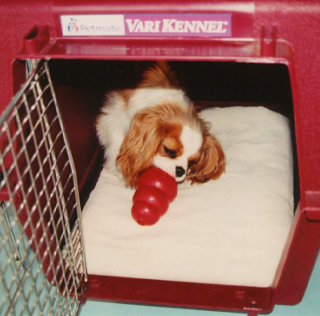
The dog is a social and inquisitive animal. He needs to do something, especially if left at home alone. What would you like your dog to do? Crosswords? Needlepoint? Watch soaps on the telly? You must provide some form of occupational therapy for your puppy to pass the day. If your puppy learns to enjoy chewing chewtoys, he will look forward to settling down quietly for some quality chewing time. It is important to teach your puppy to enjoy chewing chewtoys more than chewing household items. An effective ploy is to stuff the puppy's chewtoys with kibble and treats. In fact, during your puppy's first few weeks at home, put away his food bowl and, apart from using kibble as lures and rewards for training, serve all your puppy's kibble stuffed in hollow chewtoys — Kongs, Biscuit Balls, Squirrel Dudes, Busy Buddy Footballs and sterilized bones.
For errorless chewtoy-training, adhere to the puppy confinement program. When you are away from home, leave the puppy in his puppy playroom with bed, water, toilet, and plenty of stuffed chewtoys. While you are at home, leave the puppy in his doggy den with plenty of stuffed chewtoys. Every hour after releasing the pup to relieve himself, play chewtoy games — chewtoy-search, chewtoy-fetch, and chewtoy-tug-o'-war. Your puppy will soon develop a very strong chewtoy habit because you have limited his chewing choices to a single acceptable toy, which you have made even more attractive with the addition of kibble and treats.
Once your dog has become a chewtoyaholic and has not had a chewing (or housesoiling) mishap for at least three months, you may increase your puppy's playroom to two rooms. For each subsequent month without a mistake your puppy may gain access to another room, until eventually he enjoys free run of the entire house and garden when left at home alone. If a chewing mistake should occur, go back to the original puppy confinement program for at least a month.
In addition to preventing household destruction, teaching your puppy to become a chewtoyaholic prevents him from becoming a recreational barker because chewing and barking are obviously mutually exclusive behaviors. Also, chewtoyaholism helps your puppy learn to settle down calmly because chewing and dashing about are mutually exclusive behaviors.
Chewtoyaholism is especially useful for dogs with Obsessive Compulsive Disorder since it provides them with an acceptable and convenient means to work out their obsessions and compulsions. Your dog may still have OCD, but a chewtoyaholic will happily spend his time obsessively and compulsively chewing his stuffed chewtoys.
Most important, chewtoy chewing keeps the puppy occupied and effectively helps prevent the development of separation anxiety.
What Is a Chewtoy?
A chewtoy is an object for the dog to chew that is neither destructible nor consumable. If your dog destroys an object, you will have to replace it, and that costs money. If your dog consumes the object, you may have to replace your dog. Eating non-food items is extremely hazardous to your dog's health. The type of chewtoy you choose will depend on your dog's penchant for chewing and his individual preferences. I have seen some dogs make a cow's hoof or a compressed rawhide chewy last forever, whereas other dogs consume them in a matter of minutes. For years, I considered Kong products to be the Cadillacs of chewtoys. Now, there are other equally good products, such as Premier Pet Product’s Squirrel Dudes and Busy Buddy Footballs. Hollow sterilized long bones are a very close second choice. I like Kong and Premier products and sterilized bones because they are simple, natural, and organic, i.e., not plastic. Also, being hollow, they can be stuffed with food.
Want to learn more? Join The Top Dog Academy. Learn how to prevent destructive chewing with videos, worksheets, podcasts and more. When you join the Top Dog Academy you also get access to personalized email support so you can train your puppy yourself. Use this link to get your first month for free.
Dinner from Chewtoys, Not from Bowls
Customarily, puppies receive their entire daily allotment of kibble at dinner, which often becomes a jackpot reward for boisterously barking and expectantly bouncing around. Moreover, if you allow your puppy to wolf down dinner from a bowl, he will be at a loss for what to do for the rest of the day. In the wild, dogs spend a good 90 percent of their waking hours searching for something to eat, and so in a sense, regular bowl-feeding deprives a dog of his principal activity — searching for food. Instead, after eating, your inquisitive puppy will search for entertainment for the rest of the day. Most likely you will consider your puppy's choices of occupation to be mischievous misbehavior.
Without a doubt, regularly feeding a new puppy (or adult dog) from a bowl is the single most disastrous mistake in dog husbandry and training. Although unintentional, the effects of bowl-feeding are often severely detrimental for the puppy's household manners and sense of well-being. In a sense, each bowl-fed meal steals the puppy's raison d'etre — its very reason for being. Within seconds of gulping his meal, the poor pup now faces a mental void for the rest of his day with nothing but long, lonely hours to worry and fret, or work himself into a frenzy.
As the puppy adapts to fill the void, normal behaviors such as chewing, barking, strolling, grooming, and playing become stereotypical, repetitive, and maladaptive. Specific behaviors increase in frequency until they no longer serve any useful function except to pass the time. Investigative chewing becomes destructive chewing. Alarm barking becomes incessant barking. Strolling from one place to another becomes repetitively pacing, or racing back and forth. Investigating a shadow or light becomes a neurotic fixation. Routine grooming becomes excessive licking, scratching, tail-chasing, head-pressing, or in extreme cases, self-mutilation.
Stereotyped behaviors cause the release of endorphins, perpetuating their repetition, and in a sense, the dog becomes drugged and hooked on mindless, repetitive activity. Stereotyped behaviors are like behavioral cancers; as they progressively increase in frequency and squeeze most useful and adaptive responses from the dog's behavior repertoire until eventually the "brain-dead" dog spends hours on end barking, pacing, chewing himself, or simply staring into space.
A vital facet of your puppy's early education is to teach him how to peacefully pass the time of day. Feeding your puppy's kibble only from hollow chewtoys keeps your puppy happily occupied and content for hours on end. It allows the puppy to focus on an enjoyable activity so that he doesn't dwell on his loneliness. Each piece of extracted kibble also rewards your puppy for settling down calmly, for chewing an appropriate chewtoy, and for not barking.
Chewtoy Stuffing
An old chewtoy becomes immediately novel and exciting when stuffed with food. If you use kibble from your puppy's normal daily ration your puppy will not put on weight. To protect your puppy's waistline, heart, and liver, it is important to minimize the use of treats in training. Use kibble as lures and rewards for teaching basic manners and reserve freeze-dried liver treats for initial housetraining, for meeting children, men, and strangers, as a garnish for stuffing Kongs (see below), and as an occasional jackpot reward for especially good behavior.
Kong Stuffing 101
The basic principle of Kong stuffing ensures that some food comes out quickly and easily to instantly reward your puppy for initially contacting his chewtoy; bits of food come out over a long period of time to periodically reward your puppy for continuing to chew; and some of the best bits never come out, so your puppy never loses interest. Squish a small piece of freeze-dried liver in the small hole in the tip of the Kong so your puppy will never be able to get it out. Smear a little honey around the inside of the Kong, fill it up with kibble, and then block the big hole with crossed dog biscuits. There are numerous creative variations on basic Kong stuffing. One of my favorite recipes comprises moistening your puppy's kibble, spooning it into the Kong, and then putting it in the freezer overnight—a Kongsicle! Your dog will love it.
Kong Is King!
If from the outset you always confine your puppy with a selection of stuffed Kongs and Biscuit Balls, chewing these appropriate chewtoys will soon become an integral part of his day. Your puppy will quickly develop a socially acceptable Kong habit. And remember, good habits are just as hard to break as bad habits. Your puppy will now spend a large part of his day musing over his Kong products.
Let's pause for a moment to consider all the bad things your puppy will not be doing if he is quietly engaged with his chewtoys. He will not be chewing inappropriate household and garden items. He will not be a recreational barker. (He will still bark when strangers come to the house, but he will not spend all day barking for barking's sake.) And he will not be running around, fretting, and working himself up if left at home alone.
The wonderful thing about teaching a puppy to enjoy chewing chewtoys is that this activity excludes many alternative, extremely annoying puppy behaviors. A stuffed Kong is one of the best stress-relievers, especially for anxious, obsessive, and compulsive dogs.
A Kong for a dog is also one of the best stress-relievers for the owner. There is no single device that so easily and so simply prevents or resolves so many bad habits and behavior problems.
Settle Down and Shush
High on the educational agenda is to teach your pup that there are times for play and times for quiet. Specifically, you want to teach the youngster to settle down and shush for short periods. Your life will be more peaceful, and your pup's life will be less stressful once he learns that frequent little quiet moments are the name of the game in his new home.
Beware the trap of smothering your new puppy with non-stop attention and affection during his first days at home, for then he will whine, bark, and fret when left alone at night, or during the daytime when you are at work and the children are at school. Of course the pup is lonely! This is his first time alone without his mother, littermates, or human companionship.
You can really help to ease your pup's anxiety by getting him used to settling down alone during his first few days at home. Remember, first impressions are very important and long lasting. Also keep in mind that the average suburban puppy will likely spend many hours and days left to his own devices. So it is well worthwhile to teach the pup how to spend time by himself. Otherwise, the puppy may become anxious when left alone and develop hard-to-break chewing, barking, digging, and escaping habits.
When you are at home, confine your puppy to his doggy den with lots of chewtoys for housetraining, chewtoy-training, and teaching the pup to settle down peacefully and happily. It is important to confine your puppy for short periods when you are home in order to teach him how to enjoy his own company when left at home alone.
I am certainly not advocating leaving puppies alone for long periods of time. But it is a fact of modern day life that many puppy owners leave home each day to work for a living, so it is only fair to prepare the pup for this.
When you are at home, the key is short-term confinement. The idea is not to lock up the puppy for hours on end, but rather to teach him to settle down quickly in a variety of settings and be confined for variable but mostly fairly short, periods. Make sure the only objects within reach are stuffed chewtoys. Thus the dog develops a strong chewtoy habit right from the outset, if only because there is precious little else at hand to chew. And let me repeat: A puppy happily preoccupied with a stuffed chewtoy is not destroying household articles and furniture, and is not barking. When you are at home, it is also a good idea to occasionally confine your puppy to his puppy playroom (long-term confinement area) as a practice run for your absence. Occasional long-term confinement when you are at home allows you to monitor your pup's behavior so you have some idea how he will act when you are gone.
If your puppy barks or whines when confined to his short- or long-term confinement area, reward-train him to rest quietly. Sit next to your puppy’s crate or just outside his puppy playroom and busy yourself by reading a book, working on the computer, or watching television. Completely ignore your puppy while he vocalizes, but each time he stops barking, immediately praise him calmly and offer a piece of kibble.
Want to learn more about chew toy training?
Learn more with The Best Online Dog Training Programs:
The Top Dog Academy. Learn how to prevent destructive chewing by training your dog to enjoy chew toys instead with videos, worksheets, podcasts and more. When you join the Top Dog Academy you also get access to personalized email support so you can train your puppy yourself. Use this link to get your first month for free.
SIRIUS Puppy Training. Looking for more support? Get personalized, real-time, video dog training guidance from an expert SIRIUS Puppy Training instructor. Dr. Dunbar's SIRIUS Puppy & Dog Training classes revolutionized the world of pet dogs when they were first created. Now, our online small-group classes allow you to get the expert assistance you need from the comfort of your home.
Home Alone
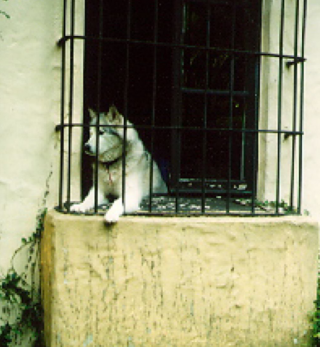
All owners find it occasionally necessary to leave their puppydog at home alone. So before leaving your puppy for long periods, you should teach him how to amuse himself appropriately when left alone, such as by chewing stuffed chewtoys, and learning how to enjoy his own company without becoming anxious or stressed. A dog is a highly social animal and therefore requires adequate preparation for spending some of his time in social isolation and solitary confinement.
To teach your puppy how to settle down calmly and quietly when you are absent, start by teaching him to settle down with a chewtoy at times when you are present.
A dog is not like a television or a video game. You can't just pull the plug or temporarily remove the batteries from a rambunctious puppy. Instead, you must teach him to settle down and shush. Right from the outset, make frequent quiet moments part of the puppy's daily routine. Following the confinement schedule (described in Puppy’s First Week at Home) will help your puppy train himself to settle down. Additionally, encourage your puppy to settle down beside you for longer and longer periods. For example, when you're watching television have your pup lie down on leash or in his crate, but release him for short play-training breaks during the commercials. For a young puppy, you can't have too many rules.
When playing with your pup, have him settle down for frequent short interludes every one or two minutes. Initially have the pup lie still for a few seconds before letting him play again. After a minute, interrupt the play session once more with a three-second settle-down. Then try for four seconds, then five, eight, ten, and so on. Although being yo-yoed between the commands "Settle down" and "Let's play" is difficult at first, the puppy soon learns to settle down quickly and happily. Your puppy will learn that being asked to settle down is not the end of the world, nor is it necessarily the end of the play session, but instead that "Settle down" signals a short timeout and reward-break before he is allowed to resume playing.
If you teach your puppy to be calm and controlled when told, you will have years of fun and excitement ahead. Once your puppy has learned to settle down and shush on cue, there is so much more your dog can enjoy with you. Your well-trained dog is likely to be invited for many walks, trips in the car, picnics, visits to the pub, or to Grandma's, and even on incredible journeys to stay in ritzy dog-friendly hotels. On the other hand, if you let your dog play indiscriminately as a puppy, he will no doubt want to play indiscriminately as an adult. Your dog will be hyperactive and uncontrollable because you have taught him to act that way. If your pup has not been taught to settle down by the time he reaches adolescence, he will be unfit to be taken places. Your pup will begin a lifetime of confinement and isolation at home while the rest of the family go out to have a good time. Not fair!
Until you have trained your puppy to enjoy spending much of his day at home alone, you might recruit a puppy sitter who has time to spend with him. Just a few houses down the street, there may live an elderly gentleman, for example, who would just love to live with a dog (but who doesn't for some reason) and therefore would be willing to come over during the daytime and sit and enjoy your TV or the contents of your fridge; maintain your puppy's confinement schedule and regularly reward him for using his doggy toilet; and periodically play with the pup and teach him household rules.
Separation Anxiety
Maintaining your puppy's confinement schedule when you are at home prepares your puppy to be calm when you are gone. Allowing a young puppy unrestricted access to you when you are at home quickly encourages him to become overly dependent, and overdependence is the most common reason why dogs become anxious when left at home alone.
Try your best to teach your puppy to enjoy his own company, to develop self-confidence, and to stand on his own four paws. Once your puppy is confident and relaxed on his own, he may enjoy all of his time with you when you are at home.
When leaving your puppy for hourly sessions in his short-term confinement area (dog crate), make a point to check how he fares when left in another room. For example, periodically confine your puppy to his crate in the dining room while you prepare food in the kitchen, then keep the pup in his crate in the kitchen while the family eats dinner in the dining room.
Most importantly, when you are at home, make certain to familiarize your puppy with his long-term confinement area (puppy playroom). Confining your pup when you're home enables you to monitor his behavior during confinement and check in on him at irregular intervals, quietly rewarding him for being quiet. Thus your pup will not necessarily associate his confinement area with your absence, but rather he will learn to look forward to time spent in his playroom with his special toys.
Give your puppy plenty of toys whenever leaving him on his own. Ideal chewtoys are indestructible and hollow (such as Kong and Premier products and sterilized longbones), as they may be conveniently stuffed with kibble and occasional treats which periodically fall out and reward the pup for chewing his toy. If your puppy is gainfully occupied with his chewtoy, he will fret less over your absence.
Additionally, leave a radio playing. The sound will provide white noise to mask outside disturbances. The sound of a radio is also reassuring, since it is normally associated with your presence. My Malamute Phoenix was quite partial to Classical music, Country, and Calypso. Oso prefers television, especially ESPN or CNN — the sound of reassuring male voices, perhaps?
When Leaving Home
Make sure to stuff a number of chewtoys with kibble and treats. Make sure to stuff a piece of freeze-dried liver into the tiny hole of each Kong, or deep into the marrow cavity of each bone. Place the tastily stuffed chewtoys in your puppy's long-term confinement area and shut the door… with your puppy on the outside! When your puppy begs you to open the door, let him in and shut the door, turn on the radio or television, and leave quietly. Your puppy's chewing will be regularly reinforced by each piece of kibble that falls out of the chewtoy. Your puppy will continue to chew in an attempt to extract the freeze-dried liver. Eventually your puppy will fall asleep.
When Returning Home
Do not acknowledge your puppy's presence with praise or petting until he retrieves a chewtoy. Once he brings you a chewtoy, use a pen or pencil to push out the piece of freeze-dried liver that your puppy has been unable to extract. This will impress your puppy to no end.
Dogs are crepuscular and quite happy to sleep all day and all night. They have two activity peaks, at dawn and dusk. Thus, most chewing and barking activity is likely to occur right after you leave your pup in the morning and just before you return in the evening. Leaving your puppy with freshly stuffed chewtoys and offering the unextracted treats when you return prompts your puppy to seek out his chewtoys at times of peak activity.
Jekyll-and-Hyde Behavior
Smothering your pup with attention and affection when you are home primes your puppy to really miss you when you are gone. A Jekyll-and-Hyde environment (lots of attention when you are there, and none when you are gone) quickly creates a Jeckyll-and-Hyde puppy that is completely confident when you are there, but falls apart and panics when you are gone.
If you allow your puppy to become overdependent upon your presence, he will be anxious in your absence. Canine anxiety is bad news for you and bad news for your pup. When stressed, dogs are more likely to indulge in bad habits, such as housesoiling, chewing, digging, and barking. Being anxious is also decidedly unpleasant for your dog.
During your puppy's first few weeks at home, frequent confinement with stuffed chewtoys is essential for your pup to develop confidence and independence. Once your puppy is quite happy busying himself with his chewtoys whenever left alone, you may safely allow your now well-behaved and confident pup to enjoy as much time with you as he likes, without the fear that he will become anxious in your absence.
Is It Really Separation Anxiety?
Most doggy "disobedience" and wanton house destruction occurring in the owner's absence has nothing to do with separation anxiety. In fact, separation relief might be a more precise and descriptive term. The dog chews, digs, barks, and soils the house only when the owner is absent because he has learned it would be foolhardy to indulge in these pastimes when the owner is present. Owner-absent misbehavior is an indication that the owner has tried to suppress normal and natural dog behaviors with punishment, rather than teaching the dog how to behave — namely, how to express his basic doggy desires in an acceptable fashion. Often the term “separation anxiety” is an excuse for a dog who is simply not yet housetrained or chewtoy-trained.
Adapted from AFTER You Get Your Puppy by Dr. Ian Dunbar
Puppy's First Month at Home (8-12 weeks)
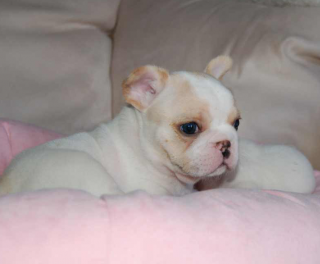
Puppies are simply custom-designed for easy socialization. Young puppies eagerly approach everyone, and everyone who sees them instinctively wants to pick them up and cuddle.
The more people your pup meets and enjoys, the more your pup will like people as an adult. Additionally, the more your pup is handled and rewarded by people, the more your future adult dog will enjoy being hugged by children and examined by veterinarians.
The Critical Period of Socialization ends by three months of age! This is the crucial developmental stage during which puppies learn to accept and enjoy the company of other dogs and people. Thus your puppy needs to be socialized to people by the time he is twelve weeks old. However, since his series of puppy immunization injections is incomplete at this point, a young pup needs to meet people in the safety of his own home. As a rule of thumb, your puppy needs to meet and party with at least a hundred people during his first month at home.
Puppies have very sharp teeth and even fairly gentle bites can hurt. However, puppy biting behavior and periodic painful (yet non-harmful) bites are essential for a puppy to ultimately develop a soft mouth as an adult dog. Puppies learn that play-fighting and play-biting are fun, but that painful bites bring an abrupt end to the play session. Thus, the more that puppies are allowed to play and bite, the quicker the painful bites decrease in frequency. Puppies must learn to control the pressure of their biting and mouthing before they develop the strength to cause serious harm and so, you must teach your puppy proper bite inhibition before he gets too old. Bite inhibition must be taught during puppyhood.
Additionally, you must teach your puppy to be confident and happy regarding human presence around their food bowl and valued objects, otherwise your puppy may become overly possessive and begin to guard objects.
Unfortunately, far too many owners underestimate the crucial importance of teaching bite inhibition and socializing their young puppy and so, I have included a list of common excuses. Not teaching bite inhibition is both asinine and potentially dangerous. Not sufficiently socializing a puppy is inhumane; as an adult, the poor dog will forever feel stressed, anxious and edgy around people. Not fair. Please socialize your puppy. In fact, please enjoy socializing yourself and your puppy with many puppy parties during your puppy’s first month at home.
Want to raise the perfect puppy?
Learn more about puppy training with The Best Online Puppy Training Programs:
The Top Dog Academy. Learn how to deal with puppy biting, crate training, toilet training, socialization and more with videos, worksheets and podcasts about puppy training. When you join the Top Dog Academy you also get access to personalized email support so you can train your puppy yourself. Use this link to get your first month for free.
SIRIUS Puppy Training. Looking for more support? Get personalized, real-time, video dog training guidance from an expert SIRIUS Puppy Training instructor. Dr. Dunbar's SIRIUS Puppy & Dog Training classes revolutionized the world of pet dogs when they were first created. Now, our online small-group classes allow you to get the expert assistance you need from the comfort of your home.
Socialization With People
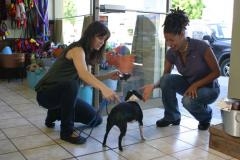
Raising and training a pup to be people-friendly is the second most important goal of pet-dog husbandry. Of course, teaching bite inhibition is always the most important goal. But during your pup's first month at home, urgency dictates that socialization with people is the prime puppy directive.
As a rule of thumb, your puppy needs to meet at least a hundred people before he is three months old. Since your puppy is still too young to venture out on the streets, you'll need to start inviting people to your home right away. Basically, you'll need to have lots of puppy parties and invite friends over to handfeed your pup and train him for you.
Doggy Dream or Nasty Nightmare?
A most important quality in a pet dog is his temperament. A dog with a good temperament can be a dream to live with, but a dog with a tricky temperament is a perpetual nightmare. Moreover, regardless of breed or breeding, a dog's temperament, especially his feelings toward people and other dogs, is primarily the result of his level of socialization during puppyhood — the most important time in a dog's life. Do not waste this golden opportunity. Solid gold temperaments are forged during this period.
Your puppy must be fully socialized to people before he is three months old. Many people think puppy classes are the time to socialize puppies to people. Not so — too little, too late. Puppy classes are a fun night out to continue socializing socialized puppies with people, for therapeutic socialization of puppies with other puppies, and most important, for puppies to learn bite inhibition.
You now have just a few weeks left to socialize your puppy. Unfortunately, your pup needs to be confined indoors until he is at least three months old, when he has acquired sufficient immunity through his puppy shots against the more serious dog diseases. However, even a relatively short period of social isolation at such a crucial developmental stage could all but ruin your puppy's temperament. Whereas dog-dog socialization may be put on temporary hold until your pup is old enough to go to puppy school and the dog park, you simply cannot delay socialization with people. It may be possible to live with a dog that does not like other dogs, but it is difficult and potentially dangerous to live with a dog that does not like people, especially if the dog doesn't like your friends and family.
Consequently, there is considerable urgency to introduce your puppy to a wide variety of people — to family, friends and strangers, and especially to men and children. As a rule of thumb, your pup needs to meet at least a hundred different people before he is three months old — an average of three unfamiliar people a day.
A Hundred People
Capitalize on the time your pup needs to be confined indoors by inviting people to your home. Your pup needs to socialize with at least a hundred different people before he is three months old. I know this may sound like a bit of an ordeal, but it is actually quite easy to accomplish. Twice a week, invite different groups of six men to watch sports on TV. Generally, men are pretty easy to attract if you offer television sports programs, pizza, and beer. On several other nights a week, invite different groups of six women for ice cream, chocolate, and good conversation. (Or the other way round—you know your friends better than I do.) On another night of the week, catch up on all of your outstanding social obligations by inviting family, friends, and neighbors for meet-the-puppy dinners. Another tactic is to bring your puppy to visit your office for the day. Or, have a puppy party once a week. Above all, don't keep your puppy a secret. One of the great things about puppy socialization is that it also does wonders for your social life!
Urgency
From the very first day you get your puppy, the clock is ticking. And time flies! By eight weeks of age, your puppy's Critical Period of Socialization is already waning and within a month, his most impressionable learning period will start to close. There is so much to teach, and nearly everything needs to be taught right away.
Be Safe
Puppies may become infected with serious dog diseases by sniffing the urine or feces of infected dogs. Never let your puppy on the ground where other dogs may have eliminated. You may take your puppy for car rides and to visit friends, but always carry your puppy from house to car, and vice versa. Of course, these precautions also apply to visits to the veterinary clinic. The ground immediately outside the door of the clinic and the floor of the waiting room are two of the most likely contaminated areas. Carry your puppy from the car to the clinic and keep him on your lap in the waiting room. Better yet, keep your puppy crated in your car until it is time for his examination.
Three Goals Of Socialization
1. Teach your puppy to enjoy the presence, actions, and antics of all people — first the family, and then friends and strangers, especially children and men. Adult dogs tend to feel most uneasy around children and men, especially little boys. A dog's antipathy toward children and men is more likely to develop if the puppy grows up with few or none around, and if the puppy's social contacts with children and men have been unpleasant or scary. 2. Teach your puppy to enjoy being hugged and handled (restrained and examined) by people, especially by children, veterinarians, and groomers. Specifically, teach your puppy to enjoy being touched and handled in a variety of "hot spots," namely, around his collar, muzzle, ears, paws, tail, and rear end. 3. Teach your puppy to enjoy giving up valued objects when requested, especially her food bowl, bones, balls, chewtoys, garbage, and paper tissues.
Adapted from AFTER You Get Your Puppy by Dr. Ian Dunbar
Teach Your Puppy to Like and Respect People
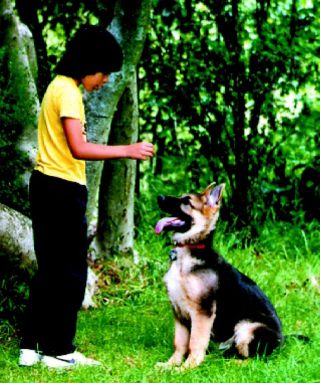
Compensate for your puppy's temporary but necessary social vacuum during his first month at home by introducing him to as many people as possible in the safety of his own home. Initial impressions are important, so make sure your puppy's first meetings with people are pleasant and enjoyable. Have every guest handfeed your puppy a couple of pieces of kibble. Puppies that enjoy the company of people grow up into adult dogs that enjoy the company of people. And dogs that enjoy the company of people are less likely to be frightened or bite.
Make sure to invite a number of different people to your home each day. It is not sufficient for your pup to meet the same people over and over again. Your puppy needs to grow accustomed to meeting strangers — at least three a day. Maintain routine hygiene at all times; have guests leave outdoor shoes outside and wash their hands before handling your puppy.
Training Treats
To prevent your puppy from porking out on junk food treats, use your pup's daily ration of kibble as training treats. To prevent your puppy from being overfed by members of the family, measure your puppy's daily diet of kibble plus treats into a separate container first thing in the morning. Thus at any time of the day, if any kibble or treats remain in the container, they may be fed to the puppy as a snack, as a meal, or individually handfed as rewards when training.
Invite many people to meet your puppy. Show every guest how to teach your puppy to come, sit, lie down, stand and rollover.
If your puppy is regularly handfed dinner by guests in this manner, he will soon learn to enjoy the company of people and to approach happily and sit automatically when greeting them. And, of course, as an added bonus you will have successfully trained your family and friends to help you train your puppy.
Children
The actions and antics of children can be extremely scary to adult dogs that are not socialized with children during puppyhood. Even well-socialized adult dogs may get into trouble, since much that children do excites dogs and incites them to play and chase. Puppies and children must be taught how to behave around each other. This is easy and fun to do, so let's do it.
For puppy owners with children, the next few months present a bit of a challenge. It is infinitely worthwhile, however, because puppies successfully socialized with children generally develop exceedingly sound temperaments — they have to — and once they mature there is little in life that can surprise or upset them. However, to maximize the relationship between dogs and children and to ensure the dog's good nature and solid disposition, parents must educate their children as well as the pup. Teach your children how to act around the pup, and teach your pup how to act around children.
Puppy owners without children have a different kind of challenge. You must invite children to your home to meet your puppy, now! However, unless your child-training skills exceed your puppy-training skills, initially invite over children only in small numbers. To start with, invite only a single child. One child is marvelous. Two are fine. But usually, three children plus a puppy quickly reach critical mass and emit levels of energy unmeasurable by any known scientific instrument. And, after all, we are trying to teach the puppy and the children to be calm and mannerly.
First, invite over only well-trained children. Supervise the children at all times. I repeat, supervise the children at all times. (Later on, puppy classes will offer a wonderful source of children who have been trained how to act around puppies and who have been trained how to train puppies.)
Second, invite over your friends' and relatives' children — children your puppy is likely to meet regularly or even occasionally as an adult.
Third, invite over neighborhood children. Remember, it is usually neighborhood kids who terrorize your dog through the garden fence, exciting him and inciting him to bark, growl, snap, and lunge. Then, of course, it is the children's parents, your neighbors, who complain because your dog is barking and harassing their kids. Dogs are less likely to bark at children they know and like, so give your puppy ample opportunity to get to know and like neighborhood children. Similarly, children are less likely to tease a dog they know and like, owned by people they know and like, so give the neighborhood kids ample opportunity to get to know and like you and your puppy.
Give children tasty treats such as freeze-dried liver as well as kibble to use as lures and rewards during handling and training exercises. Thus, your puppy will quickly learn to love the presence, and presents, of children.
For the first week, make sure your puppy's interactions with children are carefully controlled and calm. Thereafter, however, it is important for puppy parties to be festive. Balloons, streamers, and music set the stage, and treats for the puppies plus presents, noise-makers, and costumes for the children set the scene.
It is so important that your puppy be very young when he first encounters and becomes thoroughly accustomed to the noise and activity of children. If your dog is already an adolescent before he sees his first child running and screaming in the park, generally you will be in for trouble because the dog will want to give chase. However, for the lucky puppy who has hosted numerous puppy parties with children (or adults) laughing, screaming, running, skipping, and falling over… well, that's just old hat. Been there, done that! After just a couple of occasions partying with children, it is unlikely anything in real life will be as weird as what has become the snoring-boring, established status quo during puppy parties.
Puppy-Party Games
Initially, Round Robin Recalls and Puppy Push-ups are the best games to play. Have the children sit in chairs in a big circle. The first child calls the puppy and has him lie down and sit up three times in succession before sending him to the next child in the circle — "Rover, Go to Jamie," whereupon Jamie calls the puppy to come and perform three puppy push-ups, and so on. This is a wonderful exercise to practice prompt recalls and lightning-fast control commands — sits and downs.
In subsequent puppy parties, Biscuit Balance and Drop Dead Dog competitions are the name of the game. Give each child praise and a prize, but give special praise and special prizes to the children who can get their dog to balance a dog biscuit on his nose for the longest time — the longest sit-stay, or to get their dog to lie down and play dead for the longest time — the longest down-stay.
As a rule of thumb, before your puppy is three months old he should have been handled and trained (to come, sit, lie down, and roll over) by at least twenty children.
Men
Many adult dogs are more fearful of men than they are of women. So invite over as many men as possible to handle and gentle your puppy. It is especially important to invite men to socialize with your puppy if no men are living in the household. Make sure you teach all male visitors how to handfeed kibble to lure/reward your pup to come, sit, lie down, and roll over. Add a few extra tasty treats to each male visitor's bag of training kibble so that your puppy forms a fond and loving bond with men.
Strangers
Young puppies tend to be universally accepting and tolerant of all people, but, unless taught otherwise, adolescent and adult dogs predictably develop a natural wariness of people they do not know. Introducing your puppy to a hundred people before he is three months old will help make him more accepting of strangers as an adolescent. To remain continually accepting of strangers, however, your adult dog needs to continually meet strangers. Meeting the same people over and over just won't do it. Your adult dog needs to meet at least three new people each day, so you must maintain your newly improved social life at home or walk your dog regularly.
Willing Compliance
When a puppydog approaches promptly and happily, it is a sure sign that he is people-friendly. Sitting and lying down in close proximity to people further shows that your dog likes them. Using food lures and rewards in training is the best possible way to teach your dog to like children and strangers. A puppy that has been taught by a range of people to lie down and roll over will have learned to show friendly appeasement and deference upon request. Most important, by coming, sitting, lying down, and rolling over on request, your dog shows respect for the person issuing instructions. This is especially important with children. When children lure/reward train, they issue requests (commands), and the dog happily and voluntarily complies (obeys). And when it comes to dogs and children, happy and voluntary compliance is the only type of compliance that is effective and safe.
Warning!
If your puppy is slow to approach, or doesn't approach your guests, do something about it now. Certainly, your puppy may be shy or lethargic. But more likely, he is frighteningly undersocialized. It is absolutely abnormal for a two- to three-month-old puppy not to eagerly approach people. You must resolve this problem within one week, otherwise, it will rapidly get worse — much worse. Moreover, if you let the days slip by, future attempts at therapeutic socialization will become progressively less effective.
Please do not ignore your puppy's fears by rationalizing: "He takes a while to warm to strangers." If your pup takes a while to warm to strangers now, he will likely be intolerant and scared of strangers as an adult. It is simply not fair to let your puppy grow up to be scared and anxious around people. Please help your puppy today.
The solution is simple and effective, and usually only takes one week. For the next seven days, invite over half a dozen different people each day to handfeed your puppy's meals. For just one week, your puppy must not receive any food from family members or in his dog bowl. This technique works quickly if your puppy only receives kibble and treats from the hands of household guests. Once the puppy happily accepts food from the hand, your guests may then ask the pup to come, sit, and lie down for each piece of kibble. Your guests will soon become your puppy's new best friends.
A Very Important Rule
One single person can have a dramatic impact on your puppy's personality — for better or worse. Insist that nobody — nobody — interact or play with your puppy until they demonstrate they can get him to come eagerly, sit promptly, and lie down calmly.
Untrained visitors, especially children and adult male friends and relatives, are renowned for ruining good puppies in short order. If your visitors won't listen and wise up, put your puppy in his long-term confinement area, or ask the visitors to leave.
Teasing and Roughhousing
Some people appear to enjoy teasing, manhandling, or roughhousing with puppies. Puppies may find teasing and roughhousing to be positive and enjoyable, or unpleasant and frightening.
Good-natured teasing can be a lot of fun for both parties. Properly done, teasing can do a lot to build a puppy's confidence by gradually and progressively desensitizing him to all the weird things people, especially men and children, do. On the other hand, relentless teasing can be frustrating and damaging. Malicious teasing is not teasing; it is abuse.
Confidence-building might involve temporarily withholding toys or treats from the pup, temporarily hugging or restraining the pup, making strange noises, or temporarily making mildly scary faces or slightly weird body movements, and then praising the pup and offering a food treat. The food reward builds the puppy's confidence by reinforcing his acceptance of your scary faces and weird actions. With each repetition you may act a little scarier and weirder before offering a treat. After time, your puppy will confidently accept any human action or mannerism. If the puppy ever refuses a treat, you have stressed him. So stop being silly for while until you have handfeed the pup half a dozen treats in a non-threatening situation.
Puppies have to be trained to enjoy teasing. For example, being relentlessly pursued by a child with outstretched arms can be the scariest thing on the planet for a puppy without prior preparation. However, being pursued round the dining room table by an owner doing monster-walks can be one of the most enjoyable games for a puppy that has been taught to enjoy playing the game. Most dogs love to be chased as long as they have been taught that the game is non-threatening.
Malicious teasing — taking pleasure in the puppy's displeasure — is just too cruel and silly for words. It is decidedly not funny to cause the puppy discomfort or to make him afraid. You are teaching the pup to distrust people, and it is your fault when, as an adult, the dog reacts defensively. Sadly though, it will be the dog that gets into trouble, not you. Please don't allow this to happen.
There is a simple test to determine whether or not the puppy finds teasing to be enjoyable. Stop the game, back up, and ask the puppy to come and sit. If the puppy comes promptly with a wagging tail and sits with his head held high, he is probably enjoying the game as much as you are. You may continue playing. If the pup approaches with a wiggly body, lowered head and tail, makes excessive licking motions with his tongue, and lies down or rolls over when asked to sit, you have pushed the puppy too far and he no longer trusts you. Stop playing and rebuild the puppy's confidence by repeatedly backing up and asking the pup to come and sit for a piece of kibble. If the puppy is slow to approach or doesn't come when called, then he doesn't like you any more than he likes the evil game you're playing. Stop playing immediately. Take a long look in a mirror. Reflect on what you've done. Then go back and repair the damage by tossing food treats to the puppy until you can get him to confidently and happily come and sit three times in a row.
Because teasing may be beneficial or detrimental, you must regularly and repeatedly test that your puppy is having a good time. Check that the pup will come and sit before starting the game, and stop the game at least every 15 seconds to see if he will still do so. This is a sensible precaution anyway, and checks that you are still in control of the puppy, even when he is excited and having fun.
Similarly, make sure that your family and friends all demonstrate the same ability to get the pup to come, sit, lie down, and roll over before allowing them to play with your puppy. This simple and effective precaution should apply to men, women, and children.
When played intelligently, physical games, such as play-fighting and tug-of-war, are effective bite inhibition and control exercises, and are wonderful for motivating adult dogs during obedience training. In order to be effective and not produce out-of-control dogs, however, these games must be played according to strict rules, the most important being that you are in control at all times. That is, at any time you are able to get your puppy to stop playing and lie down calmly with a single down command. If you do not have this level of control, do not roughhouse with your puppy; you'll ruin him so quickly.
Barking and Growling on Cue
A puppy can easily be trained to bark and growl on command, which has many practical uses. Tell him, "Speak!" Then have someone ring the doorbell to prompt the pup to bark. After several repetitions, your puppy will bark when you say, "Speak!" in anticipation of the doorbell. Your pup can similarly be taught to growl on command. While playing tug-of-war, ask your pup to growl and tug vigorously on the toy. When he growls, praise him enthusiastically. Then say, "Puppy, Shush!" Stop tugging and let him sniff the food treat. When the pup stops growling, praise him calmly, and offer the food treat.
Teaching your puppy to bark and growl on cue facilitates teaching "Shush!" Requesting your pup to vocalize allows you to teach "Shush!" at your convenience. This is much easier than trying to quiet the pup when he is afraid of an approaching stranger, or over-the-top with excitement when someone is at the front door. Alternate "Speak!" and "Shush!" until your pup has it down perfect. He will soon learn to shush at times when he is obediently barking or growling. Now your puppy will understand when you ask him to be quiet when he is excited or afraid.
A noisy dog tends to frighten people more than a quiet dog, especially a dog that barks repetitively and works himself into a frenzy. A simple, well-trained "Shush!" request will quickly quiet and calm the dog and make him less scary to visitors and especially children.
Teaching "Shush!" is only fair to your dog. So many dogs are repeatedly reprimanded and punished for barking and growling simply because no one has taught them to shush on command. The sad thing is that many adult dogs bark only out of excitement, enthusiasm, or boredom. Or they bark and growl as a solicitation to play the same games they played with you when they were puppies.
Handfeeding
· Handfeeding teaches your puppy to like kibble. Kibble may then be used effectively as lures and rewards for handling and gentling exercises and for basic training, especially by children, men, and strangers.
· Handfeeding teaches your puppy to like training and his trainers, especially children, men, and strangers.
· Teaching your puppy "Off" and "Take it" will help prevent her from becoming a food guarder.
· Teaching your puppy "Take it… Gently" is the very core of your puppy's developing a soft mouth and learning bite inhibition.
· Handfeeding enables you to choose convenient times for teaching your pup to control his jaws, rather than having to deal with your puppy whenever he decides to play-bite and bother you.
Adapted from AFTER You Get Your Puppy by Dr. Ian Dunbar
Handling & Gentling
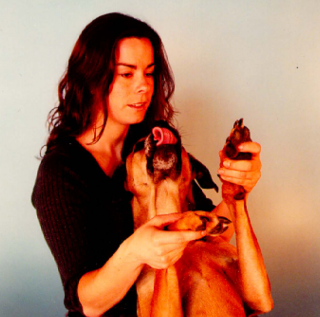
Living with and loving a dog you cannot touch, cuddle, or hug is just about as silly as living with and loving a person you cannot hug. It is also potentially dangerous. Even so, veterinarians and groomers will tell you that hard-to-handle dogs are extremely common. Indeed, many dogs are extremely stressed when restrained and/or examined by strangers. There are few physical differences between hugging and restraint, or between handling and examination. The difference depends on your puppy's perspective. Generally, puppies feel they are hugged and handled by friends, but restrained and examined by strangers.
Veterinarians and groomers simply cannot do their jobs unless your dog remains relaxed and still while being examined. Fearful and aggressive adult dogs and sometimes just plain wriggly adolescent dogs often need to be restrained, tranquilized, or even anesthetized for routine physical examination, teeth-cleaning, and grooming. Restraint makes the procedure much scarier for dogs. Untrained dogs are exposed to the risk of anesthesia, the additional safety precautions consume the veterinarian's time, and hence the owners must pay more money. It is just too silly. Adult humans do not require anesthesia during routine trips to the doctor, dentist, and hairdresser; neither would dogs, if only their owners had taught them to enjoy meeting and being handled by people.
It is simply not fair to allow your puppy to grow up to be wary and anxious around people and afraid of their touch. It is cruel to invite an ultra-social animal to live in the world of humans, yet neglect to teach him to enjoy human company and contact. The poor dog is subjected to a lifetime of psychological torture
It is not sufficient that your pup merely tolerates handling; he must learn to thoroughly enjoy being handled by strangers. A dog that doesn't thoroughly enjoy being restrained and examined by strangers is a time bomb waiting to go off. One day an unfamiliar child will attempt to hug and pet your dog. Your dog may object. Then the child, you, and your dog all have a big problem.
Your puppy needs to be handled by familiar people before unfamiliar people, adults before children, women before men, and girls before boys.
As with the socialization exercises, adult family members need to accustom the pup to enjoy being handled and gently restrained first. Then your puppy knows and enjoys the handling and gentling game before strangers and children become involved. It is quite easy — and thoroughly enjoyable — to teach young puppies to like being handled and examined by people, whereas teaching adolescent and adult dogs to accept handling, especially by children and strangers, can be time-consuming and potentially dangerous. So do not delay. Do it now.
Hugging/Restraint
This is the fun part: you get to hug your puppy. In fact, every family member and all your guests get to hug the puppy. Relaxing with your puppy is a lot of fun, especially if your puppy is relaxed. If he is not relaxed, you are going to teach your puppy to relax, calm down, and thoroughly enjoy a good long cuddle.
Provided your pup was handled frequently prior to weaning and especially neonatally, at eight weeks of age he should go as limp as a noodle whenever picked up, and should settle down as relaxed as a rag doll on your lap. Even if your puppy did not have the benefit of plentiful early handling in his original home, handling exercises are easy at eight weeks of age. However, you had better get started, because in just twelve weeks time, with a hard-to-handle, five-month-old adolescent, the same simple handling exercises will be a completely different story. Untrained adolescent dogs are notoriously difficult to handle.
Pick up your pup, put him on your lap, and hook one finger around his collar so that he doesn't jump off. Slowly and repetitively stroke the pup along the top of his head and back in an attempt to get him to settle down in any position he finds comfortable. If your pup is a bit squirrelly and squirmy, soothingly massage his chest or the base of his ears. Once the pup is completely relaxed, pick up the pup and lay him down on his back for a soothing tummy rub. Massage his belly by making a repetitive circular motion with the palm of your hand. Gently rubbing the pup's inguinal area (where the inside of the thigh joins the abdomen) will also help the puppy relax. While your puppy is calm and relaxed, periodically pick him up to give him a short hug and maybe a kiss on the nose. Gradually and progressively increase the length of the hugs (restraint). After a while, pass the puppy to someone else and have them repeat the above exercises.
Tantrums
Should your pup struggle violently, or especially if he has a tantrum, you must not let go. Otherwise, your puppy will learn that if he struggles or throws a tantrum, he needn't calm down and be handled because the owner gives in. Bad news! With one hand on your pup's collar and the palm of your other hand against the puppy's chest, gently but firmly hold the pup's back against your abdomen. Hold the puppy so that his four legs point away from you and sufficiently low down against your abdomen so that he cannot turn his head and bite your face. Hold the pup until he calms down, which he will eventually do. Continue massaging the pup's ear with the fingers of one hand and his chest with the fingertips of your other hand. As soon as the puppy calms down and stops struggling, praise the pup, and after a few seconds of calm let him go. Then repeat the procedure.
If you have difficulty getting the pup to calm down and enjoy being hugged (restrained) after one day of practice, call a trainer to your home immediately. This is an emergency. You do not want to live with a dog you cannot handle or hug. Contact the Association of Pet Dog Trainers at www.apdt.com to locate a Certified Pet Dog Trainer in your area.
Alpha Rollover???
As I mentioned before, your puppy will not trust and respect you if manhandled and forcibly restrained on his back. He will become more resistant. You'll soon have a puppy that doesn't even enjoy being cuddled because he perceives your hugs as forcible restraint. Be gentle and patient as described above.
Handling/Examination
Teaching your eight-week-old puppy to enjoy being handled and examined is as easy as it is essential. Moreover, your pup's veterinarian, trainer, and groomer will be forever grateful, as will be you and your puppy. It is a truly unfortunate puppy that finds it scary to be handled and examined.
Many dogs have a number of "hot spots," which if not defused in puppyhood can be extremely sensitive to touch. Handling the ears, paws, muzzle, collar area, and rear end often provokes a defensive reaction in an adult dog if these areas have not been desensitized during puppyhood. Similarly, an adult dog may act fearfully or defensively when you stare into his eyes, if as a puppy he was not taught to enjoy direct eye contact.
Some areas become sensitive over time simply because nobody bothers to examine them. For example, few owners regularly inspect their dog's rear end, or open his mouth to examine the teeth. Some areas are naturally sensitive and may provoke a reaction even in puppies. For example, nearly every puppy will bite your hand if you firmly take hold of his leg or paw. Other areas become sensitive because of bad husbandry and mishandling. Dogs with hangy-down ears, which are prone to infection, soon come to associate ear examinations with pain. Similarly, many adult dogs associate being stared at or being grabbed by the collar with bad times. Dogs quickly become hand-shy when people take them by the collar to lead them to confinement, grab them by the collar to put them on leash (ending an otherwise enjoyable play session in the park), or grab them by the collar to punish them for some transgression.
Handling and examination exercises serve to defuse the hot spots and help the puppy form positive associations with being handled. Desensitizing the puppy and teaching him to enjoy handling is simple when combined with handfeeding him kibble. It is so simple, in fact, that it is surprising there are so many hard-to-handle adult dogs.
Use your puppy's daily allotment of kibble as training treats to teach him to enjoy being handled. Take hold of your pup's collar and offer a treat. Gaze into your pup's eyes and offer a treat. Look in one ear and offer a treat. Look in the other ear and offer another treat. Hold a paw and offer a treat. Repeat with each paw. Open his mouth and offer a treat. Feel his rear end and private parts and offer two treats. And then repeat the sequence. Each time you repeat the process, progressively handle and examine each area more thoroughly and for longer periods.
Once your puppy is quite happy being handled and examined by family members, it is time to play Pass the Puppy with your guests. One at a time, have each guest offer the pup a treat, take hold of his collar, look in his eyes, handle and examine his ears, paws, teeth, and rear end, and offer treats as described above before passing the pup (plus the bag of dinner kibble) to the next person.
Few people intend to hurt or frighten a puppy, but accidents happen. For example, a guest may inadvertently step on his paw, or the owner might accidentally grab his hair when reaching for the collar. But if the pup feels secure when being handled, he will be less likely to react defensively.
Grabitis
Twenty percent of dog bites occur when a family member reaches to grab the dog by the scruff or collar. One doesn't need to be a rocket scientist to figure this out. Obviously, the dog has learned that when people grab the collar bad things often happen. Consequently, the dog becomes hand-shy, plays Catch-Me-if-You-Can, or reacts defensively. It is potentially dangerous to have a dog dodge you when you reach for his collar. For example, you need to know you could effectively grab your dog if he ever tried to dash out the front door.
So teach your puppy to enjoy being grabbed by the collar. First, prevent your pup from forming negative associations to human hands, and second, teach your pup that being taken by the collar has only positive consequences.
If you let your puppy play without interruption, and then take him by the collar to end the play session, of course he will come to dislike your reaching for his collar because a collar grab signals the end of the play session. Starting in the house and later in the park, frequently interrupt puppy play sessions by taking your puppy by the collar. Ask him to sit, praise, offer a piece of kibble, and then let him go play again. The puppy thus learns that being taken by the collar is not necessarily the end of the play session. Instead, a collar grab is a short timeout for refreshment and a few kind words from his owner before the puppy gets to play again. Also, every time you interrupt the play session, you may use resumption of play to reward your puppy for sitting and allowing you to take him by the collar.
If you lead or drag your puppy into confinement, he will no doubt come to dislike being taken by the collar, as he will come to dislike confinement. Instead, teach your puppy to enjoy confinement. Stuff a bunch of hollow chewtoys with kibble, put them in your puppy's confinement area, and then close the door with your puppy on the outside. In no time at all, your puppy will beg to go inside. Now simply instruct your pup, "Go to your bed (or crate)" or "Go to your playroom (long-term confinement area)," and open the door. Your pup will happily rush inside and settle down peacefully with his chewtoys.
Above all, promise your puppy that you will never (NEVER) call your puppy and then grab him by the collar to reprimand or punish. Doing this just once will make him hate coming when called and hate when you reach for his collar. If you punish your puppy after he comes to you, he will take longer to come the next time. Eventually slow recalls will become no recalls. Your puppy will still misbehave; only now you will be unable to catch him! If you ever punish your puppy after taking his collar, he will soon become hand-shy, evasive, and defensive.
To prevent your puppy from becoming hand-shy, take hold of his collar and then offer a piece of kibble. Repeat this procedure many times throughout the day, and with each successive trial progressively increase the speed with which you reach for the collar. Your puppy will soon develop a strong positive association with being grabbed and may even look forward to it.
If your puppy is already even a tiny bit hand-shy, the last thing you want to do is reach for his collar. Instead, practice reaching for and handling areas he does not mind having touched, or actually enjoys having touched. Then, gradually and progressively work toward the collar. Start by offering the dog a piece of kibble to let him know the game's afoot. "Not a bad start," thinks the dog. Then touch the tip of his tail and immediately offer another piece of kibble. If it is possible to touch the tip of the tail, then surely it is possible to touch just one inch down from the tip. Give the dog another piece of kibble and touch two inches down, then three inches down, and so on. On each repetition, touch the dog a little closer to his collar. It is only a matter of time before you can reach for and handle the dog's collar without upsetting the dog. When touching the dog's collar the first couple of times, offer one or two pieces of freeze-dried liver.
The key to progressive desensitization is to work slowly. If you even suspect the dog is a little intimidated or uneasy, go right back to square one — in this case, the tip of the tail — and this time work slower.
Adapted from AFTER You Get Your Puppy by Dr. Ian Dunbar
Guarding Valued Objects
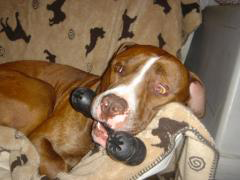
Object-guarding starts during puppyhood . Owners may fail to notice their adolescent dog becoming increasingly possessive and protective. Some may actually encourage their puppy's protective displays, thinking they are cute.
It is natural for dogs to protect their possessions. In the wild, a wolf would hardly pop next door to borrow a cup of bones. Domestic dogs quickly learn that once something is gone, it is gone. So it is not surprising to find dogs trying to keep their possessions away from people.
Bitches are more likely to guard objects than male dogs. In a domestic pack, it is fairly common to see a very low-ranking bitch successfully defend her bone from a relatively high-ranking male dog. In fact, the Bitch's First Amendment to Male Hierarchical Law is "I have it, and you don't!"
With male dogs, object-guarding is more common among middle-ranking insecure male dogs. In fact, nothing better advertises insecurity and lack of confidence than object guarding — definitely not "top dog behavior." In fact, true top dogs are usually confident in their position and are often quite willing to share a bone, toy, or food bowl with lower-ranking individuals.
If you frequently take food or toys away from your puppy and she never gets them back, your pup will learn that relinquishing an object likely means she will never see it again. Understandably, your pup might develop behaviors to keep objects away from you. She may run and hide with the object, hold on tight with her jaws, growl, snarl, and maybe snap.
If you find you are backing down when your puppy is protecting any object, and are at a loss for what to do, seek help from a Certified Pet Dog Trainer immediately. (Check out www.apdt.com) This problem will quickly get out of hand, and soon you will have an adult dog backing you down. Retraining adult dogs that are protective of valued objects is complicated, time-consuming, and not without danger. You will definitely require assistance from an experienced trainer or behavior counselor. On the other hand, preventing this in puppyhood is easy and safe.
First make sure that your puppy develops a strong chewtoy habit. If she always wants to play with her chewtoys, she won’t seek out inappropriate objects that need to be taken away. Additionally, teach your pup to voluntarily relinquish her chewtoys on request.
Basically, you have to teach your puppy that voluntarily relinquishing an object does not mean losing it for good. Your puppy should learn that giving up bones, toys, and tissues means receiving something better in return — praise and treats — and also later getting back the original object.
The Token System — Exchanging Valued Commodities for Treats
Start working with objects that both you and your puppy can hold at the same time, such as a rolled newspaper or a Kong on a rope. Physical contact is a very big part of the possession game. Your puppy is less likely to protect an object if you still have hold of it. However, as soon as you let go, your pup becomes more likely to defend her prize.
As practiced in the previous exercise, tell your puppy "Off" and then "Take it." Waggle the object in front of her muzzle enticingly. Praise your puppy when she takes hold. Do not let go of the object. Say, "Puppy, Thank you," stop waggling the object to encourage your puppy to stop tugging, and with your other hand, waggle a very tasty treat (freeze-dried liver) in front of her nose. Praise your puppy as soon as she opens her mouth and you have regained full possession of the object. Continue praising as you offer one, two, or three treats (maybe luring the puppy to sit or lie down as you do so). Then instruct your pup to take the object again and repeat the procedure. When your puppy has promptly relinquished the object upon request five times in a row, you may let go of the object each time. Now you are ready to work with smaller objects, such as a Kong without a rope, tennis balls, Biscuit Balls, sterilized bones, or other toys. Once your pup eagerly takes and gives promptly, simply drop or toss the object and say, "Thank you." Your pup will pick up the object and drop it in your hand. Voilà! Your very own faithful retriever pup!
Retrieving is a lot of fun and good exercise. It has numerous applications, such as looking for lost keys, fetching slippers, and clearing up dog toys. Most puppies love retrieving and quickly develop confidence about surrendering objects. Puppies think it's a great deal. They temporarily swap their toys for treats, the owner safely holds the toy while they enjoy the treat, and then they get the toy back to exchange for more treats. In fact, some puppies enjoy proffering objects so much that it may become a bother to the owner. If your pup offers too many unsolicited presents, simply instruct her, "Take it to your bed." In fact, this is one of the best ways to teach your puppy to clear up her toys.
By teaching your puppy to retrieve objects, what had intrinsic value as a toy now has additional value as a token that may be exchanged for praise and rewards. Playing fetch with your puppy is a wonderful way to supercharge her toys, increase their effectiveness as lures and rewards for training, and greatly increase the likelihood that a bored puppy will seek out her toys to play with rather than inappropriate household or outdoor articles.
Once the above exchange exercises are working, increase the intrinsic value of the objects by stuffing the Kong or sterilized bone with treats. Before your puppy is ten weeks old, you should also repeat the following confidence-building exercise many times. Even with a ten-week-old puppy, I would advise having an assistant for these exercises. Tie a length of stout string to one end of a meaty bone. Should the pup growl, have your assistant yank on the string to pull the bone away, and quickly cover it with a plastic garbage bucket. The plastic bucket may also be used to cover the pup's food bowl should the pup act up during food bowl exercises.
Don't waste time reprimanding the pup for growling. Instead, make sure to praise and reward your puppy as soon as she stops growling. Additionally, you must make sure that a growling puppy immediately loses her bone or food bowl. Many puppies will initially growl when food is removed. These are not bad dogs; they are normal dogs. Growling is quite natural. However, your puppy must learn that growling doesn't work so that this behavior does not escalate and continue into adolescence. As your puppy develops confidence, she will learn that there is no reason to growl because you have no intention of stealing her food. When the puppy stops growling, praise her, back up, and have her sit and lie down, give her back the object, and then repeat the procedure.
If you have problems with object and food guarding exercises, seek help immediately. Do not wait until your puppy is three months old.
The Food Bowl
Many old-time dog training books advise not going near a dog when it is eating. Whereas it may be sound advice to let a trustworthy adult dog eat in peace, this does not mean letting untrained puppies eat alone. If a pup grows up eating alone, she may not want her mealtimes disturbed as an adult. Eventually, someone is bound to bother the dog when she is eating, whereupon she may respond in a characteristically canine, food-protective fashion and growl, snarl, snap, lunge, and maybe bite.
By all means, tell people not to bother your dog when she is eating, but first be certain your puppy is totally trustworthy around her food bowl. Teach your puppy not simply to tolerate people around her food bowl, but to thoroughly look forward to dinner-time guests.
Hold your pup's bowl while she eats kibble. Offer tasty treats and handle the puppy, and she will learn her dinners are more enjoyable when people are present with petting and treats. Let the puppy eat kibble from her bowl, offer a tasty treat, and then temporarily remove the bowl as the puppy enjoys the treat. Then try removing the bowl prior to offering a treat. Your pup will soon look forward to your removing the bowl and the kibble, since it signals a tasty treat is imminent.
As your puppy is eating dry kibble from her bowl, quickly put your hand in the bowl and offer a tasty treat. Give your puppy time to reinvestigate the dry kibble, to check for more treats, and to recommence eating. Then plunge your hand in the bowl and offer another treat. Repeat the procedure several times. Your pup will soon become accustomed and look forward to sudden hand movements around her food bowl. This exercise impresses puppies to no end — it's like the magician who pulls a flower, an egg, or a dove from behind someone's ear.
Sit with your puppy while she is eating and have family members and friends walk by. Each time someone approaches, spoon a small dollop of canned food on top of the kibble. Your puppy will quickly make the association between approaching people and juicy canned food being added to her kibble. Later, have family and friends approach and toss a treat into the puppy's bowl. Soon your puppy will welcome the dinnertime presence and presents of people.
The Delinquent Waiter Routine
Have you ever been kept waiting for an hour in a restaurant, eating bread and drinking water yet you haven't even ordered? "Where is that waiter? I wish he would hurry over." Well, the delinquent waiter routine prompts the same reaction in puppies. Most will beg you to approach their food bowl.
Weigh out your puppy's dinner kibble in a bowl on the counter and then put the pup's bowl on the floor with only one piece of kibble. Try to capture your puppy's reaction on camera. She will look at the bowl with disbelief. Your pup will look back and forth between you and her bowl, gobble down the one piece of kibble, and then thoroughly sniff the empty bowl. Casually walk away from the bowl and busy yourself. Maybe inquire as to whether or not your puppy enjoyed her dinner. "Was everything to your liking, Ma'am? Are you ready for second course?" Wait until your puppy begs for more, walk over, pick up her bowl, place in one more piece of kibble, wait for the pup to sit, and then put her bowl on the floor.
Your puppy will become calmer and her manners will improve with each "course." Also, by feeding your puppy's dinner in many small courses, you will teach her to welcome your approaches.
Paper Tissue Issues
Years ago, I consulted on a case of a one-year-old dog that stole used Kleenex tissues and irritated her owner by playing Catch-Me-if-You-Can. The dog ran under a bed, the owner poked her with a broomstick, and the dog bit her on the wrist. I have since dealt with many similar cases. For paper-tissue theft to escalate to the point of both owner and dog physically abusing each other is extremely silly. It is essential that you teach your young puppy to exchange rolled newspaper, toilet rolls, or individual paper tissues for food treats so that she does not becomes possessive and protective of paper products. On the other hand, if the dog finds paper tissues intriguing, use them as lures and rewards in training, or give the dog one a day as a toy. And if you don't want your dog to steal paper tissues, flush them down the toilet.
"She's a bit tricky around her food bowl."
It is surprising how many adolescent dogs still display a tendency to guard food and objects, yet their owners do nothing about it. Whereas playful food and object guarding are quite normal, and to be expected, in developing puppies, defensive guarding behavior cannot be allowed in adolescent or adult dogs. It is extremely easy to build your puppy's confidence so that she no longer feels the need to defend her food bowl, bones, and toys from people.
If you ever sense your puppy is even a little bit possessive or protective of any object, do something about it immediately. The requisite confidence-building exercises have all been described above. If you think the problem is beyond your control, seek help immediately while your puppy is still a puppy.
Adapted from AFTER You Get Your Puppy by Dr. Ian Dunbar
Puppy Biting
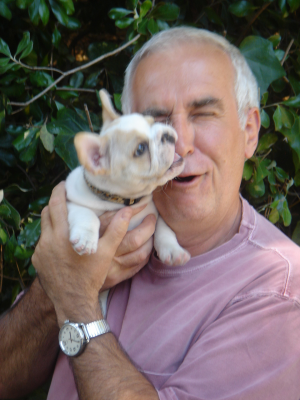
Bite inhibition is the single most important lesson a dog must learn. Adult dogs have teeth and jaws that can hurt and harm. All animals must learn to inhibit use of their weapons against their own kind, but domestic animals must learn to be gentle with all animals, especially people. Domestic dogs must learn to inhibit their biting toward all animals, especially toward other dogs and people. The narrow time window for developing a "soft mouth" begins to close at four-and-a-half months of age, about the time when the adult canine teeth first show. Providing your puppy with an ideal forum to learn bite inhibition is the most pressing reason to enroll him in puppy classes before he is eighteen weeks old.
Bite inhibition does not mean stopping the puppy from biting altogether. On the contrary, puppies must bite in order to learn bite inhibition. Bite inhibition means, learning to inhibit the force of the bites, so they no longer hurt or cause damage.
Puppies bite — and thank goodness they do. Puppy biting is a normal, natural, and necessary puppy behavior. Puppy play-biting is the means by which dogs develop bite inhibition and a soft mouth. The more your puppy bites and receives appropriate feedback, the safer his jaws will be in adulthood. It is the puppy that does not mouth and bite as a youngster whose adult bites are more likely to cause serious damage.
The puppy's penchant for biting results in numerous play-bites. Although his needle-sharp teeth cause painful bites, his weak jaws seldom cause serious harm. The developing puppy should learn that his bites can hurt long before he develops jaws strong enough to inflict injury. The greater the pup's opportunity to play-bite with people, other dogs, and other animals, the better his bite inhibition will be as an adult. For puppies that do not grow up with the benefit of regular interaction with other dogs and other animals, the responsibility of teaching bite inhibition lies with the owner.
After all the socialization and handling exercises during his first month at home, your puppy will be unlikely to want to bite, because he likes people. However, should your dog snap or bite because he has been frightened or hurt, one hopes that he causes little if any damage because he developed good bite inhibition during puppyhood. While it is difficult to socialize a dog and prepare him for every potentially scary eventuality, it is extremely easy to ensure that as a puppy he develops reliable bite inhibition.
Even when provoked to bite, a dog with well-established bite inhibition seldom breaks the skin. As long as a dog's bite causes little or no damage, behavioral rehabilitation is comparatively easy. But when your dog inflicts deep puncture wounds as an adult, rehabilitation is much more complicated, time-consuming, and potentially dangerous.
Good bite inhibition is the most important quality of any companion dog. Moreover, a dog must develop bite inhibition during puppyhood, before he is four-and-a-half months old.
Do you want to learn more about puppy biting? Join The Top Dog Academy. You'll find videos, worksheets, podcasts and more! When you join the Top Dog Academy you also get access to personalized email support so you can train your puppy yourself. Use this link to get your first month for free.
Human Bite Inhibition?
No dog is perfectly behaved, but luckily, most dogs are pretty well-socialized and have pretty good bite inhibition. Most dogs are basically friendly, even though they may occasionally be fearful and wary of some people some of the time. Also, although many dogs have growled, lunged, snapped, or even nipped someone at some time in their lives, very few dogs have ever inflicted any appreciable damage.
Perhaps a human analogy will help illustrate the crucial importance of bite inhibition. Few people can honestly say that they have never had a disagreement, never had an argument, or never laid a hand on someone in anger (especially when considering siblings, spouses, and children). However, very few people have ever hurt another person so badly that they had to be admitted to the hospital. Thus, most people freely admit that they are sometimes disagreeable, argumentative, and prone to physical violence. Even so, very few people have injured another person. Dogs are no different. Most dogs have several disagreements and arguments each day. Many dogs have been involved in full-contact fights at some time in their lives. But very, very few dogs have ever severely injured another dog or a person. This is the importance of bite inhibition.
Bite Inhibition with Other Dogs
Dogfights offer a wonderful illustration of the effectiveness of solid bite inhibition. When dogs fight, it usually sounds like they are tying to kill each other, and it appears they forcibly bite each other over and over. However, when the dust settles and the dogs are examined, 99 percent of the time there are no puncture wounds whatsoever. Even though the fight was a frenzied flurry of activity and both dogs were extremely worked up, no harm was done because both dogs had exquisitely fine-tuned bite inhibition, acquired during puppyhood. Puppies teach each other bite inhibition when play-fighting, their number one favorite activity.
Unless there are vaccinated adult dogs at home, your puppy must live within a temporary doggy social vacuum and dog-dog socialization must be postponed for a while. Until your puppy has acquired sufficient active immunity, it is too risky to allow him to socialize with dogs of dubious immunization history, or with dogs that have been in contact with the urine and feces of dogs potentially infected with parvovirus and other serious puppy diseases. However, as soon as your puppy has developed sufficient immunity to safely venture outdoors — at three months of age, at the earliest — catching up on dog-dog socialization is urgent. Enroll your puppy in puppy classes right away and take him for walks and to the local dog park several times a day. You will thank yourself for years to come. There is no greater enjoyment than watching your dog-friendly adult dog enjoy playing with other dogs.
Bite inhibition, however, cannot be put on hold. If there are no other dogs at home for your puppy to play with, you have to teach your puppy bite inhibition until he is old enough to go to puppy classes.
Bite Inhibition with People
Even if your puppy has a couple of canine buddies at home, you will still need to teach your puppy to inhibit the force and frequency of his bites toward people. Additionally, you must teach your puppy how to react when frightened or hurt by people. He should by all means yelp, but he should not bite and he should never bear down.
Even if your dog is friendly and mouths gently, by five months of age at the very latest, he must be taught never to touch any person's body or clothing with his jaws unless requested. Whereas mouthing is essential for puppies and acceptable from a young adolescent dog, it would be utterly inappropriate for an older adolescent or adult dog to mouth visitors and strangers. It would be absolutely unacceptable for a six-month-old dog to approach a child and take hold of her arm, no matter how gentle, friendly, and playful the dog's intentions. It would frighten the living daylights out of the child, to say nothing of her parents.
Out-of-Control Play Sessions
Some owners, especially adult males, adolescent males, and boys, quickly let play-mouthing sessions get out of control. This is why many dog-training texts recommend not indulging in games such as play-fighting or tug-of-war. The whole point about playing these games is to improve your control. And if you play these games by the rules, you will soon have excellent control over your puppy's mouthing behavior, vocal output, energy level, and activity. However, if you do not play by the rules, you will soon have an adult dog that is dangerously out-of-control.
I have a simple rule with my dogs: no one is allowed to interact or play with them unless they have demonstrated that they can get them to come, sit, lie down, speak, and shush. This rule applies to everyone, especially family, friends, and visitors, that is, the people most likely to ruin your dog's behavior. For active games, such as tug-of-war and play-fighting, I have an additional rule: No one may play with the dogs unless at any time they can immediately get the dog to stop playing and sit or lie down.
Practice "Off," "Sit," and "Settle Down" many times during your puppy's play sessions, and you will soon have an easily controllable adult dog, one that has learned to listen to you no matter how excited and worked up he may be. Do not play with your pup without frequent interruptions. Have short timeouts at least every fifteen seconds or so to check that you're in control and can easily and quickly get the puppy to let go, calm down, and settle down. The more you practice, the more control you'll have.
Puppies with Soft Mouths
Many gundog breeds, especially Spaniels (and especially the nice Spaniels), have extremely soft mouths as puppies and therefore receive limited feedback that their jaws can hurt. If a puppy does not frequently mouth, bite, and does not occasionally bite hard, this is serious. The puppy must learn his limits, and he can only learn his limits by exceeding them during development and receiving the appropriate feedback. Again, the solution lies with puppy classes and off-leash play sessions with other puppies.
Puppies That Don't Bite
Shy dogs seldom socialize or play with other dogs or strangers. Hence they do not play-bite, nor do they learn to reduce the force of their bites. The classic case history describes a dog that didn't mouth or bite much as a pup and never bit anyone as an adult — until an unfamiliar child tripped and fell on the dog while he was gnawing on a bone. Not only did the dog bite, but his first bite left deep puncture wounds because he had developed no bite inhibition. With shy puppies, socialization is of paramount importance and time is of the essence.
Similarly, some Asian breeds have an extremely high degree of fidelity toward their owners, and, consequently, tend to be fairly standoffish with other dogs or human strangers. Some restrict their mouthing and biting to members of the family, and some simply do not mouth at all. Hence, they never learn to inhibit the force of their jaws.
Non-biting puppies must be socialized immediately. They must commence play-fighting and play-biting well before they are four-and-a-half months old. Initiating play, socialization and learning bite inhibition are all best accomplished by promptly signing up for puppy classes.
Speed of Development
The large working dog breeds develop slowly and, as long as they have not developed problems, may delay starting puppy classes until they are four months old. But they must start classes by four-and-a-half months. Smaller breeds, however, especially cattle dogs, develop much faster, and waiting until they are four months old is too late. Cattle dogs, working sheep dogs, toys, and terriers all need to be enrolled in puppy classes by three-and-a-half months of age.
Of course, regardless of the size and speed of development of your puppy, to get the most out of his formal education, enroll in a class when your puppy is three months old and then enroll in a second puppy class when he is four-and-a-half months old.
Do you want to raise the perfect puppy?
Learn more about puppy biting with The Best Online Puppy Training Programs:
The Top Dog Academy. Learn how to deal with puppy biting, crate training, toilet training, socialization and more with videos, worksheets and podcasts about puppy training. When you join the Top Dog Academy you also get access to personalized email support so you can train your puppy yourself. Use this link to get your first month for free.
SIRIUS Puppy Training. Looking for more support? Get personalized, real-time, video dog training guidance from an expert SIRIUS Puppy Training instructor. Dr. Dunbar's SIRIUS Puppy & Dog Training classes revolutionized the world of pet dogs when they were first created. Now, our online small-group classes allow you to get the expert assistance you need from the comfort of your home.
Teaching Bite Inhibition
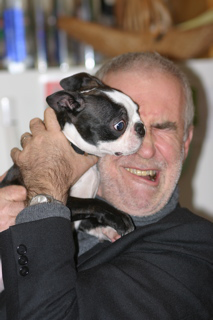
Please read this section extremely carefully. I shall repeat over and over: teaching bite inhibition is the most important aspect of your puppy's entire education.
Certainly puppy biting behavior must eventually be eliminated. We cannot have an adult dog playfully mauling family, friends, and strangers in the manner of a young puppy. However, it is essential that this be done gradually and progressively via a systematic two-step process: first, to inhibit the force of puppy bites and second, to lessen the frequency of puppy mouthing.
Ideally, the two phases should be taught in sequence, but with more active puppy biters you may wish to work on both stages at the same time. In either case, you must teach your puppy to bite or mouth gently before puppy biting behavior is eliminated altogether
Inhibiting the Force of Bites
The first step is to stop your puppy from hurting people: to teach him to inhibit the force of his play-bites. Physical punishments are certainly not called for. But it is essential to let your puppy know that bites can hurt. A simple "Ouch!" is usually sufficient. When the puppy backs off, take a short time-out to "lick your wounds," instruct your pup to come, sit, and lie down to apologize and make up and then, resume playing. If your puppy does not respond to your yelp by easing up or backing off, an effective technique is to call the puppy a "Bully!" and then leave the room and shut the door. Allow the pup a minute or two time-out to reflect on the association between his painful bite and the immediate departure of his favorite human playmate. Then return to make up. It is important to show that you still love your puppy, only that his painful bites are objectionable. Have your pup come and sit and then resume playing once more.
It is much better for you to walk away from the pup than to physically restrain him or remove him to his confinement area at a time when he is biting too hard. So make a habit of playing with your puppy in his long-term confinement area. This technique is remarkably effective with lead-headed dogs, since it is precisely the way puppies learn to inhibit the force of their bites when playing with each other. If one puppy bites another too hard, the bitee yelps and playing is postponed while he licks his wounds. The biter soon learns that hard bites interrupt an otherwise enjoyable play session. He learns to bite more softly once play resumes.
The next step is to eliminate bite pressure entirely, even though the "bites" no longer hurt. While your puppy is chewing his human chewtoy, wait for a bite that is harder than the rest and respond as if it really hurt, even though it didn't: "Ouch, you worm! Gennntly! That really hurt me, you bully!" Your puppy begins to think, "Good Heavens! These humans are soooooo sensitive. I'll have to be really careful when mouthing their delicate skin." And that's precisely what you want your pup to think: that he needs to be extremely careful and gentle when playing with people.
Your pup should learn not to hurt people well before he is three months old. Ideally, by the time he is four-and-a-half months old — before he develops strong jaws and adult canine teeth — he should no longer be exerting any pressure when mouthing.
Decreasing the Frequency of Mouthing
Once your puppy has been taught to mouth gently, it is time to reduce the frequency of mouthing. Your pup must learn that mouthing is okay, but he must stop when requested. Why? Because it is inconvenient to drink a cup of tea or to answer the telephone with fifty pounds of wriggling pup dangling from your wrist. That's why.
It is better to first teach "Off" using food as both a distraction and a reward. The deal is this: once I say "Off," if you don't touch the food treat in my hand for just one second, I'll say, "Take it" and you can have it. Once your pup has mastered this simple task, up the ante to two or three seconds of non-contact, and then to five, eight, twelve, twenty, and so on. Count out the seconds and praise the dog with each second: "Good dog one, good dog two, good dog three," and so forth. If the pup touches the treat before you are ready to give it, simply start the count from zero again. Your pup quickly learns that once you say "Off," he can not have the treat until he has not touched it, for, say, eight seconds, so the quickest way to get the treat is not to touch it for the first eight seconds. In addition, regular hand-feeding during this exercise encourages your pup's soft mouth.
Once your pup understands the "Off" request, use food as a lure and a reward to teach it to let go when mouthing. Say, "Off" and waggle some food as a lure to entice your pup to let go and sit. Then praise the pup and give the food as a reward when he does so.
The main point of this exercise is to practice stopping the pup from mouthing, and so each time your puppy obediently ceases and desists, resume playing once more. Stop and start the session many times over. Also, since the puppy wants to mouth, the best reward for stopping mouthing is to allow him to mouth again. When you decide to stop the mouthing session altogether, say, "Off" and then offer your puppy a Kong stuffed with kibble.
If ever your pup refuses to release your hand when requested, say, "Bully!" rapidly extricate your hand from his mouth, and storm out of the room mumbling, "Right. That's done it! You've ruined it! Finished! Over! No more!" and shut the door in his face. Give the pup a couple of minutes on his own to reflect on his loss and then go back to call him to come and sit and make up before continuing the mouthing game.
By the time your pup is five months old, he must have a mouth as soft and reliable as a fourteen-year-old working Labrador Retriever: your puppy should never initiate mouthing unless requested; he should never exert any pressure when mouthing; and he should stop mouthing and calm down immediately upon request by any family member.
Whether or not you allow your adult dog to mouth on request is up to you. For most owners, I recommend that they teach their dog to discontinue mouthing people altogether by the time he is six to eight months old. However, it is essential to continue bite inhibition exercises. Otherwise, your dog's bite will begin to drift and become harder as he grows older. It is important to regularly handfeed your dog and clean his teeth each day, since these exercises involve a human hand in his mouth.
For owners who have good control over their dog, there is no better way to maintain the dog's soft mouth than by regular play-fighting. However, to prevent your puppy from getting out of control and to fully realize the many benefits of play-fighting, you must play by the rules and teach your dog to play by the rules.
Play-fighting teaches your puppy to mouth only hands, which are extremely sensitive to pressure, but never clothing. Shoelaces, ties, trousers, and hair have no nerves and cannot feel. Therefore you cannot provide the necessary feedback when your pup begins to mouth too hard and too close to your skin. The play-fighting game also teaches your dog that he must adhere to rules regarding his jaws, regardless of how worked up he may be. Basically, play-fighting gives you the opportunity to practice controlling your puppy when he is excited. It is important to establish such control in a structured setting before real-life situations occur.
Want to raise the perfect puppy?
Learn more about puppy training with The Best Online Puppy Training Programs:
The Top Dog Academy. Learn how to deal with puppy biting, and how to teach bite inhibition with videos, worksheets and podcasts about puppy training. When you join the Top Dog Academy you also get access to personalized email support so you can train your puppy yourself. Use this link to get your first month for free.
SIRIUS Puppy Training. Looking for more support? Get personalized, real-time, video dog training guidance from an expert SIRIUS Puppy Training instructor. Dr. Dunbar's SIRIUS Puppy & Dog Training classes revolutionized the world of pet dogs when they were first created. Now, our online small-group classes allow you to get the expert assistance you need from the comfort of your home.
Common Excuses For Not Socializing Your Puppy
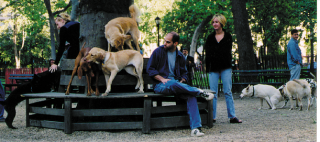
"Our last dog was perfectly trustworthy."
Maybe you were just lucky and picked a born-to-be-perfect puppy. Or maybe you were an excellent trainer. But can you still remember what you did back then and do you still have the time to do it?
"Our last dog just loved kids!"
One young family doted on their first dog and devoted a lot of time to his training. The whole family attended puppy classes and held puppy parties at home for the children's friends. So many children spent time playing games and reward-training the dog, that of course the dog loved children. The dog enjoyed his sunset years proudly watching the children grow up and graduate from high school. By the time the parents got their second dog, the children had all left the nest. The new puppy grew up in a world without children. All went well for many years — that is, until grandchildren appeared on the scene.
"He's fine with me."
Wonderful! Certainly the first step of socialization is to make sure the puppy is perfectly friendly with the family. But it is imperative that the pup become Mr. Sociable with friends, neighbors, visitors, and strangers so that he does not object to being examined by the veterinarian or playfully grabbed and hugged by children.
"Our pup gets more than enough socialization with our family."
Not true! In order to be accepting of strangers as an adult, your puppy needs to meet at least three unfamiliar people each day, not the same people over and over again.
"I don't have any friends to help me socialize my puppy."
Well, you soon will. Socializing your puppy will do wonders for your social life. Invite your neighbors over to meet the pup. Invite people over from work. Check out the puppy classes in your area and invite over some puppy owners from there. They will more than appreciate the problems you are about to encounter in the future. If you cannot get people to come to your home to meet the puppy, take him to safe places to meet people. Do not put him on the ground in public places that may have been frequented by unvaccinated adult dogs until he is at least three months old and current with his vaccinations. Buy a soft carrier and take your puppy on errands: for example, to the bank, the bookstore, or hardware store. See if you can take your puppy to work. Later on, you will be able to take your pup to puppy classes, to dog parks, and on neighborhood walks. But he needs to meet lots of people right away. So whatever you do, do not keep your puppy a secret.
"I don't want my dogs to accept food treats from strangers."
Perhaps your concern is that someone may poison the dog. As a rule, dogs are only poisoned when left alone in backyards — because they are not housetrained and therefore cannot be left safely indoors — or when let loose to range and roam. But you are not inviting dog-hating strangers to interact with your puppy. Instead, you are inviting over selected family, neighbors, and friends. Regardless, every puppy should be taught never to touch or take any object, including food, from any person's hand unless first the puppy hears "Rover, Take it," or some such command. Having learned these basic manners, your dog will only accept food from people who know his name and who know the appropriate take it command — namely, from family and friends.
"I don't want my dog to like strangers. I want him to protect me."
Oh, come on … try telling that to your veterinarian, or to your children's friends' parents. However, if you mean you want your dog to perform some protective function, that's a different matter. But surely you are not going to leave it up to a poorly socialized dog to make decisions regarding whom to protect, whom to protect against, and how to protect. Any good protection dog has first been super-socialized to the point of total confidence, and then carefully taught how, when, and whom to protect. Training your dog to bark or growl on command is a more than sufficient protective deterrent. Your dog may be taught to vocalize in certain situations: for example, when somebody steps onto your property or touches your car. Alarm barkers are extremely effective deterrents, especially if they do not bark when people simply walk by your house or car.
"I don't have the time."
Then give the puppy to someone who does have the time! This puppy may still be saved if someone is willing to take the time to socialize him.
"I need to dominate my pup to get him to respect me."
Not necessarily. Or, not at all. If you physically force and dominate your puppy, he won't respect you. He may heed your commands — grudgingly and fearfully — but he certainly won't respect you. More likely, your dog will grow to resent you.
Besides, there are easy and enjoyable ways to get your dog to show respect. Years ago in one of my puppy classes, I remember a young couple who had a four-year-old daughter named Kristen and a Rottweiler named Panzer. In class, Kristen had the dog better trained than her parents and could consistently get Panzer to come, sit, lie down, and roll over. Kristen would give Panzer a tummy rub when he was lying on his side and he would raise his hind leg to expose his belly. Kristen would talk to Panzer in a squeaky little voice. Kristin squeaked, and Panzer did what she asked. Or, we could say that Kristen requested and Panzer agreed. Or, that Kristen commanded and Panzer obeyed. More important, though, Panzer happily and willingly complied. And when it comes to children training dogs, happy willing compliance is the only kind of compliance that is safe and makes sense. Was Kristen dominating Panzer? Absolutely! But in a much more effective way than by using brute force. As a child, Kristen had to use brain instead of brawn to control Panzer's behavior. Kristen mentally dominated Panzer's will.
Kristen's training engendered Panzer's respect and friendship. Panzer respected her wishes. Also, by approaching promptly off-leash, Panzer demonstrated that he liked Kristen. By sitting and lying down, Panzer showed that he really liked Kristen and wanted to stay close to her. By rolling over, Panzer displayed appeasement. And by lifting his leg to expose his inguinal area, Panzer displayed deference. In doggy language, exposing the inguinal region means, "I am a lowly worm. I respect your higher rank, and I would like to be friends." If you want your puppy to respect you, lure/reward train him to come, sit, lie down, and roll over. If you want your puppy to show deference, teach him to lick your hand or shake hands. Licking and pawing are both active appeasement gestures — signs of wanting to be friends. If you would like your puppy to show doggy deference, tickle his goolies when he is lying on his side and watch him raise his hind leg to expose his inguinal area.
"Dogs of this breed are particularly hard to handle."
Using this excuse to give up on handling, gentling, and socialization exercises is too silly for words. If your research on dog breeds has convinced you that you truly have a difficult breed, you should double or triple the socialization and handling exercises, wind back all developmental deadlines, and start each batch of exercises earlier. Strangely enough, though, I have heard this excuse given for just about every breed of dog. As soon as you think that your chosen breed is too much dog for you, seek help immediately. Find a trainer who can teach you how to handle your puppy before you cause irreparable damage to his temperament.
"My spouse/significant other/parent/child selected the most dominant pup in the litter."
Did you remember the cardinal rule of puppy selection, that all family members completely agree? Well, it's a bit late for that now, and so I would suggest the same advice as above. As soon as you suspect you have a difficult pup, double or triple the socialization and handling exercises and start each batch of exercises earlier. Additionally, you might consider learning how to train your spouse, significant other, parent, or child.
"Something is genetically wrong with the puppy."
Same advice as above: as soon as you suspect your puppy has some kind of organic problem, double or triple the socialization and handling exercises and start each batch of exercises earlier. It's a bit late for genetic screening, and, in any case, what else can you do —t weak the dog's genes? Many people use breed, dominance, or organic conditions as an excuse to give up on the pup — and as an excuse to not socialize and train him. In reality, socialization and training is the puppy's only hope. Your puppy needs socialization and training. Lots of it! Right away! Regardless of breed and breeding, and regardless of your puppy's socialization and training prior to coming to your home, as of right now, any change in your puppy's temperament, behavior, or manners is completely dependent on how you socialize and train him. Work with your puppy and he will get better. Don't work with your puppy and he will get worse. Your puppy's future is entirely in your hands.
"He's just a puppy!" or, "He's sooooo cute!" or, "He's only playing!" or, "He'll grow out of it!"
Of course your puppy is only playing — play-barking, play-growling, play-biting, play-fighting, play-protecting a bone, or playing tug-of-war. If you just laugh at him, your pup will continue playing the aggression game as he grows older, and in no time at all, your fully grown adult dog will be playing for real. Puppy play is all important. Play is essential if a puppy is to learn the social relevance of the vast jumble of behaviors in his doggy repertoire, specifically the appropriateness and inappropriateness of each behavior in each setting. In a sense, play enables a pup to learn what he can get away with. What you need to do is teach your puppy the rules of the game. And the more rules he learns in puppyhood, the safer he will be as an adult dog. Puppy barking and growling are quite normal and acceptable, just as long as you can stop the noise when you wish. Stopping an eight-week-old puppy from barking or growling is pretty easy. Be still yourself, so the puppy may calm down more easily. Say, "Puppy, Shush!" and waggle a food treat in front of his nose. Say, "Good dog," and offer the treat when the pup eventually shushes. Similarly, tug-of-war is a normal and acceptable game, just as long as your pup never initiates the game and you can get the pup to release the object and sit at any time. Both are easy rules to teach to an eight-week-old puppy. When playing tug-of-war, instruct your puppy to release the object and sit at least every minute. Periodically stop tugging, say, "Thank you," and waggle a food treat in front of his nose. When the puppy releases the object to sniff the treat, praise him, and ask him to sit. When he sits, praise him profusely, offer the food treat, and then resume the game.
Euphemism, Litotes, and Other Outrageous Silliness! "He takes a while to warm to strangers!" "He's not overly fond of children!" and "He's a bit hand-shy!"
How can anyone live with a dog knowing that he is stressed by the presence of strangers and children and scared of human hands? The poor dog must be in a state of extreme anxiety. Just how many times does this dog have to beg, implore, and warn you that he feels uncomfortable around strangers and children and doesn't like people reaching for his collar? This is simply an accident waiting to happen. What if an unfamiliar child should reach for the dog's collar, possibly around the dog's food bowl, when the dog is having a bad-hair day and not feeling good? A dog bite for sure. What will we say? That the dog bit without warning and without reason? The poor dog had at least five good reasons to bite: (1) a stranger, (2) a child, (3) reaching for his collar, (4) proximity to his food bowl, and (5) not feeling good. And the dog had been warning his family repeatedly for some time. If there is anything that upsets your puppy, desensitize him to that specific stimulus or scenario immediately. Help your puppy build his confidence so that he may approach everyday events without stress or fear. The required confidence-building exercises have all been described. Use them!
Adapted from AFTER You Get Your Puppy by Dr. Ian Dunbar
Puppy Outside the Home
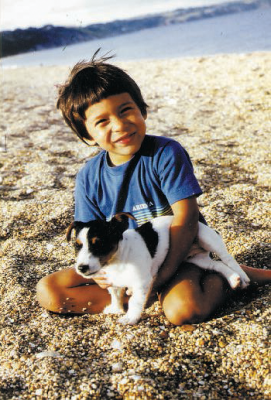
Once your puppy has received the proper vaccinations, it’s time to explore and enjoy the great outdoors and to continue socialization in puppy classes, dog parks and dog walks. Make sure to incorporate training into all of your puppy’s favorite activities; train your puppy on walks, in the car and in the park.
The most urgent priority is to continue socializing your puppy to a wide variety of experiences and people, especially children, men, and strangers. Well-socialized puppies grow up to be wonderful companions, whereas antisocial dogs are difficult, time-consuming, and potentially dangerous. Your puppy needs to learn to enjoy the company of all people and to enjoy being handled by all people, especially children and strangers.
The most important priority is that your puppy learns to perfect reliable bite inhibition and develops a soft mouth before he is eighteen weeks old. Whenever a dog bites a person or fights with another dog, the seriousness of the problem depends on the seriousness of the injury. Hence, the ease and success of retraining depends almost entirely on the dog's degree of bite inhibition. The reliability of your dog's bite inhibition determines whether you have a minor problem which may be easily corrected with a few safe, basic training exercises, or whether you have a serious and potentially dangerous problem which is going to be extremely difficult to resolve.
In a perfect world, you will successfully socialize your puppy so that he thoroughly enjoys the company and actions of all people, all dogs, and all animals. More realistically, though, accidents happen. Someone accidentally shuts the dog's tail in the car door. Someone runs to answer the telephone and accidentally treads on a sleeping dog's leg. A child runs and trips and falls on top of the dog while he is gnawing on a bone. When dogs are hurt or startled, their natural response is to snap, lunge, and even bite. Even wonderfully friendly dogs may feel inclined to protect or defend themselves when picked on by other dogs and people.
For example, when hurt or frightened a dog may snap and lunge at a person. But if a dog has well-established bite inhibition it is unlikely his teeth will even touch the skin. Or if there is skin contact, it is unlikely that the teeth will break the skin. The dog has caused no damage. On the other hand, if the dog has inadequate bite inhibition and his teeth puncture the skin, then you have a serious situation which may be difficult and time-consuming to resolve.
Similarly, dogs with well-established bite inhibition never cause damage when fighting with other dogs. The problem is minor because your dog is simply squabbling in a socially acceptable manner. On the other hand, if your dog ever hurts another dog or another animal, you have a major problem and resolution is unlikely.
Bite inhibition must be established in puppyhood, before eighteen weeks of age, since it is difficult to instill bite inhibition in an adolescent or adult dog. Learning the skills and techniques to ensure your puppy develops a reliable bite inhibition and an ultra-soft mouth is the primary reason for you to attend off-leash puppy classes. Your puppy needs to play with other puppies. Playing with adult dogs at home or in the park is simply not sufficient.
The most enjoyable priority of dog ownership is to accustom your well-socialized, soft-mouthed puppy to the world at large and prevent the development of predictable adolescent problems, thus assuring that he remains well-socialized and soft-mouthed. Remember, your dog will only remain sociable if he continues meeting and greeting unfamiliar people and unfamiliar dogs every day. Meeting the same people and dogs over and over is not sufficient. You want your dog to practice the art of meeting and getting along with strangers, not simply getting along with old friends. Consequently, regular walks with your dog are as essential as they are enjoyable.
Your life is about to change. You are about to enjoy all the joys of dog ownership — long, energetic, or relaxing walks, trips in the car, afternoons in the dog park, picnics on the beach, plus so many enjoyable organized doggy activities.
Continued Socialization
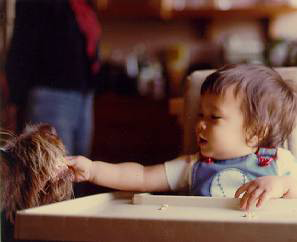
Training a dog to be people-friendly and especially to enjoy the company of his immediate human family is the second most important item in your puppy's education — much more important than socializing him to other dogs. (And as we all know by now, the most important item in your puppy's educational curriculum is teaching bite inhibition.) Although a few common sense precautions make it possible to live quite happily with a dog that does not get along with other dogs, it can be extremely difficult and even dangerous to live with a dog that does not like people — especially if he doesn't like family members! So people-friendliness is a much more important doggy quality than dog-friendliness. But it is truly wonderful when a dog is dog-friendly, having had ample opportunity to meet and play with other dogs on walks and in dog parks.
Unfortunately, few suburban dogs are regularly walked or even given the opportunity to interact with other dogs. For many dog owners, dog-friendliness is simply not a top priority. On the other hand, for owners who consider dog-friendliness important, in fact a major reason for having a dog, their dogs are presumably walked and/or taken to dog parks regularly and so are likely to grow up to be sociable with other dogs. But even for these dogs, people-friendliness is much more important than dog-friendliness, because every day when walked or taken to a park, they are likely to meet many strangers, often children. Most puppy classes are family-oriented, so your pup will have opportunities to socialize with all sorts of people — men, women, and especially, children. And then there is the training game. It will blow your mind just how much your puppy learns in his very first lesson.
Dogs learn to come, sit, and lie down when requested, to stand still and roll over for examination, to listen to their owners, and to ignore distractions. Additionally, of course, puppy classes are an absolute blast! You will never forget your pup's first night in class. Puppy classes are an adventure, both for you and for your dog. Remember, you are attending puppy class for you to learn! And there's still an awful lot to learn. You'll pick up numerous useful tips for resolving behavior problems. You'll learn how to control the rambunctiousness that is inevitably part and parcel of doggy adolescence. But, most important of all, you'll learn how to control your puppy's biting behavior.
Puppy Classes
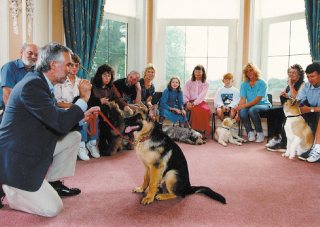
Check out the new videos from SIRIUS Dog Training on the new SIRIUS Berkeley Puppy 1 page.
As soon as your puppy is three months old, there is an urgent need to play catch-up in terms of socialization and confidence building with other dogs. At the very latest, before he is eighteen weeks old, your pup should start puppy training classes.
Four-and-a-half months marks a critical juncture in your dog's development, the point at which he changes from puppy to adolescent, sometimes virtually overnight. You certainly want to be enrolled in class before your pup collides with adolescence. I cannot overemphasize the importance of placing yourself under the guidance and tutelage of a professional pet dog trainer during your dog's difficult transition from puppyhood to adolescence.
Puppy classes allow your pup to develop canine social savvy while playing with other puppies in a nonthreatening and controlled setting. Shy and fearful pups quickly gain confidence in leaps and bounds and bullies learn to tone it down and be gentle.
Puppy play sessions are crucially important. Play is essential for pups to build confidence and learn canine social etiquette, so that later on as socialized adult dogs they would much rather play than either fight or take flight. If not sufficiently socialized as puppies, dogs generally lack the confidence to have fun and play as adults. Moreover, once they are fearful or aggressive as adults, dogs can be difficult to rehabilitate. Luckily, these potentially serious problems with adult dogs are easily prevented in puppyhood, simply by letting puppies play with each other. So give your puppy this opportunity. It's not fair to condemn your dog to a lifetime of social worry and anxiety by denying him the opportunity to play during puppyhood.
This is not to say that a socialized dog will never spook or scrap. A socialized dog may be momentarily startled, but he gets over it quickly. Unsocialized dogs do not. Also, socialized dogs, which have encountered all sizes and sorts of dogs, are better equipped to deal with occasional encounters with unsocialized or unfriendly dogs.
The Ultimate Reason for Puppy Class
The number one reason for attending puppy class is to provide your puppy with the very best opportunity to fine-tune his bite inhibition. Whether your puppy is still biting you too much and harder than you would like, or whether he is biting less than necessary to develop reliable bite inhibition, puppy play sessions are the essential solution. Other puppies are the very best teachers. They say, "Bite me too hard and I'm not going to play with you anymore!" Since puppies want to spend all their time play-fighting and play-biting, they end up teaching other puppies bite-inhibition.
Classes of young puppies of about the same age generate high energy and activity levels, pretty much on par with groups of children who are of similar age. Each puppy stimulates the others to give chase and play-fight, such that the frequency of bites during puppy play is astronomical. Moreover, each puppy tends to rev up all the others, such that the physical nature of the play and the force of play-bites periodically increase to the point where one puppy predictably bites another too hard and receives the appropriate feedback. A young puppy's skin is extremely sensitive, so pups are likely to provide immediate and convincing feedback when bitten too hard. In fact, a pup is likely to receive better feedback regarding the force of his bites during a single one-hour puppy class than he would all week from his owners at home. Moreover, much of the pup's bite inhibition with other dogs will generalize to good bite inhibition with people, making the pup easier to train and control at home.
Now, as mentioned earlier, even well-socialized dogs may have occasional disagreements and squabbles. After all, who doesn't? But just as we have learned how to resolve disagreements with each other and with our dogs in a socially acceptable manner without tearing flesh or breaking bones, so can socialized dogs. Although it is unrealistic to expect dogs never to squabble and scrap, it is absolutely realistic to expect dogs to settle their differences without mutilating people or other dogs. It all depends on the level of bite inhibition they develop while mouthing other puppies in play. So get your puppy enrolled in puppy class right away. Have him develop a supersoft mouth so that all his woofs are friendly and furry.
"But our puppy’s great with our other dog at home."
Your puppy may be Mr. Sociable with your other dog, but you're in for a shock when your puppy goes out alone, whether for a walk on the street, to a dog park, or to training class. You will quickly find that your dog is not socialized at all. Instead he will likely run and hide and defensively growl, lunge, and snap. Your puppy may appear to be extremely well-socialized and friendly at home, but he is only socialized and friendly to one dog. Also, he has likely become overdependent on one dog, and when he goes out alone for the first time, he will fall apart, missing the security and company of his best friend and bodyguard, your other dog. Socialization requires meeting a variety of dogs. To keep a socialized puppy socialized, he needs to meet unfamiliar dogs every day. So walk your puppy and take him on regular trips to dog parks. And be sure to enroll him in puppy classes.
Looking for a Puppy Class
One hopes you will have checked out a variety of classes before you get your puppy so that you will have a pretty good idea of what you are looking for. But here are a few tips: Avoid puppy classes that advocate the use of any metal collar or any means of physical punishment that frightens, harms, or causes pain to your pup. Push-pull, leash-jerk, grab-and-shake, alpha rollover, and domination techniques are largely ineffective, besides being adversarial and sometimes downright unpleasant. These out-of-date methods are now, thank goodness, by and large a thing of the past.
Remember, this is your puppy. His education, safety, and sanity are in your hands. There are so many good puppy schools. Search until you find one.
Look for puppy classes where the pups are given ample opportunity to play together off-leash and where pups are frequently trained and settled down during the play session, using toys and treats and fun and games. Off-leash puppy play is vital, but equally as important, the play session must include many short training interludes, so owners may practice controlling their pup when he is worked up and distracted. Look for classes where puppies learn quickly and owners are pleased with their puppies' progress. And above all look for classes where the trainer, puppies, and owners are all having a good time!
You be the judge, and judge wisely. Choosing a suitable puppy class is one of your most important puppy husbandry decisions.
To locate Certified Pet Dog Trainers in your area contact the Association of Pet Dog Trainers.
"The vet says our puppy is too young for class."
Understandably, veterinarians care about the physical health of their patients. Common and serious infectious diseases such as parvovirus and distemper are a big concern with young puppies, which require a series of immunizations to produce solid immunity. A puppy's risk of infection depends on his level of immunity and the infectiousness of the environment.
A puppy's acquired immunity increases with successive immunizations to around 70–75 percent immunity by three months of age and approximating 99 percent immunity at five months of age. Different environments range from relatively safe to extremely hazardous. But no animal is 100 percent immune to disease, and no environment is 100 percent safe. The safest environments are indoors (homes and puppy classes) and private outdoor property (fenced yards). Sidewalks and dog parks are potentially more hazardous and the two most hazardous areas are the ground outside of a veterinary clinic and the waiting room floor.
It is a sad fact of life that your puppy is always at risk. For example, dried feces carrying parvovirus may blow in the wind and end up in your garden or home. Or a family member could step in infected urine and feces and track it through the home. The safest place for your young puppy is inside your home or fenced backyard. Keep him there until he is three months old and make sure to maintain routine hygiene and leave outdoor shoes outside. Your puppy has household manners to master and many pressing socialization exercises to do in the safety of your home before he is three months old. Other relatively safe places include your car and the homes and fenced yards of family and friends. So it is possible for your pup to begin to safely explore the world at large. Just remember to carry him between house and car.
Puppy classrooms are pretty safe places, since only vaccinated puppies are present and the floors are regularly cleaned and sterilized. However, I would still recommend carrying the pup between car and class until he is four months old. Luckily, the breeds that sometimes have immunity problems — Rotties and Dobies, for example — are slow developers, and it is fine to delay starting class until they are four months old. I actually prefer bigger, slower-maturing dogs to start class at four months so that adolescent problems can be dealt with while the dog is still in class. Otherwise, if a big dog starts class at three months of age, he will graduate at four-and-a-half months and the owner is still under the misapprehension that they are living with a teddy bear.
I would similarly advise to delay taking your puppy to dog parks or for walks in public places frequented by other dogs (and may be contaminated with a variety of viruses and other infectious agents) until he is at least four or five months old. You can always practice leash-walking around your house and yard before performing in public, and you should be inviting people to your house on a regular basis.
I would strongly advise that a puppy not be put on the waiting room floor or on the ground outside of a veterinary clinic until he is at least five months of age. Until then, carry your puppy from your car directly to the examination table.
Physical health concerns are important but do remember, that your puppy's physical health is only part of the picture. Psychological and behavioral health are equally as important. Very few puppies actually die from parvovirus (especially if treated), whereas thousands of dogs are routinely euthanized because of behavior and temperament problems. Indeed, behavior problems are the dog's most common terminal illness during his first year of life. And just as a developing puppy needs immunizations against infectious diseases, he also requires social and educational "immunizations" to prevent him from developing behavior and temperament problems. For all-around health, a young puppy must receive immunization against disease, but he must also get out to friend’s houses and puppy classes and eventually on walks to dog parks as soon as possible.
Adapted from AFTER You Get Your Puppy by Dr. Ian Dunbar
SIRIUS® Berkeley Puppy 1
SIRIUS Dog Training: The Original Puppy School.
In 1982, Dr. Ian Dunbar created the first modern puppy training classes designed specifically for pet dogs under 6 months of age. Utilizing lure-reward training techniques, Dr. Dunbar made raising a well-mannered dog easy, effective and enjoyable for everyone involved. His methods have since become the standard for puppy classes worldwide, and SIRIUS has grown to include over a dozen trainers, with locations all over the San Francisco Bay Area.
Now you can watch a real SIRIUS Puppy classes in action, right here on DogStarDaily!
We're in the process of reorganizing our videos right now. To see the SIRIUS Berkeley Puppy 1 videos, please use the following link:
Lifestyle Training
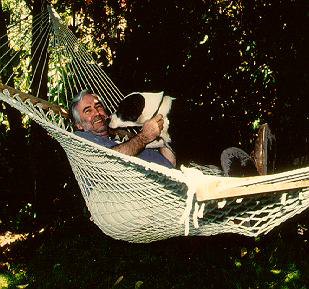
If you want your puppy to obey each family member in all settings and situations, then every member of the family must train the pup in every setting and situation. In order to teach your puppy to respond here, there, and everywhere, it needs to be trained here, there, and everywhere. The secret is to train your puppy little but often — at least fifty tiny training sessions a day — with only a couple of sessions lasting for more than a few seconds.
Integrate Training and Games
Playing games with lots of rules is a fun way to train your dog and exercise her mind. Your puppy will learn that games have rules and that rules are fun. Training becomes a game, and games become training.
Integrate Training and Lifestyle
In order to get your puppy to respond here, there, and everywhere, she needs be trained here, there, and everywhere. Train your puppy little but often. The secret is to totally integrate training into both your puppy's lifestyle and your lifestyle.
Train regularly and you'll discover that integrated training is easy and enjoyable. For example, call your puppy for a body-position sequence with variable length stays in each position whenever there are advertisements on the television, or every time you open the fridge, make a cup of tea, turn a page of the newspaper, or send an e-mail. If you instruct the pup to perform a simple body-position sequence on every such occasion, you will easily be able to train your puppy over fifty times a day without deviating from your normal lifestyle. Remember that you are responsible for a young, impressionable, developing canine brain. Exercise that doggy brain. Allow your pup to achieve and enjoy her full potential.
Integrate Training into Your Own Lifestyle
Once your dog is well-trained, she may enjoy full run of your house, will be welcome almost anywhere, and may eventually graduate to couch work. My dogs spend most of the evening snuggled on the couch. They like BBC America and Soccer (Arsenal supporters.) Occasionally, I may ask them to do something during breaks, like move over, fetch the paper, change the channel, vacuum the living room, or fix dinner. They're highly trained dogs.
Your Dog's Lifestyle
Integrate short training interludes (quick sits and releases) into your puppy's walks and off-leash play. Each quick sit is immediately reinforced by allowing the dog to resume walking or playing — the very best rewards in domestic dogdom. Integrate short training interludes into every enjoyable doggy activity — riding in the car, watching you fix their dinner, lying on the couch, and playing doggy games. For example, have your dog sit before you throw a tennis ball and before you take it back. Progressively increase the length of sit-stay with each repetition.
Similarly, insert short training preludes before all your puppy's enjoyable activities. For example, ask the pup to lie down and roll over for a tummy rub, or to lie down and stay a while before being invited for a snuggle on the couch. Have her sit before you put her on leash, before you open the door, before you tell her to jump in the car, before you allow her to get out of the car, and before you let her off-leash. And be sure to have her sit for her supper. With total integration, your puppy will see no difference between playing and training. Fun times will have structure, and training will be fun!
Life Rewards
Puppies are easy to train. It is so easy to teach them what we want them to do. In fact, a young puppy will do just about anything you ask just for the sake of doing it. As the puppy collides with adolescence, however, it begins to ask world-shattering questions, such as "Why?"
Just because your puppy has learned what "Sit" means does not necessarily mean she will sit when you request her to do so. Consequently, the most important ingredient of any educational program, whether for children, employees, husbands, or dogs, is teaching "Why comply?" You must teach the relevance of complying. Indeed, once you have taught your puppy the positive consequences of cooperating, she will eagerly want to comply!
First make a list of all the things in life your puppy enjoys. Then institute a simple and effective rule: Nothing will be denied, nor withheld from the pup, but the puppy has to sit beforehand. It's just common canine courtesy, really. Nothing more than a puppy "please."
In no time at all, your pup will learn the relevance of complying with your wishes and will be only too willing, eager, and happy to oblige. Now your dog will want to do what you want it to do.
Basically, you need to convince your pup that he or she is the trainer and you are the pupil! Your puppy needs to believe, "Sitting is the canine cue — the veritable key to the door — which makes my owners do anything I want. If I sit, they will open doors (how courteous). If I sit, they will massage my ears (how affectionate). If I sit, they will share the couch (how cooperative). If I sit, they will throw the tennis ball (how athletic). And if I sit, they will serve supper (how well-trained)."
Aside from producing a more reliable dog, integrating training into the daily routine of your dog makes your life more enjoyable, and allows your dog to have more fun and freedom. For example, something as simple as going through a door with an untrained and uncontrollable dog can be a time-consuming and daunting prospect. It can take some owners almost five minutes to put on the leash and make their exit. This means leaving the house with the dog just once a day may easily waste more than a whole fortnight over the lifetime of the dog. That's the equivalent of fourteen entire days and nights spent struggling with dogs in doorways. The result, of course, is that many owners do not bother to walk the dog at all if it's that much trouble.
On the other hand, well-trained dogs get to be taken on walks, picnics, days out, and car trips with their owners, and they are far less likely to be relegated outdoors, or isolated in a back room when visitors arrive. A well-trained dog has much more fun.
Settle Down and Shush
Right from the outset, make frequent little quiet moments part of your dog's daily routine. Remember, a puppy is not like an irritating child's toy. You cannot simply remove the batteries from a rambunctious adolescent dog. Instead you must learn how to "turn off" your dog. Learn to use walks and your puppy's favorite and most exciting games as rewards for settling down quietly and calmly.
Throughout the course of the day, have your puppy settle down for longer periods at home. For example, when watching the television, have your pup lie down on-leash, or in his bed, but during the commercial breaks, release the puppy for short, active play-training sessions.
When playing with your puppy, have him settle down and shush every 30 seconds or so. To begin with, have the pup lie still for just two seconds before letting it play again. Use a release command, such as "Free Dog," "At Ease," or "Let's Play." After 30 seconds, interrupt the play session again with a three-second quiet moment. Then try for four seconds. And then five, eight, ten, and so on. Alternate "Settle Down" with "Free Dog" and with each repetition, it becomes progressively easier to get your puppy to settle down quickly.
Once your pup gets the picture, the exercise may be profitably practiced on walks. When walking round the block, periodically have your puppy settle down for just a few seconds before resuming the walk. An entertaining way to train is to instruct your pup to settle down every twenty yards or so, while you read an article from the newspaper, or a page from a good book, such as Jean Donaldson's doggy bestseller, The Culture Clash.
With the above exercises, your puppydog will learn to settle down quickly following a single command, no matter how excited or distracted he may be. Moreover, your dog settles down willingly and happily because he knows being told to lie down is not the end of the world, and not necessarily the end of the walk. Rather, your dog has learned, "Settle Down" is just a relaxing time-out for gentle praise and affection before his exciting life as Mr. Activity Dog resumes once more.
It is difficult to have too many rules with an adolescent dog. Teach your dog to be calm and controlled when requested and there will be years of enjoyment ahead. Let your puppy pull on-leash, and it will pull on-leash as an adult. Let your puppy play indiscriminately and without frequent interruption, and it will become inattentive and uncontrollable as an adult. Integrate play and training, and integrate training and walks. In no time at all, training will be fun, and fun activities (play and walks) will be structured.
Adapted from AFTER You Get Your Puppy by Dr. Ian Dunbar
Training on the Dog Walk
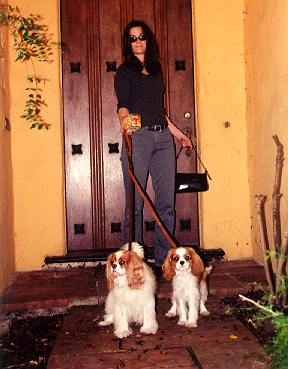
As soon as it is safe for your puppy to go out, take him on walks — lots of them. There is no better overall socialization exercise and no better overall training exercise. As an added benefit, dog walks are good for your health, heart, and soul. Walk that dog! Tie a pink bow to his collar and see how many smiles you get and how many new friends you make. Doggy socialization is good for your social life.
Housetraining on Walks
If you do not have a private yard or garden, make sure your dog urinates and defecates before you begin your walk. Thus, the walk becomes a reward for doing the right thing in the right place at the right time. Otherwise, when you terminate an enjoyable walk after your dog has done her duty, you end up punishing her for eliminating. Your dog might then start delaying elimination to prolong his walks.
Put your puppy on-leash, leave the house, and then stand still and let the pup circle and sniff. Give her four or five minutes. If she doesn't perform, go back indoors and try again later. Keep your pup in her short-term confinement area for the interim. If your puppy does go within the allotted time, praise her profusely, reward her with a dog treat, say, "Walkies," and off you go. You'll find a simple "no feces = no walk" policy quickly produces a speedy defecator.
There are additional benefits to teaching your dog to eliminate prior to a walk. Clearing up the mess and depositing it in your own trash is much more convenient than a mid-walk cleanup. Walking an empty dog empty-handed is also generally more relaxing than walking a dog and lugging around a bag of dog doo doo.
Socializing on Walks
Take a few time-outs on each walk. Do not rush your young dog through the environment. Give your dog ample opportunity to relax and watch the world go by. A stuffed Kong will help her settle down quickly and calmly each time you stop.
Never take your dog's even temperament for granted. The great outdoors can be a scary place, and there will be the occasional surprise to spook your pooch. The best approach is to prevent these problems. Handfeeding your dog her dinner on walks helps her form positive associations with people, other dogs, and traffic. Offer your dog a piece of kibble every time a car, big truck, or noisy motorcycle goes by. Offer your dog a couple of pieces of kibble every time another dog or person passes. Praise your dog and offer a treat whenever she greets another dog or person in a friendly fashion. Praise your dog and offer three tasty treats whenever a child approaches. And when a child whizzes by on a skateboard or dirt bike, handfeed her the whole bag of food.
Should someone wish to meet your dog, first show them how to use kibble to lure/reward her to come and sit. Ask the stranger to offer the kibble only after your dog sits to say hello. From the outset, teach your dog to always sit when meeting and greeting people.
Training on Walks
When your dog is five months old, puppyhood is over, and you will begin to realize that the canine weight-pulling record approximates ten thousand pounds. Dogs pull on-leash for many reasons. The view is always better for the lead dog. A tight leash provides the dog a "telegraph wire" that communicates the owner's intentions, thus affording the dog the luxury of looking around and otherwise checking out the action. Pulling while on-leash appears to be intrinsically enjoyable for dogs. And we let them do it. Each second the leash is tight, each pulling moment is hugely reinforced by each step the dog takes, forging ahead to investigate the ever-exciting, ever-changing olfactory environment. Here are a few dos and don'ts for teaching your dog to walk calmly on-leash:
DO practice leash walking around your house and yard from the very beginning, and take your puppy for walks in public as soon as he is old enough.
DON'T wait until your dog reaches adolescence before trying to teach him to walk on-leash in public, unless you wish to provide amusement for onlookers.
DO alternate short periods of 15 to 30 seconds when your dog walks by your side, with longer periods of a minute or so when your dog is allowed to range and sniff at the end of the leash. This motivates your dog to walk by your side, as walking side-by-side is regularly reinforced by permission to range and sniff.
DON'T expect your adolescent (or adult) dog to endlessly heel. He will learn that heeling is mutually exclusive to ranging and sniffing. He won't want to heel and will grow to resent training and the trainer (you) for spoiling his fun.
DO consider training your dog to pull on-leash. Thus, instead of being a problem, pulling on-leash can be the solution, an effective reward to reinforce calmly walking by your side. Alternating slack-leash walking and pulling on-leash is enthusiastically endorsed by my Malamutes. Two paws up! Also, on-command leash-pulling is wonderful for ascending steep hills, pulling sleds, soapbox cars, and skateboards.
DON'T allow your dog to decide when to pull on leash. Employ red light/green light training. When your dog tightens the leash, immediately stop, stand still, and wait. Once he slackens the leash, or better yet, once he sits, proceed with the walk.
Red Light/Green Light
The good old dog walk has to be one of the dog's biggest rewards, second only to a romp in the park. Many dogs go quite crazy at the prospect of a walk, and of course, the walk only reinforces his craziness. Moreover, dogs pull on-leash with increasing vigor with every step you take, and, of course, each step you take reinforces the dog's pulling. Luckily, there's a better way. The walk can reinforce your dog's good manners.
Before going on a walk, practice leaving the house in a mannerly fashion. Say "Walky, Walky, Walkies!" and waggle the dog's leash in front of his nose. Most dogs will go ballistic. Stand still and wait for your dog to calm down and sit. With his walk stalled before starting, your dog will suspect you want him to do something, but as yet he isn't sure what. He will likely offer many creative suggestions, maybe his entire behavior repertoire. Your dog may frantically bark, beg, jump up, lie down, roll over, paw you, and circle you. Ignore everything your dog does until he sits. It doesn't matter how long it takes; your dog will sit eventually. When he does, say, "Good dog," and snap on his leash. When you snap on his leash, your dog will likely reactivate. So stand still and wait for him to sit again. When he does, say, "Good dog," take one step toward the door, stand still, and then wait for him to sit once more. Head toward the door one step at a time and wait for your dog to sit after each step. Have your dog sit before you open the door and have him sit immediately after going through the door. Then come back inside, take off the dog's leash, sit down, and repeat the above procedure.
You'll find that the time it takes for your dog to sit progressively decreases as the exercise proceeds. You'll also notice your dog becomes calmer each time you leave the house. By the third or fourth time you leave, your dog will walk calmly and sit promptly.
Don't prompt your dog to sit. Don't give him any clues. Let your dog work it out for himself. Your dog is learning even when he presents a series of unwanted behaviors. He is learning what you don't want him to do. The longer you wait for your dog to sit, the better he learns which behaviors are unwanted. When your dog sits and receives praise and a reward, he is learning what you want him to do.
Dogs love this game. After playing the game for a very short time, your dog learns which green-light behaviors (sitting) get you to proceed and which red-light behaviors (everything else) cause you to stand still.
When your dog can leave the house in a mannerly fashion, it is time to go for a real walk. Put your dog's dinner kibble in a bag, for today he will dine on the walk. Hold a piece of kibble in your hand, stand still, and wait for your dog to sit. When he does, say, "Good dog," and offer the kibble. Then take a giant step forwards, stand still, and wait for your dog to sit again. As soon as you step forward, likely your dog will explode with energy. Stand still and wait. Eventually your dog will sit again. Say, "Good dog," offer the kibble, and take another giant step forward. As you repeat this procedure over and over, you'll notice your dog sits progressively more quickly each time you stand still. After just a few repetitions your dog will begin to sit immediately each time you stop. Now take two giant steps before your stop. Then try three steps and stop, and then five, eight, ten, twenty, and so on. By now you will have discovered that your dog walks calmly and attentively by your side and sits immediately and automatically each time you stop. You will have taught him all this in just one session, and the only words you said were "Good dog."
Sit and Settle Down
Have numerous short training interludes during the walk. Stop for a short training interlude every twenty-five yards or so. For example, each time you stop, say, "Sit," and as soon as your dog sits, say, "Let's go," and start walking again. Thus, every time you stop, resuming the walk effectively rewards your dog for sitting.
Keep most training interludes shorter than five seconds, so as to reinforce quick sits and downs or short sequences of body-position changes, such as sit-down-sit-stand-down-stand. You may periodically reward your dog with kibble if you like, but this is hardly necessary, because resuming the walk is a much better treat for your dog. Occasionally insert longer training interludes to practice having your dog walk by your side for 15 to 30 seconds at a time or to reinforce two- or three-minute settle-downs. Offer a stuffed Kong for your dog's amusement and read a newspaper for yours.
The above training techniques will mold your dog's behavior and mend his manners in a single walk. By averaging seventy or so training sessions per mile, a single walk will troubleshoot virtually any training problem. For example, you may experience some difficulty getting your excited dog to pay attention and settle down the first few times you stop, but by the fourth or fifth time, it will be easy. After an enjoyable three-mile walk (with two hundred or so training interludes), your dog will be nothing less than brilliant.
The reason why this technique is extraordinarily successful is twofold:
1. Repeated training interludes force you to face your foremost fears and conquer them. The troubleshooting nature of these repetitive training interludes allows you to solve pressing training problems quickly. For example, your problem is not that your dog does not settle down; he does, but only eventually, only occasionally, and only of his own volition. You want your dog to settle down promptly and reliably upon request. Practice over and over in the above fashion, with many short training interludes during the walk. Your dog will comply more and more quickly with each trial. Eventually, he will learn to comply immediately.
2. Most owners train their dog only in one or two locations, such as the kitchen and training class, and they end up with a good kitchen-dog and a mannerly class-dog. But the dog still doesn't pay attention on walks and in parks. Presumably, the dog thinks that "Sit" only means sit in the kitchen and in class, because they are the only two places where he has been trained. With seventy or so training interludes per mile, however, every single practice session is in a different setting with different distractions — on quiet streets and busy sidewalks, leafy trails and open fields, near schools, and in park playgrounds. Thus, your dog learns to heed your instructions and quickly and happily comply no matter where he is, what he is doing, and what is going on. Your dog generalizes the "Sit" command to mean sit everywhere and at any time.
If you train your dog on every walk, you will soon have a puppy that will sit quickly and settle down promptly with a single request, no matter how excited or distracted he may be. Moreover, your dog settles down willingly and happily because he knows that being told to lie down is not the end of the world and not even the end of the walk. Your dog will have learned that "Settle Down," for example, is just a relaxing time-out with gentle praise before his exciting life as Walking Dog resumes.
With your now-mannerly dog, you'll find that it is quicker navigating country roads and suburban sidewalks than with your previously hyperactive hound. Now you can follow your intended itinerary without being pulled every which way but loose.
Adapted from AFTER You Get Your Puppy by Dr. Ian Dunbar
Training in the Car
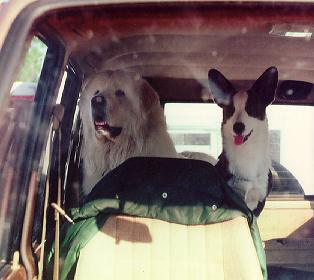
Don't forget to practice in the car. It's the same technique as on the walk. For a couple of days, read the newspaper in the car, having instructed your dog to settle down with a stuffed Kong. Have a short training interlude every minute or so to practice some body-position changes —sit, down, stand, etc. —or place changes — back seat, front seat, seat belt, crate, etc. It is much easier to do this when you are not driving and the car is stationary. Once your dog promptly responds to each request, repeat the exercises with a friend driving. You'll soon find your dog happily responds to your requests when you are driving. Once you have a dog that will settle down anytime, anywhere — in the car and on walks — it's time to get him out and about. Be sure to take a bag of kibble with you. Take your dog everywhere — on errands around town, to the bank, pet store, Granny's, to visit friends, to explore the neighborhood, or maybe just for the ride. It's time for picnics in the park, walks, and more walks. And again, always have kibble on hand to give to your dog whenever dogs or people approach. Also, give kibble to strangers to train your dog how to greet them, that is, to sit for a food reward.
Training in the Dog Park
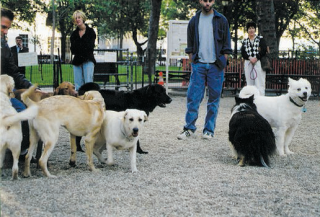
Letting your dog play uninterrupted in the park can be one of the quickest ways to lose control over your adolescent dog. Allow him to play uninterrupted and you'll quickly lose his attention and have no control over him whatsoever. On the other hand, if you integrate training and play, you'll soon develop reliable, off-leash distance control over your dog.
How to Train Your Dog Not to Come When Called
Many owners let their dogs off-leash without so much as a "please" or a "Sit." Often the dogs are excitedly bouncing and barking in anticipation of playing. Thus being let off-leash reinforces their boisterous behavior. They delight in their new-found freedom, running around, sniffing, chasing each other, and playing together like crazy. The owners look on and chat. Eventually, it's time to go. One owner calls her dog, the dog comes running, the owner snaps on the leash, and the play session is over.
This sequence of events is likely to happen just once or twice, because on subsequent trips to the park the dog understandably will not be quite so keen to come to his owner when called. It doesn't take much for the dog to make the association between coming when called and having an otherwise utterly enjoyable romp in the park abruptly terminated. On future trips to the park, the dog approaches his owner slowly with head down. The owner is now doing a fine job demotivating the dog's recall and is inadvertently training the dog not to come when called.
Indeed, slow recalls quickly become no recalls, as the dog tries to prolong his fun by playing Catch-Me-If-You-Can. The irritated owner now screams for the dog to come, "Bad dog! Come here!" And, of course, the dog muses, "I don't think so! In the past I have learned that that nasty tone and volume mean you're not too happy. I think it would be a mite foolish for me to approach you right now. You're not in the best frame of mind to praise and reward me appropriately." But you are not going to do this with your dog, are you?
How to Train Your Dog to Come When Called
Instead, you are going to take your dog's dinner kibble to the park, call your dog every minute or so throughout his play session, have him sit for a couple of pieces of kibble, and then let him go play again. Your dog will soon learn that coming when called is an enjoyable time-out, a little refreshment, a kind word, and a hug from you, before he resumes play. Your dog becomes confident that coming when called does not signal the end of the play session. Your dog's enthusiastic recalls will be the talk of the town! When it is time to end the off-leash play session, I like to soften the blow by telling my dogs, "Let's go and find your Kongs!" Before going to the park, I always leave stuffed Kongs in the car and back home as a special treat.
In addition, you might consider teaching your dog an emergency sit or down, which is often better than an emergency recall. Teaching a reliable sit or down is much easier than maintaining a reliable recall. With a quick sit you instantly control your dog's behavior and limit his movement. Once your dog is sitting, you have several options:
1. You may let the dog resume playing. (Either you were just practicing the emergency sit, or the danger has passed.)
2. You may call your dog to you. (The surroundings are changing and it would be safer if your dog were closer; other dogs, people, or especially children are approaching.) Your dog is more likely to come when called if he is already sitting and looking at you, that is, if he is already demonstrating willing compliance.
3. You may instruct your dog to lie down and stay. (The setting is likely to be unstable for a while and it would be safer if your dog were not running around or running toward you. For example, a group of schoolchildren may be passing between you and your distant dog. To call your dog now would scatter the children like bowling pins.)
4. Walk up to your dog and put him on leash. For added stability, it is good practice to hold your dog's attention with your hand in a policeman stop signal and continually praise your dog for staying as you approach. (Do this when danger is imminent and a recall or distant stay would be unwise. For example, a herd of one hundred goats is being driven towards your dog. This once happened to my Malamute in Tilden Park in Berkeley.)
Adapted from AFTER You Get Your Puppy by Dr. Ian Dunbar
Ch 3: Basic Manners & Obedience
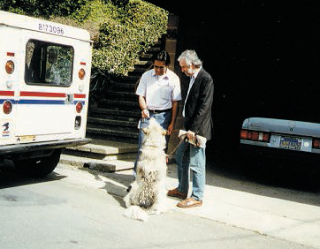
Even if you only manage to teach your puppy/dog to sit on cue, you will have solved countless behavior problems. Sitting promptly and reliably whenever asked prevents your dog from performing a limitless list of inappropriate and unacceptable behaviors, because sitting and most problem behaviors are mutually exclusive, i.e., your dog cannot sit and misbehave at the same time. So, at least teach your dog to sit when requested.
However, since off-leash, lure/reward training techniques are so amazingly simple and effective, you’ll no doubt want to expand your dog’s vocabulary and teach your dog to come when called, lie down, stand, stay, and to follow and heel as well.
Using food and toy lures and rewards is by far the easiest, quickest and most enjoyable means to train your dog — dog-friendly dog training techniques that all family members, especially children can master. Indeed, by using lure/reward techniques, dog training is truly child’s play.
Ironically though, and unbelievably, some people come up with an astounding list of pretty silly excuses for not using food lures and rewards and having fun in training. Despite the unbelievable ease and proven speed and effectiveness of lure/reward techniques, these misguided souls opt for much more difficult and time-consuming physical means of correction and punishment, that so often make training adversarial, punitive and downright unpleasant. Why on earth would we want to treat our best friend like our worst enemy? Consequently, I have included a list of excuses with explanations of why we would want pet dog training to be quick and easy and most certainly, enjoyable for both dogs and their owners.
Basic Manners
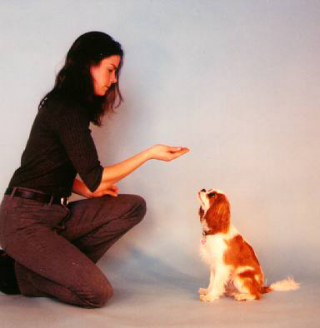
Give every guest a bag of training treats so that your puppy will be inclined to like them from the outset. Show your guests how you use your puppy's dinner kibble to lure/reward train him to come, sit, lie down, and roll over. Ask your puppy to come. Praise him profusely as he approaches and give him a piece of kibble when he arrives. Back up and do it again. Repeat the sequence several times.
Each time the puppy approaches, have him sit. Say, "Puppy, Sit," and slowly move a piece of kibble upwards, from in front of his nose to between his eyes. As the puppy raises his nose to sniff the kibble, he will lower his rear end and sit. If the puppy jumps up, you are holding the food lure too high.
Repeat the procedure with the food closer to the pup's muzzle. When your puppy sits, say, "Good dog," and give him the kibble.
Now have the puppy come, sit, and lie down. Once the pup sits, say, "Puppy, Down," and lower a piece of kibble from just in front of his nose to between his forepaws. As the puppy lowers his head to follow the food, he will usually lie down. Don't worry if your puppy stands instead; just keep the kibble hidden under the palm of your hand until he lies down. As soon as he does so, say, "Good dog," and give him the food.
Now teach your guests how to train your pup to roll over. Once the pup is lying down, say, "Puppy, Roll over," and move the kibble from in front of his nose to his shoulder blade and slowly over his backbone. Once the puppy rolls over onto his back, say, "Good dog," and give him the kibble.
Repeat the come here, sit, down, and roll over sequence until the puppy responds reliably, and then help each guest practice these maneuvers until each one can get the puppy to come, sit, lie down, and roll over three times in succession for a single piece of kibble.
Basic Lure/Reward Training
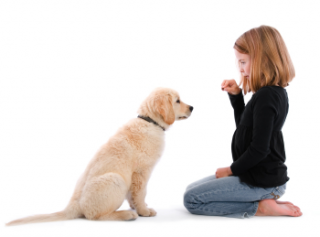
All you need to train your puppy is the inclination, a few sparks in your brain, a couple of pieces of kibble in your hand, and...the puppy. So, enough said — let's get going. Ask your pup whether it is ready to proceed by moving a food lure up and down in front of his nose. If your puppy nods in agreement, you're off and running.
If your pup does not follow the kibble with his nose, use something more enticing for the meantime, such as a favorite chewtoy, or tug toy. But then make sure you teach your puppy to work for kibble. You may not need food lures and rewards to train your puppy, but family, friends and visitors and especially, children and men will need the help of food lures and food rewards. (In fact, I suggest you give children freeze-dried liver to use when training the puppy.) Weigh out your puppy’s daily ration of kibble each morning and place it in a jar to use for training throughout the day. Do not waste valuable training lures and rewards by feeding your dog from a bowl. Handfeed your dog. Once your dog is well behaved and mannerly and perfect for you, you may feed your dog when and however you like. For the meantime though, use each piece of kibble as a food lure and handfeed it as a food reward.
Strive for a really brilliant performance, not just a lackluster attempt. Use a variety of rewards (like a slot machine), and let the value of each reward reflect the quality of your pup's responses. Praise your puppy only for above average responses. Give praise and a piece of kibble for good responses, give praise and freeze-dried liver for better responses, and save the very best rewards (jackpots) — maybe a game of tug, or a snuggle on the couch — for the very best responses. By rewarding your pup differently according to the standard of its responses, you'll find your pup's performance will continue to improve from day to day.
Sit, Stand & Down
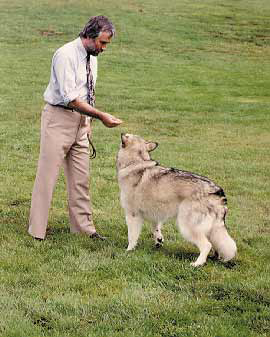
Sit
1. Say "Joe Pup, Sit." 2. Keeping the lure close to your puppy's nose, slowly move it upwards and backwards over the pup's muzzle towards his eyes. As your pup lifts his nose to follow the treat, he will sit down. (Do not lift your hand too high or your puppy will jump up.) 3. As soon as your puppy sits, say "Good little doggie!" and offer a piece of kibble as a reward.
But what did Joe Pup actually learn? Have you taught your puppy to sit? Well, not really. Your puppy knew how to sit when he was only three or four weeks old. More specifically, you have taught your puppy to sit on request. We are not so much concerned if and when your puppy decides to sit of his own accord, but rather, that he sits when requested to do so. Also, you have taught your pup to sit on request only when he was already standing. For your puppy to respond reliably, he must additionally be taught to sit when he is lying down, and to sit from any other body position and activity. Thus, when teaching just three basic body positions — sit, down and stand — the first step is to teach six separate changes of body position: to sit when standing and lying down; to lie down when sitting or standing; and to stand up when sitting or lying down.
Sit from Down 1. Say "Joe Pup, Sit." 2. Hold the lure (palm upwards) in front your pup's nose and then quickly raise the lure upwards and backwards over the pup's head. You may need to waggle the lure or clap your hands over your pup's head to energize him to sit up. If your pup has rolled over to recline on his back, take one step backwards, bend down, and pat the ground in front of his nose. When your puppy rolls back into the Sphinx position in preparation to get up, step in quickly and lure him to sit. 3 When your pup resumes sitting, praise enthusiastically and maybe offer a food reward if he sat up quickly.
Down from Sit 1. Say "Joe Pup, Down." 2. Waggle the lure in front your pup's nose. Quickly lower it to the ground between the pup's forepaws and hold it there palm downwards. Wait for your pup to lie down. Be patient. Inching the lure away from the pup's forepaws may facilitate the process as your pup reaches forward with his nose. Alternatively, slowly move the lure towards your pup's chest to cause the pup's rear end to plop down. 3. When your puppy lies down, say "Good little doggie" and maybe offer a food reward if he lies down promptly.
Down from Stand 1. Say "Joe Pup, Down." 2. Quickly lower the lure all the way to the ground and hold it palm down between the pup's forepaws. This position change is the hardest and so hold your hand steady until the puppy lies down. Once the pup's elbows and sternum touch the ground and the pup assumes a playbow posture, move the lure towards the puppy's chest and this will prompt the rear end to plop down. 3. Praise and reward accordingly (bear in mind this exercise is the most difficult). "Goooood Puppy. Good down!"
Alternative Down 1. It can be a bit tricky teaching Down from the Stand. A simple ploy is to lure your dog under a coffee table, or even under your leg. Say "Joe Pup, Down." 2. Waggle the lure to pique your pup's interest 3. As your pup sniffs the lure, slowly move it away from his nose... 4. ... and your pup will lie down to crawl under your leg!
Stand from Sit 1. Say "Joe Pup, Stand." 2. Slowly move the lure parallel to the ground, forward and away from your pup's nose. As the puppy stands, lower the lure a little to get the pup to look down. (If the pup looks up, he will promptly sit again after standing.) Do not lower the lure too far, though; the pup might lie down. 3. Calmly praise and maybe reward the pup to reinforce solid stands. Gently and rhythmically pushing down on the pup's withers helps solidify the stand stay. The firmer you push, the more solid the stay.
Stand from Down 1. Say "Joe Pup, Stand." 2. Move the lure upwards and forwards in front of your pup's nose. Again, if the pup is out for the count, stepping back and tapping the treat on the ground usually re-energizes the pup. 3. Praise and reward the pup on those occasions he stands up promptly.
Quantum Leaps
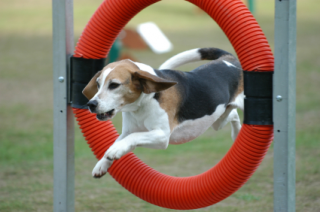
Quantum Leaps You will make four quantum leaps in training as you phase out hand-held training lures, and eventually all training rewards. Phasing out food lures is a simple matter — just put them in your pocket to be used as rewards for above-average responses. Phasing out food rewards is similarly simple — just empty your pockets of food and use something else as a reward.
1. Phasing Out Food Lures As your pup learns to watch the movement of your hand-held lure, your hand movements soon become effective hand signals. Hold your hand palm-upwards for the Sit signal, and palm-downwards for the Down signal. After a few repetitions, your puppy will begin to anticipate each hand lure signal on hearing the relevant verbal command. Thereafter, the verbal request becomes the equivalent of a verbal lure, since it successfully prompts the desired response. Training lures are no longer necessary to entice your puppy into each position because a hand signal or verbal request is sufficient. Put the kibble in your pocket right now. Come on, all of it! Repeat the Sit-Down-Sit-Stand-Down-Stand sequence with empty hands. However, make sure to follow each eager verbal request with a sweeping — nay flourishing — hand signal, just as if you were holding a lure. At the end of the sequence, praise your pup and reward him with a piece of kibble from your pocket. See, you don't need a food lure in your hand to get your dog to respond. Failure was all in your mind, just as the food is now all in your pocket.
This is the first quantum leap: Your puppy has learned that although you have no food in your hand, you can still magically materialize all sorts of goodies from your pocket. Now it's time to begin fading out food rewards.
2. Reducing Food Rewards Go back and use food as a lure for a quick test to see how many puppy-pushups (alternating sits and downs) your pup will do before he gives up. Keep hold of that treat though. The longer your hold on to the lure, the quicker training will proceed. (In fact, that's how we teach stays and "Off!") Now you know how much your puppy is willing to work for the prospect of just one food reward. See which family members and friends can get the puppy to perform the most push-ups for a single food reward. By asking more for less, you have begun to gradually and progressively phase out food rewards in training.
Now repeat the Sit-Down-Sit-Stand-Down-Stand sequence with empty hands but with food rewards in your pocket. Do not be in a hurry to stuff food rewards into your pup's mouth. Instead, treat every food reward as if it were a gold medal. Only reward your pup immediately following extremely rapid, or especially stylish responses.
This is a second quantum leap: Your puppy has learned that although you have food rewards in your pocket, he may not get one every time he responds correctly.
3. Phasing Out Food Rewards Now it is time to empty your pockets and replace food rewards with praise, petting, toys, games, favorite activities, and other luxurious life rewards. This is the third quantum leap: Your puppy has learned that although you have no food rewards in your pocket, even better surprises may follow desired behavior. For example, when walking your puppy, stop and ask him to sit every 25 yards and as a reward say, “Let’s Go” (the walk continues). When in the dog park, call your puppy and ask him to sit every minute or so and as a reward say, “Go Play” (the play session resumes).
4. Phasing Out External Rewards Eventually, it is no longer necessary to reward your dog to reinforce desirable behaviors. Rewarding your dog is always an option and always a wonderful thing to do, but your dog's stellar behavior is no longer dependent on expected rewards. Instead, your dog complies with your requests because he now wants to.
After this fourth quantum leap, external rewards are no longer necessary, since your puppy's good behaviors have become self-reinforcing. In a sense, each correct response becomes its own reward. Really, this is no different from people who enjoy reading, running, riding, playing games and sports, and dancing. Rewards are not necessary. Participation is its own reward.
Stay, Come & Follow
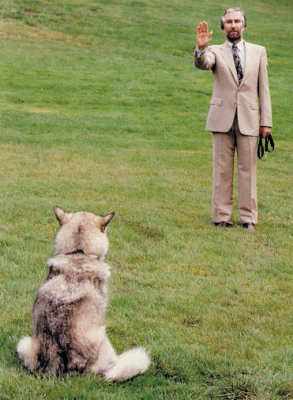
Stay Once your puppy changes body positions quickly and eagerly on request, delay rewarding your pup for a couple of seconds after each position change. Quietly praise your pup while he remains (stays) in the appropriate position. In fact, count out the seconds, "Good sit-stay one... good sit-stay two... good sit-stay three... etc."
Start with easily attainable goals, so your puppy can succeed. For example, three seconds for a Mastiff puppy, and just one second for a wriggly Labrador. And for toy breeds and terriers, the deal is easier yet — if you stay still for just a fraction of a second, frozen in time for a palpable moment — then you'll get a food reward. Next time try for a quarter of a second, then half a second, then a full second, then two seconds, three, five, eight, ten, fifteen seconds, and in no time at all, your puppy's stays will be measured in minutes. By gradually increasing the delay before rewarding your puppy on each successive trial, you are progressively increasing the length of the stay and phasing out the need for rewards.
Have competitions within the family to see who can withhold the food reward for the longest time while the puppy stays in each position. Vary the order of three body positions and make up your own sequences. For example, starting with a sitting puppy, instruct it in the sequence Down-Stand-Down-Sit-Stand-Sit. It is important to vary the lengths of stay in each in each position.
Come 1. With somebody holding your puppy, or while your puppy is playing, say "Joe Pup, Come." 2. Open your arms invitingly, waggle the food or toy lure in front of you, and praise your pup enthusiastically all the time he approaches. Remember, your puppy's first step towards you is the most important step to praise. Reward the puppy's first and subsequent steps towards you. 3. Once your puppy is within three to five dog-lengths, instruct your pup to “sit” and give the hand signal to sit with the right hand (palm upwards with food or toy lure enclosed). 4. Tell Joe Pup that you are overjoyed that he has successfully accomplished yet another wonderful and glorious recall. Maybe offer a food treat, or reward the pup with a game with his toy after especially zippy recalls, and then tell Joe Pup to "Go Play."
Whenever your puppy is off-leash, investigating or playing in the yard or park, instruct him to come to you every couple of minutes or so. However, give your puppy a food reward only for one out of every two recalls. Obviously, reward your pup after the faster recalls. If you reward your puppy after every recall, he may not learn that you want him to come quickly. In this exercise we are using food as a lure to entice the pup to come, and as an occasional reward to reinforce the puppy for coming quickly. However, the real rewards are your praise and the words "Go Play." Say nothing after slower recalls. Simply repeat the process. After a few trials your puppy will come so fast that small breeds will be hard to catch, and large breeds will flatten you. Consequently, it is a smart preemptive plan to instruct your pup to sit when he is homing-in and only three to five puppy-lengths away from potential impact.
Follow Let your puppy off-leash only in safe areas, (e.g., indoors, in a fenced yard, or in a dog park). Walk away from your puppy and he will follow you. There are two simple rules to entice your puppy to follow: 1. Keep moving... 2. Away from your puppy.
This may sound simplistic, but try it. I guarantee, in the space of a few seconds, the average three-month-old pup can train an off-leash owner to slow down, walk backwards, pirouette, stand-stay, recall, and follow. Remember, the puppy cannot follow you unless you are going somewhere. And, unless you are moving away from the puppy, you'll most certainly end up following him. That is not the aim of the game. The pup is meant to learn to follow you. And so, move off quickly, and keep moving away from your puppy at all times.
If your puppy tries to improvise when following, and starts to lag or heads off in an alternative direction, alert your pup to his transgression — "Oi! Come along," and dramatically accentuate your puppy's mistake by quickly zooming off in the opposite direction. Your puppy will smartly self-correct as if on a bungee cord. If your puppy slows down, speed up. If your puppy rushes on ahead, slow down, or turn about and run back from where you came. If your pup drifts left, turn right, and if the pup wanders right, turn left and speed up. Praise your pup the instant he starts to catch up.
Your puppy will quickly learn that he cannot divert his attention from you for a single second without you heading off in some new direction. Consequently, your pup will begin to pay attention and follow. For puppies that are too young to be walked on the streets because they have not yet completed their course of immunizations, the following exercises are easily practiced in the house and garden. Get your puppy to follow you inside and outside, upstairs and downstairs, into different rooms, and around tables and chairs. As Pat Parelli might say, preparatory private practice prevents predictable poor performance and problematic pulling predicaments in public places.
Regular, long, off-leash puppy walks (in safe areas) are the secret to calm and controlled on-leash walking. Your puppy needs to develop a centripetal attraction towards you. Your off-leash pup must always feel a gravity-pull towards the most important body in his universe — you. It is essential to develop off-leash owner-gravity before trying to walk your puppy on-leash. If your puppy doesn't walk close to you when off-leash, he will surely pull when on-leash. Pulling is basically an advertisement that your dog does not want to walk by your side, and presumably would not walk by your side if he were not restrained by a leash. Either your puppy considers that investigating the environment is much more interesting than you, or your puppy simply does not enjoy walking by your side because you keep jerking the leash to try to dissuade him from pulling. (By moving ahead and tightening the leash, the puppy reduces the pain of each jerk.)
Owner-gravity (following) exercises are time-sensitive. It is not safe to walk your puppy on public property until he is at least three months old, and by the time the puppy is 18 weeks old, following exercises start to lose effectiveness. Untrained adolescents soon develop doggy interests and would much rather sniff urine and feces, sniff other dog's rear ends, or simply sniff, than walk by their owner's side. It is much easier to teach off-leash following and closeness before your puppy reaches adolescence.
Take long walks and keep moving away from your puppy. Accentuate your pup's unwanted wanderings by smartly moving off in the opposite direction. Should your puppy get too far ahead, hide. Periodically, shout your pup's name. Remain hiding but keep an eye on your pup. Wait for the puppy to find you and then lavish him with praise. It is unlikely that you will be able to hide from your pup more than a couple of times. Perhaps your puppy thinks that he cannot take his eyes of you for a second without you getting lost. During each walk, remember to frequently instruct your pup to sit or settle down by your side. You can lure and reward your off-leash puppy to settle down beside you simply by holding a piece of rope with a stuffed chewtoy tied to the end.
Heel
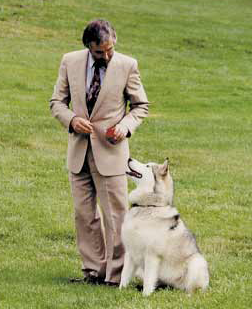
Heel 1. Practice off-leash heeling in a safe area (indoors, or in a fenced yard). Use a lure in your left hand to position the puppy on your left side when in motion, and transfer it to your right hand to signal the puppy to sit when you stop. (Or hold lures in both hands.) With your pup sitting on your left side, say "Joe Pup, Heel" and give a hand signal by moving the lure in your left hand from left to right in front of your dog's nose. 2. Walk briskly forward in a straight line, waggling the lure in your left hand and praising your pup as you go. 3. Transfer the lure from left to right hand in preparation for the sit signal. 4. Say "Joe Pup, Sit," and while in motion, give a sit signal in front of your pup's face with your right hand. 5. Then come to a halt and praise your puppy as soon as he sits: "Good Heel-Sit Joe Pup. Good Heel-Sit." 6. Well, since that was so good, how about a friendly pat of encouragement before proceeding on the next Sit-Heel-Sit sequence.
Teaching your puppy to heel with precision is the most complicated of all training exercises. To make the process as easy as possible, break down heeling into a series of simpler exercises. 1. Teach your puppy to sit quickly and reliably. 2. Teach your puppy to come and sit in heel position. 3. Teach left-, right-, and about-turns in place. 4. Teach straight-line, sit-heel-sit sequences. 5. Combine all the exercises and make turns while in motion.
Before heeling anywhere, make sure that your puppy sits reliably. If your puppy does not sit promptly when requested, you will become frustrated and quickly ruin your pup's desire to heel by repeatedly nagging at your puppy to sit after he heels well.
Teach your puppy precise heel position while stationary. Say, "Puppy, Heel," and use a lure in your right hand to lure your puppy to sit by your left side. Take one step in any direction (forwards, backwards, right, or left), or pivot in place (90˚, 180˚, 270˚, clockwise, or counter-clockwise), and then stand still, say, "Puppy, Heel," and lure your pup to come and sit in heel position again. Repeat this process over and over in a number of different distracting settings — in the house, the yard, and the dog park.
Practice heeling turns in place. Instruct your puppy to sit and then pivot on the spot, using your left-hand food lure to guide your dog around, and your right-hand lure to get your puppy to sit again, facing in the new direction — sit-turn-sit. Practice turning both clockwise and counter-clockwise. Each heeling sequence begins and ends with the dog sitting by your left side. To keep your pup in heel position when in motion requires continual attention and repeated enthusiastic feed-back. Consequently, think of heeling as short sit-heel-sit sequences. Each sit allows you to catch your breath and regain composure.
Make sure you always start each sequence with the pup in the correct position, i.e., sitting by your left side. Use the lure in your right hand to position the pup by your left side. Say "Joe Pup, Sit," and give a hand signal by moving your right hand across your body — upwards and backwards in front of the dog's nose. Transfer the lure to your left hand in preparation for heeling. 1. Establish your composure with your pup sitting in heel position. 2. Heel rapidly in a straight line for a very short distance. 3. Have your pup sit again to re-establish your composure.
For turbo-pups, maybe start with single-step sequences. Your pup will pay much more attention after a series of short, staccato sit-step-sit sequences. Now try for two steps between sits. Then try three, five, eight, and ten steps at a time. Repeat the short heeling sequences, gradually increasing the number of steps between sits. Soon you will be doing long straightaway heels.
Initially, walk as quickly as possible so that your puppy has to walk a straight line in order to keep up. If you amble along, your puppy will have ample opportunity to serpentine from side to side. Initially, heel only in a straight line. Keep your puppy's attention by frequently changing pace. Say "Quickly" before speeding up, and say "Steady" before slowing down. Your pup will quickly learn the meaning of these two very useful instructions. Remember to make it fun. Praise your puppy frequently, and occasionally dispense a food reward after an exceptionally good bit of heeling, or after a stylish, or lickety-split sit.
When you are ready to turn, instruct your puppy to sit, and then turn in place — sit-turn-sit. Then heel away in a straight line in the new direction. After no time, you will be able to begin negotiating turns while moving.
Moving Right Turns 1. To avoid your dog taking a shortcut behind you on right turns, say "Quickly!" 2. Move your left hand forwards to speed up your pup so that his head is in front of your left knee before you turn right. Speed up to encourage your puppy to complete the turn quickly. 3. After the right or right-about turn praise the puppy when he comes back into heel position.
Moving Left Turns 1. To avoid bumping your puppy when making left turns, say "Steady!" 2. Slow down and move your left hand behind your left knee to slow down the pup. 3. After the left or left-about turn, praise the puppy when he comes back into heel position.
Ultra Super Sit
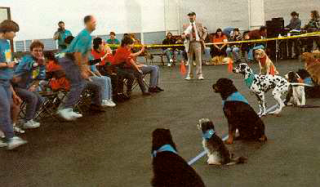
Four Steps to an Emergency Distance Sit With a little practice you can develop and absolutely rock-solid, long-distance, sit-stay that can save you from most dangerous or embarrassing situations your dog could get into. The secret to off-leash control is to thoroughly integrate fun training into all of your dog's off-leash activities. Total integration of training and play should be your aim from the very start. Interrupt your dog's off-leash activities every minute or so. Every time you interrupt an enjoyable activity by instructing your dog to sit, for example, and then allow him to resume the activity, you are reinforcing the dog's prompt sit with a powerful reward. The more you interrupt your dog's play, the more you may reward him for sitting promptly.
First practice the following exercises in safe, enclosed areas. This can be when your puppy is off-leash in your house or yard, when he is playing in puppy classes, during puppy parties, or when off-leash in dog parks.
1. Every minute or so, run up to your puppy and take him by the collar. Praise the pup, offer a tasty food treat, and then tell him to go play again. At first try this in a fairly small area, such as your kitchen with no other distractions. Then try it with just one other puppy present. If you have difficulty catching your pup, have the other owner grab hers at the same time. Then try with a couple of other puppies present. Gradually increase the number of puppies and size of the area until your puppy is easy to catch when playing, for example, in your fenced yard. Use freeze-dried liver treats during this first exercise so your pup quickly comes to love having his collar grabbed.
2. Once your puppy is easy to catch, dry kibble will suffice. Now, instruct your puppy to sit each time after you take him by the collar. Use the food to lure the puppy into a sitting position, praise the pup as soon as he sits, offer the piece of kibble as reward, and then tell him to go play.
3. By now your puppy should feel completely at ease with your running up to reach for his collar. In fact, he probably looks forward to it, knowing he will receive a food reward before resuming play. You may find your puppy sits in anticipation of the food reward. This is good, because the next step is to instruct your puppy to sit before you reach for his collar. Run up to your puppy and waggle a piece of kibble under his nose, and once the puppy homes in on the food, use it as a lure to entice him to sit. Praise your puppy as soon as he sits, offer the kibble as a reward, and tell the puppy to go play. It is vital that you do not touch the puppy before he sits. Some owners are impatient and physically sit the dog down. If you have to rely on physical contact to get your dog to sit, you'll never have reliable off-leash distance control. If you are experiencing difficulties, go back to using freeze-dried liver.
4. Now that your puppy sits promptly as you approach, you can teach him to sit from a distance. Again try this exercise around the house without distractions before trying it with other puppies present. Sit in a chair and without moving a muscle, calmly and quietly say, "Puppy, Sit." Wait a second, then rush toward the puppy saying, "Sit! Sit! Sit!" in an urgent tone but without shouting. Praise your puppy the moment he sits, take him by the collar and let him sniff the kibble. Then quickly take one step backwards, and instruct your puppy to “Come” and “Sit.” If your puppy sits promptly, offer the piece of kibble as reward and then let him resume playing. As you repeat this over and over again, you'll discover that fewer and fewer repetitions of the instruction to sit are necessary before your puppy complies. Also, with repeated trials your puppy sits sooner and sooner and with you farther and farther away. Eventually your dog will sit promptly at a distance following a single softly spoken request.
From now on, whenever your dog is off-leash, repeatedly and frequently interrupt his activity with numerous short training interludes. Ninety percent of the training interludes should be as short as one second. Tell your dog to sit and then immediately say, "Go play." Your dog's quick sit is proof that you have control, so you needn't push it. You needn't prolong the sit stay. Instead, quickly tell your dog to go play so as to reinforce the quick sit. In one out of ten training interludes practice something a little different. Once your dog sits, instruct him to sit-stay or to down-stay. Or walk up to your dog and take him by the collar before telling him to resume playing.
Food Critics
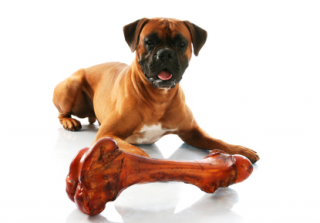
Nearly every trained animal you see in films and on television has been taught using food lures and rewards. Killer whales are trained using fish. Grizzly bears are trained using marshmallows and soda pop. Obviously, trainers dealing with such large, potentially dangerous animals do not want killer whales and grizzly bears forming negative associations with training, or with the trainer! Let's not discriminate against the canine species. Isn't it long overdue for our best friends to have equal opportunity with the rest of the trained-animal kingdom?
Any criticism of using food as a training tool may actually be applied to the use of any training tool, including leash-corrections and praise.
Excessive praise, or correction, may over-excite your dog. Your dog may not respond when off-leash, or when you do not have praise in your heart. Your dog is hardly going to respect someone who regularly needs to resort to physical force and painful punishments. And, what if your dog doesn't like food, you might say? Well, what if your dog doesn't like leash corrections? Surely, such woolly logic should not stop owners from using food lures and rewards to great effect to teach their dogs to enjoy training. And, if the dog doesn’t like food, then let’s teach him to like food. The process is really not so different from teaching dogs to love children and strangers.
The use of any training tool has its advantages and disadvantages. Do not forgo the magical advantage of using food lures and rewards just because of one or two supposed disadvantages. Learn to use food in training correctly and overcome the minor disadvantages so that you may take full advantage of many beneficial effects of food lures and rewards.
Food is the very best lure for most dogs and for most owners. However, once you have become adept at food luring and reward training, you will be able to use chewtoys, squeaky toys, and snapping fingers to lure or reward your dog. Pieces of kibble and the occasional freeze-dried liver treat are the most convenient and easy-to-use rewards for initial training but you need to change to more meaningful "life rewards" as soon as possible. Of course, if you have a warm heart, an expressive voice, and affectionate hands, praise and petting will be more than a sufficient thank-you for your puppy.
"Use food in training? That's sissy training"
Maybe so, but it works! And I'll tell you what, if carrying a wand and wearing a pink tutu would help train dogs and save their lives, I'd do that, too. In addition to their obvious applications in all aspects of teaching manners, food lures and food rewards may be more importantly used for behavior modification and temperament training. In fact, food lures and rewards are so effective, their use should be mandatory.
In addition to being incredibly effective, there is an entire century of scientific research on the topic of behavioral modification and the consequential evolution of modern-day, psychological training techniques. Perhaps some trainers are simply resistant, or scared, to adopt anything new, progressive, or more sophisticated.
It would be a shame if your puppy's education were to suffer simply because you had misgivings about using food lures and rewards. Consequently, here follow answers to other common concerns about using food in training.
"My dog will get fat!"
If you feed your dog too much, she will get fat. However, training treats should not be extra calories, and they should not be junk food. Food lures and rewards are part of your dog's normal daily diet (primarily consisting of dry kibble) but used periodically during training rather than given all at once at dinner time.
Each morning, measure out your dog's daily ration of kibble and put it in a handy container. (If your dog puts on weight, measure out less kibble each day and exercise your dog more. If your dog loses weight, measure out more kibble each day.) Throughout each day, use some kibble as lures and rewards for training, and stuff the remainder in hollow chewtoys.
A small number of treats (e.g., dog biscuits, or freeze-dried liver) may be included as part of your dog's daily dietary allotment of calories and these are best reserved for specialized training exercises, such as housetraining, park recalls, and socialization and training with children, men, and strangers.
"My dog will be forever on the scrounge, begging for food, and worrying at food in my hand!"
Not necessarily correct! You may use food distractions and rewards to teach the dog not to scrounge or worry at food in your hand. In fact, the only way to teach dogs not to scrounge or worry at food in your hand is by using food in training. In addition, you may teach your dog to take food (from your hand or dog bowl) only after being given a specific instruction, such as "Rover, Take It" or "Chow." The dog must learn the difference between children's hot dogs and doggy treats.
"Food makes my dog over-excited."
If food over-excites your dog, you need to use food as a reward to teach your dog to be calm. The DoggiCalm training technique is quick and easy. Let your dog sniff a piece of kibble in your hand, ignore the dog's boisterous bouncing and barking, wait for your dog to sit and then offer the kibble. Repeat the procedure a number of times. Delay giving the food reward for a couple of seconds after your dog sits and your dog will remain calm for a couple of seconds. With each successive repetition, progressively increase the delay and hence the period of calmness. After hand feeding just a dozen pieces of kibble, you'll have a dog that calms down quickly and sits automatically whenever you have food in your hand.
"It's demeaning to use food treats."
I have it from the highest authority that dogs strongly disagree with the above statement. On the contrary, dogs consider not receiving food rewards for their efforts to be demeaning.
I get paid when I write doggy books and give veterinary seminars. Most of you get paid when you work. And strange though it may seem, puppies and dogs would like to be on the payroll as well.
"My dog responds only when I have food."
Most probably because you have yet to fully grasp the principles of lure/reward training. Read on. Learn how to replace food lures with verbal commands and hand signals within your first training session, and learn how to phase out and replace food rewards with more meaningful incentives, such as life rewards and internal motivation.
"I don't want to bribe my dog."
Neither do I. Bribing is largely ineffective. Using food as lures, rewards, distractions, and general motivators is far more precise and effective than using food as bribes. Parents and politicians quickly learn that bribery does not work. However, luring, rewarding, and motivating do work. Extremely well, in fact. Lures teach dogs what we want them to do; rewards teach dogs to want to do what we want them to do; and motivators teach dogs to be eager and attentive on cue.
"I want my dog to respect me."
The above statement camouflages some pretty scary logic — that a dog would respect you more if you trained using correction and punishment, rather than lures and rewards. Duh!?! Beware of those, who insist that harassment, bullying, and physical domination are necessary to get dogs to show respect. Dogs' brains boggle at this perverse notion. On the contrary, you will gradually earn your dog's trust and respect with understanding, compassion, and intelligent education via lure/reward training.
We all want dogs to respect and be proud of their human companions. And especially we would like dogs to respect the wishes and feelings of children. Lure/reward training is absolutely the most expedient way for children to gain the respect of their dogs.
Consider for example, a child who takes five minutes to lure/reward train a dog to happily and willingly come, sit, and lie down off-leash. The child requests the dog to respond, and the dog respects the child's instructions and gladly obliges. Or put another way, the child commands the dog (in a squeaky voice), and the dog complies. Most important though, the dog complies happily and willingly. And when it comes to children and dogs, happy and willing compliance is the only way.
"I want my dog to do it for me!"
I want my dog to want to do it for me. I want dogs to voluntarily follow instructions because they have learned it is in their best interests to do so. Indeed, prompt and willing compliance are the cornerstones of dog-friendly dog training. Certainly it may be possible to coerce, or force, a dog to do things the trainer's way, especially if the dog is on leash and physically and psychologically held captive by restraint and force. However, when off-leash and out of arm's reach, the dog might just ignore the trainer's commands, leaving the trainer to train by himself.
"My dog doesn't like food."
Since food lure/reward training is so amazingly easy, efficient, and effective, I would teach every dog to like food, before commencing training. Puppies may easily be taught to appreciate food, simply by hand-feeding individual pieces of kibble throughout the day, rather than all at once from a bowl at mealtimes. For adult dogs, instruct them to sit and take a piece of kibble before every enjoyable activity, such as being invited on the couch, or chasing a ball. Soon your dog will enjoy the kibble as much as he enjoys the thrill of couch-time and tennis balls combined.
Phase Out The Use Of Training Tools As Soon As Possible
Do not become dependent upon the training tools you use. Training tools are meant to temporarily facilitate training, not to permanently reduce reliability. Phase out the use of training lures and rewards as soon as possible, otherwise your dog will only respond when you have them. Once your dog is trained, he will gladly oblige your wishes and then your temporary training tools will no longer be necessary.
Training lures become unnecessary as soon as your puppy learns the meaning of your verbal requests and hand signals. You should be able to phase out training lures completely during the very first session. Similarly, training rewards are no longer necessary once they have been replaced with more meaningful incentives — life rewards, such as dinner time, couch time, tummy rubs, car rides, walks, playing tug, playing fetch, etc. You may begin to phase out training rewards during the first session, by asking your puppy to progressively perform more and more for a single piece of kibble.
Use Training Tools That Your Dog Finds Pleasant And Enjoyable
Most people understand dog training to involve manipulating or modifying a dog's natural behaviors. The most common approaches include: 1. Increasing the frequency of desirable behaviors (using rewards), e.g., being calm; 2. Teaching a dog to perform desired behaviors reliably on cue (using lures and rewards), e.g., come, sit, down and stay; 3. Decreasing the frequency of undesirable behaviors (using instructive reprimands), e.g., jumping-up and pulling on-leash; and 4. Teaching a dog to reliably not perform undesired behaviors on cue (using lures and instructive reprimands), e.g., don’t touch and shush. However, there is a great deal more to training than behavior modification.
During the training process, your dog forms many positive and negative associations about training and about the trainer. If you use pleasant training tools (lures and rewards), your dog will learn to love training and the trainer. However, if you use unpleasant training tools (restraint, physical coercion, and scary or painful punishments), your dog will learn to dislike training, and the trainer, i.e., you!
Adapted from Dr. Dunbar’s Good Little Dog Book, by Dr. Ian Dunbar
Ch 4: Adolescent Dog Training (18 weeks - 2 years)
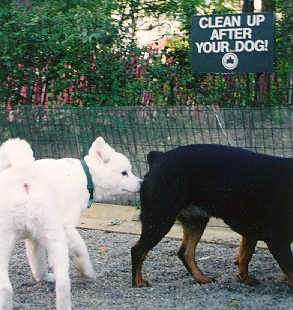
By now you're probably quite exhausted by your puppy-raising efforts. Hopefully, though, you are justifiably proud of your well-mannered, well-behaved, highly socialized dog with dependable bite inhibition. However...
Adolescence is a time of change.
To ensure that your attentive, mannerly and friendly puppy remains attentive, mannerly and friendly throughout adulthood, you need to accelerate socialization and training. Do not take your puppy’s stellar qualities for granted. Make a point always to praise your dog when he acts appropriately and to reward him whenever he is exceptionally well behaved.
Your dog needs to meet unfamiliar people on a regular basis. . In other words, your dog needs to be walked at least once a day. Your puppy may be taken for rides in the car and to visit friends' houses as early as you like. From the time your puppy is four months old, walk him on a regular basis — at least once a day. Otherwise, if your dog is confined to your house and only meets the same familiar people over and over, he will desocialize surprisingly quickly and soon grow to be wary and fearful of strangers, especially children and men.
Also, your dog needs to meet unfamiliar dogs on a regular basis. It is a fact of life that not all dogs get along. However, if you gave your puppy plenty of opportunities to play with other puppies and dogs and so develop solid bite inhibition, it is highly unlikely that your dog will injure another dog when scrapping. When dogs have reliable bite inhibition, most dogfights are no more than dog arguments. Continue socializing your dog with other dogs on walks and in parks.
The prime purpose of puppy husbandry is to produce a friendly, confident, and biddable pup, so that you can face the behavior and training challenges of your dog's adolescence, and your dog can deal with the immense social upheaval that dogs, especially males, face as they navigate adolescence. It is much easier to approach doggy adolescence with an already socialized and well-trained dog. However, maintaining your dog's socialization and training through his adolescence can be tricky if you don't know what to expect and how to deal with it.
Behavior is always changing, sometimes for the better, sometimes for the worse. Things will continue to improve if you continue working with your adolescent dog, but they will definitely get worse if you don't. Both behavior and temperament will tend to stabilize, for better or worse, as your dog matures around his second birthday for small dogs or third birthday for large dogs. But until then, if you don't keep on top of things, there can be precipitous and catastrophic changes in your dog's temperament and manners. Even when your dog reaches maturity, you should always be on the alert for the emergence of unwanted behaviors or traits, which you must quickly nip in the bud before they become hard-to-break habits.
Do you want to learn more about dog training?
Join The Top Dog Academy and get access to videos, worksheets, podcasts, and more, about dog training, using easy and effective methods that are enjoyable for you and your dog. When you join the Top Dog Academy you also get access to personalized email support so you can train your puppy yourself. Use this link to get your first month for free.
Adolescent Changes
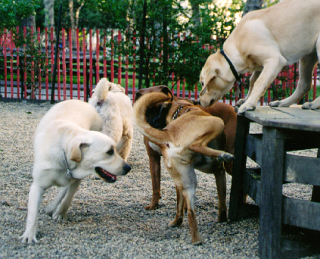
A dog's adolescence is the time when everything starts to fall apart, unless you make a concerted effort to see it through to the stability of adulthood. Your dog's adolescence is a critical time. If you ignore your dog's education now, you will soon find yourself living with an ill-mannered, under-socialized, hyperactive animal. Here are some things to watch for.
Household etiquette may deteriorate over time, especially if you start taking your dog's housetraining and other good behavior for granted. But if you taught your pup well in his earlier months, the drift in household etiquette will be slow until your dog reaches his sunset years, when housetraining especially tends to suffer.
Basic manners may take a sharp dive when puppy collides with adolescence. Lure/reward training your puppy was easy: you taught your pup to eagerly come, follow, sit, lie down, stand still, roll over, and look up to you with unwavering attention and respect because you were your pup's sun, moon, and stars. But now your dog is developing adult doggy interests, such as investigating other dogs' rear ends, sniffing urine and feces on the grass, rolling in unidentifiable smelly stuff, and chasing squirrels. Your dog's interests may quickly become distractions to training, so that your dog will continue sniffing another dog's rear end rather than come running when called. (What a scary thought, that your dog would prefer another dog's rear end to you!) All of a sudden he won't come, won't sit, won't settle down and stay, but instead jumps up, pulls on-leash, and becomes hyperactive.
Bite inhibition tends to drift as your dog gets older and develops more powerful jaws. Giving your dog ample opportunity to wrestle with other dogs, regularly handfeeding kibble and treats, and periodically examining and cleaning your dog's teeth are the best exercises to ensure that your adolescent dog maintains his soft mouth.
Socialization often heads downhill during adolescence, sometimes surprisingly precipitously. As they get older, dogs have fewer opportunities to meet unfamiliar people and dogs. Puppy classes and parties are often a thing of the past and most owners have established a set routine by the time their dog is five or six months old. At home, the dog interacts with the same familiar friends and family, and is walked, if at all, on the same route to the same dog park, where they encounter the same old people and the same old dogs. Consequently, many adolescent dogs become progressively desocialized toward unfamiliar people and dogs until eventually they become intolerant of all but a small inner circle of friends.
If your adolescent dog does not get out and about regularly and few unfamiliar people come to the house, his desocialization may be alarmingly rapid. At five months your dog was a social butterfly with nothing but wiggles and wags when greeting people, but by eight months of age he has become defensive and lacking in confidence: he barks and backs off, or he snaps and lunges with hackles raised. A previously friendly adolescent dog might suddenly and without much warning be spooked by a household guest.
Puppy socialization was a prelude to your safe and enjoyable continued socialization of your adolescent dog. However, your adolescent dog must continue meeting unfamiliar people regularly, otherwise he will progressively desocialize. Similarly, successful adolescent socialization makes it possible for you to safely and enjoyably continue to socialize your adult dog. Socialization is an on ongoing process.
Dog-Dog Socialization also deteriorates during adolescence, often at an alarming rate, especially for very small and very large dogs. First, teaching a dog to get along with every other dog is difficult. Groups of wild canids — wolves, coyotes, jackals, etc. — seldom welcome strangers into their midst, but that's exactly what we expect of Canis familiaris. Second, it is unrealistic to expect a dog to be best friends with every dog. Much like people, dogs have special friends, casual acquaintances, and individuals they don't particularly like. Third, it is quite natural for dogs (especially males) to squabble. In fact, it is a rare male dog that has never been involved in some physical altercation. Everything was fine with young pups playing in class and in parks, but with adolescent dogs, the scraps, the arguments, and even the play-fighting seem all too real.
A dog's first adolescent fight often marks the beginning of the end of his socialization with other dogs. Again, this is especially true for very small and very large dogs. Owners of small dogs are understandably concerned about their dog's safety and may be disinclined to allow their dogs to run with the big dogs. Here is where socialization starts downhill and the small dog becomes increasingly snappy and scrappy. Similarly, owners of large dogs (especially the working breeds) are understandably concerned that their dogs might hurt smaller dogs. Here too socialization goes downhill and the big dog becomes increasingly snappy and scrappy. Now we're in vicious circle: the less the dog is socialized, the more likely he is to fight and thus be less socialized.
Adapted from AFTER You Get Your Puppy by Dr. Ian Dunbar
Fighting
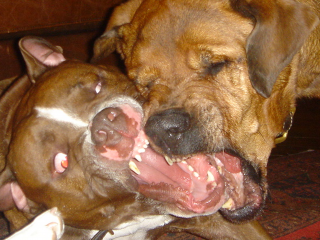
"He fights all the time! He's trying to kill other dogs!"
The fury and noise of a dogfight can be quite scary for onlookers, especially the dogs' owners. In fact, nothing upsets owners more than a dogfight. Consequently, owners must strive to be objective when assessing the seriousness of a dogfight. Otherwise, a single dogfight can put an end to their dogs' socialization. In most cases, a dogfight is highly stereotyped, controlled, and relatively safe. With appropriate feedback from the owner, the prognosis for resolution is good. On the other hand, irrational or emotional feedback, besides being upsetting for the owner, can exacerbate the problem for the dog.
It is extremely common for dogs, especially adolescent males, to posture, stare, growl, snarl, snap, and maybe fight. This is not "bad" dog behavior, but rather reflects what dogs normally do. Dogs do not write letters of complaint or call their lawyers. Growling and fighting, however, almost always reflect an underlying lack of confidence, characteristic of male adolescence. Given time and continued socialization, adolescent dogs normally develop confidence and no longer feel the need to continually prove themselves. To have the confidence to continue socializing a dog that has instigated a fight, the owner must convince herself that her "fighting dog" is not dangerous. A dog may be obnoxious and a royal pain, but this does not mean he would hurt another dog. Whereas growling and fighting are normal developmental behaviors, causing harm to other dogs is decidedly abnormal and unaceptable.
First, you need to ascertain the severity of the problem. Second, you need to make sure you react appropriately when your dog fights, and give appropriate feedback when he doesn't.
To know whether or not you have a problem, establish your dog's Fight-Bite Ratio. To do this you need to answer two questions: How many times has your dog been involved in a full-contact fight? And in how many fights did the other dog have to be taken to the veterinarian?
Ten-to-Zero is a common Fight-Bite Ratio for one- to two-year-old male dogs, that is, ten full-contact fights with opponents taking zero trips to the vet. We do not have a serious problem here. Obviously the dog is not "trying to kill" the other dog, since he hasn't caused any injury in ten fights. The dog would have caused damage if he had meant to. Moreover, on each occasion, the dog adhered to the Marquis of Dogsberry Fighting Rules by restricting bites to the other dog's scruff, neck, head, and muzzle. Surely, there is no better proof of the effectiveness of bite inhibition than, when in a fighting frenzy, one dog grasps another by the soft part of his throat and yet no damage is done.
This is not a dangerous dog. He is merely socially obnoxious in the inimitable manner of male adolescents. Yes, the dog is a bit of a pain, but he has wonderful bite inhibition (established during puppyhood) and has never injured another dog. Solid evidence of reliable bite inhibition — ten fights with zero bites while adhering to fighting rules — makes it extremely unlikely that this dog will ever harm another dog.
Fights are bad news, but they usually provide good news! As long as your dog never harms another dog, each fight provides additional proof that your dog has reliable bite inhibition. Your dog may lack confidence and social grace, but at least his jaws are safe. He is not a dangerous dog. Consequently, resolution of the problem will be fairly simple. Of course, you still have an obnoxious dog in dire need of retraining, since your dog is annoying other dogs and owners just as much as he annoys you. Contact the Association of Pet Dog Trainers to find a Fiesty Fido, Difficult Dog, or Growl Class.
On the other hand, if your dog has inflicted serious wounds to the limbs and abdomen of his opponents in just one of his fights, then you have a serious problem. This is a dangerous dog, since he has no bite inhibition. Obviously, the dog should be muzzled whenever on public property. The prognosis is poor, treatment will be complicated, time-consuming, potentially dangerous, requiring expert help, and certainly with small guarantee of a positive outcome. No dog problem presents such a marked contrast between prevention and treatment.
An adult fighter with no bite inhibition is the very hardest dog to rehabilitate, but prevention in puppyhood is easy, effortless, and enjoyable: simply enroll your puppy in puppy classes and take him to the park regularly. Do not wait for your adolescent dog to get into a fight to let him know you don't like it. Instead, make a habit of praising and rewarding your puppy every time he greets another dog in a friendly fashion. I know it may sound a little silly — praising your harmless, wiggly four-month-old male pup and offering a food treat every time he doesn't fight — but it's the best way to prevent fighting from becoming a serious problem.
Adapted from AFTER You Get Your Puppy by Dr. Ian Dunbar
Preventing Adolescent Problems
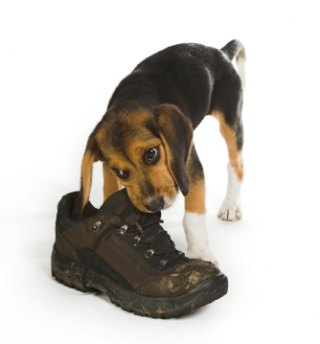
Always make a point of praising your dog and offering a couple of treats whenever he eliminates in the right place. Keep a treat container by your dog's toilet area. You need to be there anyway to inspect and pick up your dog's feces (before the stool becomes home and dinner for several hundred baby flies). Remember, you want your dog to want to eliminate in his toilet area and to be highly motivated to do so, even when he develops geriatric incontinence.
Similarly, a stuffed Kong a day will continue to keep the behavior doctor away. Your dog still needs some form of occupational therapy to idle away the time when left at home alone. There is no magic potion and there is no drug that will prevent household problems, such as destructive chewing, excessive barking, and hyperactivity, or alleviate boredom, stress, and anxiety as quickly, easily and effectively as stuffing your dog's daily diet of kibble into a few Kongs.
For your adolescent dog to continue to be reliably obedient and willingly compliant, you must integrate short training interludes, especially emergency sits and long settle-downs, into walks, play sessions, and your dog's other enjoyable day-to-day activities. Maintaining your dog's manners through adolescence is easy if you know how to, but extremely difficult if you don't. You must learn how to integrate training into the dog’s lifestyle.
Should socialization ever fail and your dog snap, lunge, or nip a person, you will be thankful that you had the good sense to take your puppy to classes where he learned reliable bite inhibition. Your dog's defensive actions cause no harm but they warn you that you'd better quickly revamp your dog's socialization program and maintain his bite inhibition exercises before it happens again. Which it will. Continue bite inhibition exercises indefinitely. Occasionally handfeed your dog and examine his muzzle and teeth (and maybe clean them) on a regular basis.
The secret to a well-socialized adult dog is at least one walk a day and a couple of trips a week to the dog park. Try to find different walks and different dog parks, so that your dog meets a variety of different dogs and people. Socialization means training your dog to meet and get along with unfamiliar dogs and people. The only way to accomplish this is for your dog to continue meeting unfamiliar people and dogs daily. Praise your dog and offer a piece of kibble every time he meets an unfamiliar dog or person.
And don't forget to maintain your own improved social life by inviting your friends over at least once a week, just to keep them still involved in training your dog. Ask them to bring along somebody new to meet your dog.
Host a puppy party and invite your dog's buddies from puppy class and the dog park. To offset some of the scarier aspects of the dog world at large — adult dogs, big dogs, and occasionally unfriendly dogs — make sure your adolescent dog has regular opportunity to socialize and play with his core companions from puppy school.
Adapted from AFTER You Get Your Puppy by Dr. Ian Dunbar
Ch 5: Adult Dog Training (2 years+)
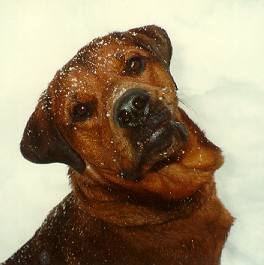
As dogs mature, they develop many doggy interests that may compete with dog training. For example, dogs may find that sniffing the grass, playing with other dogs and chasing squirrels are all much more exciting than listening to their owners and following repetitive instructions — come, sit, down, heel, sit, heel, sit, etc. Puppy training techniques begin to fail, environmental stimulation causes sensory overload and many dogs become hyperactive or reactive to other dogs and people. Owners become frustrated by the dog’s hyperactivity and inattentiveness and the relationship starts to go downhill.
Unless regularly given the opportunity to explore new surroundings and meet unfamiliar people and dogs, as dogs grow older, they become less accepting of their environment. Older dogs become more wary of the world in general and especially of strange, scary and unfamiliar stimuli. Make sure you give your adult dog plenty of time to adjust to new situations and employ classical conditioning to build positive associations when introducing dogs to new experiences or people.
The very first item on the agenda is to learn to control your dog’s rambunctiousness and rumbustiousness. A very successful training ploy is to “put behavior problems on cue” — to train the dog to bounce and bark on command, as in the Jazz-up & Settle Down and the Woof/Shush exercises. Then, the problem, which worked against training, now becomes an enjoyable game — a reward to use while training. Classical conditioning has an additional calming effect by teaching the dog to form positive associations with the physical and social environment. However, the success of adult dog training depends on the magical All-or-None Reward Training techniques.
All-or-none reward training techniques are easy, simple and extremely effective. The techniques have similarities to clicker training in that no commands are given and the dogs are neither lured nor prompted. However, all-or-none reward training is much quicker than clicker training since shaping is unnecessary. Within just a few minutes, without giving a single instruction, your dog will learn to pay attention, sit stay and to walk calmly on leash. And once all-or-none reward training techniques give you back your dog’s attention, you can go back to using the lightning-fast, lure/reward training techniques that you used with your puppy.
Important
To fast-track your adult dog’s re-education, make sure that you do not waste potential training rewards by feeding your dog from a bowl. Instead, each morning, weigh out your dog’s daily ration of kibble and place it in a container. Throughout the course of the day, you may handfeed every piece of kibble as a reward for good behavior.
Jazz Up & Settle Down
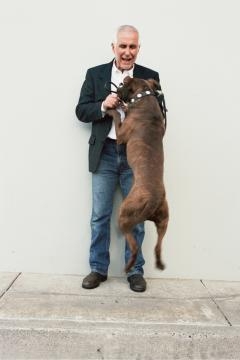
Many owners experience great difficulty and frustration trying to get their adolescent dogs to settle down. Many dogs bark and bounce like crazy when the front doorbell rings. Dogs perform moon loops just because the owner says, “Walkies,” or picks up the dog’s leash. And on walks, some dogs literally explode with activity and uncontrollable enthusiasm at the mere prospect of meeting a person, another dog, a squirrel, or a leaf.
Many owners ignore their dogs when they are calm and well behaved and only attempt to control the dog’s behavior when he is really out of control. Obviously, this is a most challenging way to train. And it isn’t going to work that well. First, owners should practice settling down their dogs in easier scenarios — when the dog is less excited, or even when the dog perfectly calm and relaxed. For example, while your dog is snoozing on his bed, ask him to join you to settle down on the couch. Your dog would be only willing to obey. Then owners should settle down the dog in more distracting settings. For example, when walking your dog, ask him to settle down every 25 yards and by the end of just one walk, you’ll have a very different dog — much more attentive and biddable. Finally though, owners must “confront the beast “and learn how to teach Mr. Hyperdog to settle down quickly and willingly, anytime and anywhere. This is one of the first adolescent exercises that we teach at SIRIUS® Dog Training, because this is precisely what owners have come to learn. In many adult dog training classes, dogs are never allowed to bark and bounce or express their enthusiasm and so, owners can never learn how to settle down their dogs when they are excited. Obviously, we have to allow dogs to bark and bounce in order to practice teaching them to settle down and shush. However, rather than let the dogs be rambunctious at will, we teach the dog’s to be rambunctious on cue.
Interestingly, as soon as we instruct owners to jolly up their dogs and get them to vocalize and jump in the air, most dogs simply stand and stare and observe their owners with some considerable curiosity. This is a classic example of Murphy’s First Law of Dog Training: When trying to teach a particular behavior, usually the opposite happens. With a little encouragement though, most owners quickly learn to teach their dogs to jazz up on cue, whereupon the owners may now, at their convenience, repeatedly practice teaching their dogs to settle down on cue. The jazz-up-and-settle-down sequence is repeated until every owner can get their dog to settle down and shush within three seconds.
Once the owner has taught their dog to perform a “problem” behavior on cue, the behavior is no longer a problem that works against training, instead the activity may now be used as reward to reinforce training. For example, after a lengthy period of settle-and-shush, you may instruct your dog to bounce, circle, bark, rollover, or tug as a reward. After walking calmly on leash, you may instruct your dog to pull as a reward. (Especially useful when going uphill.)
An additional benefit of having activity problems on cue is that you may now instruct your dog to let off steam when the time is convenient. For example, I would always instruct my Malamute to stick his head out of the sunroof and howl whenever we were stuck in commuter traffic on the San Francisco Bay Bridge. In fact, once, during an especially lengthy traffic jam, a BMW driver followed suit and howled back!
Classical Conditioning
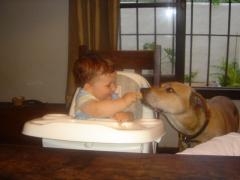
Whereas eight-week-old puppies are universally accepting of people, adolescent dogs naturally become wary of anything unfamiliar, including noises, objects, dogs, people and places. It is not uncommon for adolescent dogs to become fearful or reactive. As puppies grow older, the world becomes a scarier place. To prevent dogs from becoming wary of children, men, strangers, skateboarders, other dogs, loud noises, vacuum cleaners, nail clippers, collar grabs, etc. etc. etc., take your time when exposing your puppy, adolescent, or newly adopted adult dog to novel (unfamiliar) stimuli, settings and situations and make sure you classically condition your dog not only to tolerate, but also to thoroughly enjoy all of these potentially scary stimuli.
Simply put, classical conditioning helps your dog form positive associations with all sorts of stimuli. Let’s say your puppy has grown to be scared of men. Rather than feeding your dog in a bowl, use his entire allotment of kibble for classical conditioning. For one week, take your dog to dine downtown. Sit on a bench and offer him a piece of dinner kibble each time a man walks by. For a second week, ask male passersby, “Excuse me, would you mind hand-feeding my dog? He’s really shy of men.” In no time at all, your dog will form a positive association between men and FOOD and might muse, “Ah yes, I love men.”
The most important times to classically condition your dog are when visitors come to your house, on walks, in dog parks and especially during dog training classes.
From puppyhood onwards, have every visitor to your house offer your dog a few pieces of kibble. Even though your puppy may be Mr. Sociable right now, unless you take this precaution, he will most certainly become more standoffish, asocial, and maybe antisocial as he grows older. Please do not take your puppies golden demeanor for granted. Have every household visitor offer a food treat to your puppy/dog and then your dog will look forward to visitors. Additionally, teach each visitor how to use the treat to teach your dog to come, sit and stay.
Most people walk their dogs too quickly through the environment. There is simply too much for the dog to take in — people, other dogs, other animals, noises and smells — “Oh there’s a squirrel. I smell Trixie. Hmm! I just love the smell of her urine. Trixie! Trixie! Trixie! Son of a female dog! That motorcycle was soooooo loud! Oh, oh, oh! Cat poo! Woo hoo! Yes!!! And another squirrel. Two squirrels Oh what’s my owner saying now? Oh, S.O.A.F.D! There’s Bruno. OH he’s HUGE! And his owner looks nervous. Why’s my owner jerking my leash? Is that a discarded hamburger wrapping. There’s a cat. I know there’s a cat. Can’t see it. Can’t hear it. Can’t smell it, but I know it’s there somewhere. I can feel it. She’s looking at me. Where is she? Oh NO! Children! I hope they don’t come this way. Another squirrel. Is that the mail truck three blocks away? I hope I get back home before he come.” And so it goes on. The dog’s brain goes into sensory overload. The dog is over-stimulated and instead of paying attention to his owner he becomes hyperactive or reactive.
When walking a dog, on-leash or off-leash, stop every 25 yards, let the dog take his time to look, listen and sniff and wait until he establishes eye contact (acknowledges your presence) and accepts a couple of pieces of kibble before saying “Let’s go” and continuing the walk for another 25 yards. Every couple of hundred yards, find a comfortable place to sit and wait for your dog to settle down and get used to the new environment. Offer your dog a piece of kibble every time the environment changes, for example, each time a person passes by, and maybe two pieces of kibble for a man, a piece of freeze-dried liver for a boy, and three pieces of liver for a boy on a skateboard.
When dogs visit unfamiliar environments, offering then kibble is a great temperament test for trainers, veterinarians and owners to check that the dog is at ease. If the dog refuses kibble from the owner, he is probably anxious about the environment — so give him time to adapt. However, if the dog accepts kibble from his owner but not from his veterinarian or trainer, then the dog most probably feels ill at ease with the veterinarian or trainer and so, proceed slowly — verrrry slowly.
For an adolescent or young adult dog, dog parks and training classes can be pretty scary environments, usually with a high-voltage social scene. Always give the dog a chance to relax and get used to the environment. Before attempting to train, wait until the dog settles down and appears and ease. Periodically keep offering pieces of kibble. Once the dog feels at ease, he will take the kibble and start to pay attention. Keep offering the kibble regardless of the dog’s behavior; it doesn’t matter whether the dog is hiding and peeking, barking, growling, or snapping and lunging. Keep offering the kibble so that the dog eventually forms positive associations with the class setting, the other dogs, the trainer, and other people.
Some people are afraid that offering kibble during classical conditioning might unintentionally reinforce bad behaviors. Certainly, when training, we are always classically conditioning and operantly conditioning at the same time. If you use your voice when classically conditioning, “There’s a good boy, it’s OK,” you might unintentionally reinforce all sorts of unwanted behavior. The classical conditioning still works for us but the operant conditioning works against us and makes the problem worse. In time, the dog will begin to feel OK about the situation but will continue barking and growling, or hiding and shaking, because that’s what he’s been unintentionally trained to do. However, by using food when classically conditioning, you can only reinforce good behavior because a dog cannot bark and lunge or eyeball another dog at the same time as turning to face you to take food.
For example, let’s say we are trying to classically condition a dog that is barking and lunging at another dog. We offer food, but the dog ignores our offerings and continues barking and lunging. Eventually though, the dog barks himself out and sniffs the food, whereupon he turns away from the other dog to take the food. Taking the food does not reinforce the dog’s barking and lunging. On the contrary, the food reinforces the dog for stopping barking and lunging, for turning away from the other dog and for turning towards his owner. After a couple of dozen repetitions, the dog will begin to form positive associations with the sight of other dogs. “I love it when other dogs approach because then my owner feeds me dinner.” And as a bonus, the dog’s trained response to seeing another dog is to turn away from the dog and to sit quietly and expectantly facing his owner.
As classical conditioning proceeds, the dog is less and less inclined to react in a negative manner towards the scary stimulus. Once a dog forms positive associations with stimuli, such as a vacuum cleaner, other dogs, or people, he doesn’t want to growl or snap and lunge at them.
You simply cannot do too much classical conditioning. Remember…
Operant Conditioning Rocks! But…
Classical Conditioning Rules!
All-or-None Reward Training
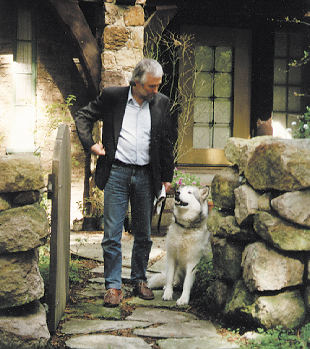
All-or-none reward training is the quintessence — the sine qua non — of successful adult dog training. All-or-none reward training techniques are easy, simple and extremely effective. The techniques have similarities to clicker training in that no commands are given and the dogs are neither lured nor prompted. However, all-or-none reward training is much quicker than clicker training since shaping is unnecessary. Within just a few minutes, without giving a single instruction, your dog will learn to pay attention, not to touch forbidden food and objects, sit stay and to walk calmly on leash. And once all-or-none reward training techniques give you back your dog’s attention, you can go back to using the lightning-fast, lure/reward training techniques that you used with your puppy.
Good Behavior
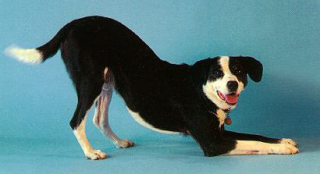
Taking the good for granted and moaning and groaning about the bad is without a doubt, our biggest human foible. Rather than relishing all wonderful things about life, we tend to focus on problems. This tendency is extreme when people interact with their family, friends, colleagues, dogs and horses, and especially when people evaluate their own lives.
For years and years, dog training was almost entirely problem-based. People would offer limited supervision and instruction to their dogs and them punish them whenever they broke rules that they didn’t even know existed. Yet, if we objectively time-sample behavior, we find that even very badly behaved (uneducated) dogs (and people) are actually good most of the time. For example, observe your dog for half an hour and every two minutes or so ask the simple question, “Is he being good or bad?” You will find that he is being good well over 90% of the time. But in the normal course of the day, most of a dog’s good behaviors are ignored. Instead owners are more likely to pay attention to the dog when he barks, or when he steals, chews or runs away with inappropriate articles. So much so in fact, that many dogs quickly learn that misbehaving is the very best way to get their owners attention. Indeed, many dogs will bark, steal, chew and run away with inappropriate articles simply to get their owners to respond or at least acknowledge their existence.
Dogs are social animals and absolutely thrive on social interaction, communication and feedback regarding the appropriateness of their behaviors. Dogs need oodles and oodles of attention (and affection), so lets give it to them when they are good.
One of the most magically powerful training techniques is to ignore all unwanted and inappropriate behavior and instead, to pay attention to and reinforce good behaviors.
Observe your dog and whenever he does something you like, simply say, “Good dog” and give him a piece of kibble. For example, reward your dog whenever he sits, lies down, stops whining/barking/howling/growling (shushes), stops jumping (four on the floor), looks at you, or looks cute.
Unwanted behavior offers a wonderful dog training opportunity because now owners may reward their dog for ceasing undesirable behavior. Reinforcing the cessation of misbehavior is the training technique of choice when trying to eliminate whining, growling and running away, because punishment would only exacerbate the problem, making the dog more likely to whine, growl and run away.
Similarly, rewarding a dog for the absence of misbehavior is an extremely effective training technique. Sometimes the dog may look like he isn’t doing much. But that’s precisely the point! The dog may just stand there wagging his tail, but just think of all the annoying and worrying things he could have been doing. He could have been barking, snarling, snapping, or biting! So, let’s reward dogs for not acting fearfully or antisocially.
Or, you might decide to actively reward your dog for any sociable, friendly or appeasing behavior, such as when he approaches, wags his tail, wags his butt, sticks out his tongue, raises a paw, play bows, or rhythmically shifts his weight back and forth from front paw to front paw.
Obviously, simply ignoring unwanted behavior will not cause it to be eliminated entirely, but you will see a speedy and dramatic reduction in the frequency of undesirable behavior because the dog now allocates most of his time for good behaviors, which are successful in soliciting the owner’s attention and affection, and so there is simply no time for bad behavior. After just a couple of dozen rewards, you will find that your dog is sitting and looking up at you — a perfect sit-stay and perfect unwavering attention. And you didn’t ask for a thing. All you said was, “Thank you!”
In this section, I have sometimes used the words “good” and “bad” to describe behavior. However, it is unlikely that dogs have a solid cognitive grasp on ethics and morality, or even about the concepts of good and bad. Dogs behave (chew, bark, growl, pull on leash, run away etc.) the way they do simply because that’s the way dogs behave and that’s the way owners have trained or allowed the dogs to behave. By “good” behavior, I mean behavior that owners consider to be desirable, appropriate or acceptable and by “bad” behavior, I mean behavior that owners consider to be undesirable, inappropriate or unacceptable
Pay Attention
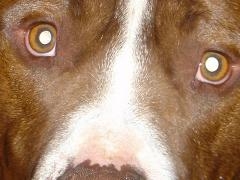
When puppies reach adolescence, food lures temporarily lose effectiveness. The owner and their food lures now have to compete for the dog’s attention with all the more interesting stimuli in the environment. Indeed it is a rude awakening for many owners to discover that their dogs are much more interested in sniffing another dog’s butt or chasing a squirrel than paying attention to them. Most owners resort to upping the olfactory punch (and price) of their food lures. But this seldom works for long. In fact, you may identify forlorn and exasperated owners of adolescent dogs by smell, since they have finally resorted to using dried fish as a lure.
With adolescent dogs we need to temporarily change the type of lure from food to toys. Retrieval toys and tug o’ war toys work the best. Get your dog hooked on fetch or tug and then you may use the toys as lures and rewards to teach him almost anything.
Another approach is to temporarily put food lures aside and to train your dog to pay attention by using all-or-none reward training. Once your dog is paying attention once more, food lure/reward training will work as quickly and as effectively as before.
From simply paying attention to and rewarding your dog for desired behavior as described in the previous exercise, you will find that your dog is much calmer and spends much more time sitting and watching you. This is good. But now we are going to specifically train your dog to pay attention. You may perform this exercise off-leash at home or on-leash on a walk. Rather than feeding your dog from a bowl, weigh out and use his daily allotment of kibble for this and other exercises. Once you have regained your dog’s attention, kibble rewards will be unnecessary and you may feed him how you like. With an attentive dog, your praise will be more than sufficient to further reinforce his attention.
Ignore everything your dog does until he glances at you for an instant. It doesn’t matter how long you have to wait or how short the glance. For the first couple of trials you may have to wait for several minutes but soon you will find your dog will look at you within seconds. As soon as your dog glances at you, say, “Good Dog,” reward him with a piece of kibble and then take one large step (to break his gaze) and wait for him to glance at you again. After a couple of reinforced glances, up the ante in terms of time of attention required for a reward — first one second of attention, then two seconds, three, five, eight, and so on. Count out the time of attention in “good dogs” — “Good dog one. Good dog two. Good dog three, etc.” Once your dog is paying attention for 20 or 30 seconds, you will notice that he is also in a sit-stay.
Now we are going to make it a little more challenging for your dog. After praising and rewarding your dog for looking at you, as you step away, turn your back on your dog to intentionally break his gaze. Give him plenty of time because now he has to work out that staring at your backside is not sufficient, but instead he has to come round in front of you to “find your face.” Praise your dog as soon as he looks up at you and then repeat the sequence.
After a few trials, it’s time to teach your dog to pay attention on cue. Say, “Watch me,” turn away from your dog and praise him as soon as he makes eye contact. Now you will be able to perform this attention exercise in motion by asking your dog to “Watch” while you serpentine backwards away from your dog. Alternatively, ask your dog to watch you while heeling, or during sit-, down- and stand-stays.
Sit-Stay & Walk On-Leash
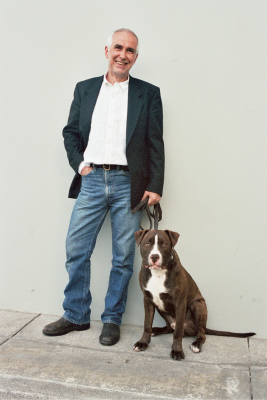
This is one of my all-time favorite training exercises — simply scary in simplicity and shocking in terms of magical results. This exercise actually provides the secret information that some gawdy websites promise over and over but never actually deliver. Watch our videos and see for yourself.
You start with an over-the-top, Iditarod-level leash-puller, who hasn’t paid attention to you for months, or years, and after just ten minutes fun training, you recreate your attentive dog who walks calmly on leash, looks up at you when you slow down and automatically sit-stays when you stop.
Until such a time as your dog is trained to your satisfaction, weigh out and use your dog’s daily allotment of kibble for this and other exercises. You may perform this exercise at home (indoors or outdoors) or on a walk.
Stand still, holding the leash in one hand and kibble in the other with both hands held high up and close to the body. Ignore everything your dog does until he sits. It doesn’t matter how long it takes. Eventually, your dog will sit. Many dogs will go through an entire repertoire of behaviors that worked in the past to make you walk. The dog may lunge into the leash, bark, circle and jump-up. Just stand still and ignore your dog’s unwanted antics. Wait for your dog to sit.
The longer your dog takes to sit, the better he learns that his previous attention-getting and leash-pulling antics no longer work. When he eventually sits and receives immediate praise and a piece of kibble, he will have a Eureka-experience. “Ahhhh! So sitting is the secret to get my owner to move forwards.”
As soon as your dog sits, immediately say, "Good dog," offer a food treat, and then take one huge step, stand still and wait for your dog to sit again. Your dog will likely explode to the end of the leash, thereby illustrating the reinforcing nature of you taking just one step. Wait for your dog to sit again. Most likely he will not take as long this time. When your dog sits, praise, offer a piece of kibble, take one big step and stand still once more. Repeat this sequence until your dog moves forward calmly (because he knows you are only going to take one step) and sits promptly when you stop and stand still.
Your dog has now learned he has the power to make you stop and the power to make you go. If he tightens the leash, or bounces and barks like the proverbial banana, you stop. But if he slackens the tension on the leash and sits, you take a step. After a series of single steps and standstills without pulling, try taking two steps at a time. Then go for three steps, then five, eight, twelve, and so on. Now you will find your dog will walk attentively on a loose leash and sit automatically whenever you stop. And the only words you have said were "Good dog."
Occasionally, stand still and delay giving the kibble for longer and longer periods. Praise your dog as he remains looking up at you in a sit-stay. Count out the length of the sit-stay in “good dogs”—“Good dog one. Good dog two. Good dog three, etc.”
Now we are going to teach the dog to walk by your left side. Repeat the one-step-and-sit sequence as before but this time, when you take the one big step, rotate clockwise or counterclockwise through 90, 180, or 270 degrees and stand still and wait for your dog to sit by your left side. (If you would like to walk your dog on your right side, that’s perfectly OK. Most trainers teach dogs to walk on the left.) Once your dog sits reliably by your left side each time you stop, start to thin out the food rewards and only reward the dog for straighter sits. Gradually and progressively increase the number of steps you take with each repetition. Now your dog is heeling when you walk and automatically sitting when you stop.
Alternate heeling and walking on-leash. For most of the walk, let your dog range and sniff on a loose leash, but every 25 yards or so, have your dog sit, heel, and sit, and then walk on again. Always sit-heel-sit your dog when crossing a street: sit before crossing, heel across, and then sit on the other side of the street.
Housetraining Tip
It is a good idea to have your dog eliminate before beginning a walk. It is so much easier to clean up and dispose of feces close to home. An empty dog will not pee over neighbors’ lawns or cause you to have to complete the walk carrying a plastic baggie of dog doo. To teach your dog to eliminate promptly, leave your house, stand still, instruct your dog, “Go pee, go poop,” and wait. When your dog pees, praise and offer kibble. Increase the length and enthusiasm of praise and the number of pieces of kibble according to the length of the pee. No praise for quick pretend pees, a “good dog” and a single piece of kibble for a two-second pee, “gooood dog” and two pieces of kibble for a three-second pee, etc. When your dog poops, celebrate with songs of praise and treats and say, “Walkies!” If your dog does not poop within three minutes, go back inside and walk your dog half an hour later. With a simple “no-poop-no walk” policy, you’ll soon have the speediest defecator on the planet.
Off & Take it
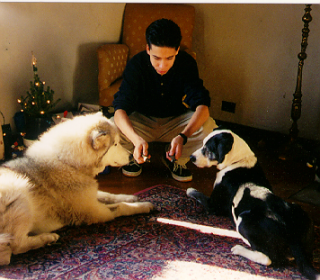
A major criticism of using food in training is that the dog may become over excited, worry at the food, or even bite the hand that feeds it. However, the use of food is indispensable for classical conditioning, temperament training and behavior modification. Also using food and toy lures and rewards just makes teaching basic manners easier, quicker and just so much more fun for owners. Even so, food is used only initially to teach the dog what we want him to do. Once the dog learns the meaning of our handsignals and verbal instructions, food is no longer necessary as a lure. Also, we want to phase out food rewards and replace them with more meaningful Life Rewards (toys, games, and activities) as quickly as possible. See Food Critics
For the meantime though, we want to teach dogs to pay attention to food in our hands but never to touch, unless requested to “Take it.” The process is simple. Hold a piece of kibble in a clenched fist in front of your dog’s nose and ignore everything your dog does (licking, nibbling, or pawing your hand). Immediately praise your dog the moment he ceases contact with your hand and then say, “Take it” and open your fist so the dog may take the kibble from the palm of your hand. Repeat the sequence several times. After six to eight repetitions, you will find that your dog will quickly pull his muzzle back when you present the kibble in your fist. On subsequent trials, say, “Off,” “Don’t Touch,” or “Leave it” before presenting your fist. Count out the period of non-contact in “good dogs,” and say, “Take it” before presenting the kibble on the palm of your hand. You will also notice your dog is in a sit-stay and looking up at you with great attention.
Teaching “Off” is extremely useful for instructing your dog not to touch all sorts of things, such as, food on the coffee table, food you’re eating, food that children are eating, used-diapers, the baby, a shy dog, the cat, cat feces, or any feces or carrion. Also, by teaching “off” your dog also learns “Take it,” which will facilitate teaching your dog to retrieve and play tug o’ war according to the rules.
More Lure/Reward Training
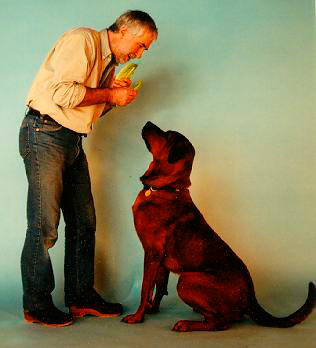
LURE/REWARD TRAINING
The science of lure/reward training is pure and simple —as simple, in fact, as 1–2–3–4:
1. Request
2. Lure,
3. Response
4. Reward.
For example: 1. Say, “Sit,” 2. Lure the dog to sit by moving a food lure upwards in front of the dog’s nose, so that 3. As the dog raises his head to follow the food, he compensates by lowering his rump to the ground and sits — the desired Response and so, 4. Reward the dog with a scratch behind his ear, by throwing Tennis Tug ball to retrieve, or simply just give him the food.
Anyone may master the science of lure/reward training within seconds. However, it can take a lifetime to master the art. The art of lure/reward training comprises creating and compiling an exhaustive repertoire of innovative techniques to lure an animal to quickly and voluntarily perform the desired response, so that the animal may be requested to do so beforehand and immediately rewarded for doing so afterwards.
Lure/reward training may be used to quickly and easily teach your dog:
Body position changes — sit, down (sphinx, bang, side, settle), stand, rollover, beg, bow, bang, etc.,
Stays — sit-stay, down-stay (both prone and supine) and stand-stay,
Actions — heeling, jumping, backing up, walking backwards, walking on hind legs, doggy dancing and woofing and shushing on cue
Position Changes & Stays
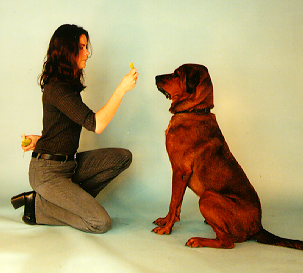
Once you have used all-or-none reward training techniques to teach your dog to sit- and down-stay, to pay attention, to walk on leash and not to touch, you will find that your dog is now so much calmer and that you have regained his attention. Now it is again possible to use the lure/reward training techniques that worked so well in puppyhood.
Lure/Reward training is the fastest pet dog training technique to teach your dog the meaning of the instructions you use. There is no need to spend time shaping behavior. The dog is lured to perform the desired behavior on the very first trial. Consequently, the dog may also start forming an association between the command and the relevant desired behavior from the very first trial. Lure/Reward training position changes has been described in some detail in the Puppy Training chapter, Lure/Reward Training and so please go back and review that section.
The science of lure/reward training is simple and comprises a four-step process:
1. Request, 2. Lure, 3. Response, 4. Reward
When this sequence is repeated a number of times, the reward will reinforce the desired behavior which will increase in frequency and also, the reward will reinforce the associations between the Request and the Lure-movement (handsignal) and between the Lure and the relevant Response. Your dog will quickly learn to respond correctly to your handsignals, because dogs commonly communicate by body language. However, it will take a long time for your dog to learn to respond reliably to verbal commands.
The art of lure/reward training focuses on discovering the best way to immediately lure the dog to voluntarily perform the desired behavior. Food makes the best lure for initial training (at home and in puppy class) but toy lures are better for adolescent and adult dogs. Use chewtoys, squeakies, tennis balls, Frisbees, and tug o’ war toys to play-train your dog.
Once your dog is focused on the lure, he will follow any lure-movement with his nose, eyes, and ears. If he moves his nose, his head will move. If he moves his head and neck , his whole body will move. So to lure a dog to sit, move the lure upwards over his head. To get a dog to lie down, lower the lure to the ground between his front paws. To lure a dog to stand, move the lure away from his muzzle.
A cardinal rule in dog training is to always work with a minimum of three commands, so that the dog cannot anticipate the next command (as often happens when training for obedience competition). For example, if you always teach sit-stay before a recall, soon the words “Sit-Stay” will come to mean “ready… steady… GO!” and the stay will break down. On the other hand if you work with “Sit,” “Down” and “Come Here” at the same time, the dog can never predict the next command but has to wait for you to say it and so, learns to pay greater attention. If he is in a sit, he doesn’t know whether the next command will be “Down” or “Come Here.”
Anticipation is very dangerous. You do not want your dog to rush off when you say “Good Dog” but he will do if you have always said, “Go Play” immediately after praising your dog “Good Dog.” Because he now thinks that “Good Dog” means “Go Play.”
When teaching position changes, always work with three positions at the same time, for example sit, down and stand. Ask the dog to move from one body position to another. Randomize the order of the body positions. You will soon realize, that you are not simply teaching yourdog three body positions, but rather you are teaching six different body positions changes. For example, you are teaching your dog to both sit from stand (very easy) but also to sit up from the down (harder). Also, you are teaching your dog to lie down from the sit (easy) and lie down from the stand (much harder). And of course, very few people teach their dogs to stand, which means that the sit and down will be sloppy and unreliable too, because the owner is only yo-yoing the dog between two body positions. And so the dog learns, “If I am sitting, then whatever they say, I’ll lie down.” And so the dog never learns that he must listen to whatever you say.
Japan offers a wonderful exception. Dogs in Japan have the very best stand-stays because after returning home from a walk their owners instruct their dogs to stand for several minutes while they clean their dogs paws before allowing them to go inside.
To test that your dog comprehends verbal instructions for all six body position changes, take one step back from your dog and ask him to come and…
“Sit-Down-Sit-Stand-Down-Stand.”
Go for a walk and every 25 yards ask your dog to perform the S-D-S-St-D-St sequence. After just one walk, he will become extremely reliable. Reliability is important. If your dog follows your instructions, you will not become frustrated or angry and your dog will not be reprimanded or punished.
Once your dog performs random position changes quickly and reliably, praise him for longer and longer (count out the time in “good dogs”) in each position before offering him a food reward. Now, you may be able to practice random length stays in each body position. Keep track of your dog’s record length stays in each position so that you can try to beat your personal best during the next training session.
Now it’s time to teach your dog other body position changes, such as, Down on-Side, Supine-Down, Beg, Bow, Creep, Roll Over etc.
Distance Position Changes
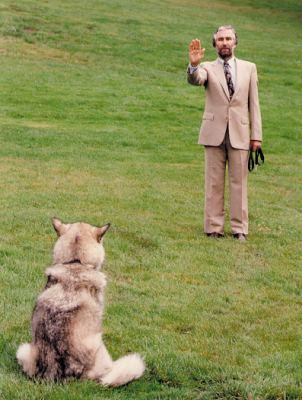
Even though you think your dog sits fairly reliably, he probably will not sit if he is at a distance. In fact he probably will not sit if there is any variation in the training scenario. If you turn your back on him and ask him to sit, he probably won’t. If you lie on your back and ask him to sit, he probably won’t. If you ask him to sit in heel position as you continue walking, he probably won’t. But don’t worry, your dog is not being disobedient. Rather, like all dogs, he is an extremely fine discriminator and has only learned precisely what you have taught him — to sit if he is right in front of you, or if he is by your side in heel position. So, you need to teach him to sit in every possible situation and especially, if he is at a distance and distracted.
The dog’s failure to comprehend is difficult for owners to understand at first but teaching dogs is very different from teaching people. A person will generalize from one training scenario to all others, whereas a dog only learns exactly what you teach him. To teach a dog to sit in every possible situation, he needs to be trained to sit in every possible situation.
Before you can teach distance commands, you must make sure that your dog’s verbal comprehension is at least 90% reliable when he is right next to you. Why? Well, if your dog does not sit promptly and reliably when verbally instructed to do so when standing right in front of you and staring at your face, what makes you think he would sit when forty yards away and chasing a squirrel or charging another dog. When your dog is running away from you, or even when his head his turned, he cannot see your handsignals or body language (which are really easy for him to understand) and so, verbal commands are the only way to get him to respond. So, first you must check that your dog understands verbal commands when he is close to you before expecting him to respond to verbal commands at a distance.
And why should we bother teaching distance commands? Well, because when an owner has reliable distance control over their dog, the dog may now enjoy a quantum leap in terms of quality of life. The dog need no longer be confined when family and friends visit the house and the dog may be allowed off-leash in dog parks and on walks in safe areas, because the owner is secure in the knowledge, that the dog will sit when requested to do so. And let’s think about it; sitting promptly when requested will prevent or resolve pretty much every behavior problems there is. A dog cannot jump up, chase cats, chase his tail, or run off if he is sitting. (See Sit List) This is why teaching your dog an emergency distance command is so important.
So first, let’s check how well your dog understands proximal verbal commands. Go for a short walk and every 10 yards verbally instruct your dog to perform a S-D-S-St-D-St sequence until you have completed 20 sequences. Use verbal commands only; no handsignals or unintentional body language. Keep track of how many verbal commands are required before your dog responds with the correct body position change. Maybe have somebody film this exercise so that you may accurately score your dog’s performance afterwards. Then for each position change, e.g., Down from Stand, divide the number of position changes (20) by the number of verbal “Down” commands that you gave, multiply the number by 100 and this gives you the percentage reliability for this verbal command. For example if you said “Down” 43 times to get your dog to lie down on the 20 attempts, then your percentage reliability is 20/43 x 100 = 47%. Not good enough yet, so keep practicing. Once your dog’s reliability exceeds 90%, we can easily teach him distance commands.
Once your dog has a good comprehension of proximal commands, we can now teach distance commands. When teaching new and additional commands, the sequence is always the same — we follow the new (unknown) command (the one we are trying to teach) by the old (known) command, which serves as a verbal lure to prompt the desired response. In this instance, first we ask the dog to sit from a distance and then immediately afterwards we ask the dog to sit from close up. Because the two commands always occur in the same order, the dog learns to anticipate, or predict, the known proximal command every time he hears the unknown distal command. So, after a few trials he begins to respond as soon as he hears the distal command.
Ask your dog to “Down-Stay,” take one step back and then say, “Sit.” If he sits, praise him profusely and offer a couple of treats. If he does not sit within a second, quickly step back to stand toe-to-toe in front of your dog and say, “Sit.” This time he will probably respond. Praise and offer a piece of kibble. Now take a step back with him in a sit-stay and this time instruct him, “Down.” Praise and reward him profusely if he responds correctly and if not, simply step back and ask him to lie down again.
Please remember, he is not being dumb or disobedient, he just doesn’t understand distance commands yet. But after just six to eight pairings of the distance command followed by the proximal command, he will soon start to respond as soon as he hears the distance command. Now training speeds up and you will find he quickly learns to sit when you give the instruction from two yards away, then three yards, then five, ten, twenty, and so on.
To get your dog used to working in different environments, first practice with your dog off-leash indoors, in your yard and in friends’ yards. When on walks, practice asking your dog to sit when he is at the end of his leash. Then practice with your dog on a long line, or Flexi Leash. Now, you are ready to practice with your dog off-leash in dog parks and other safe areas.
Stay Proofing
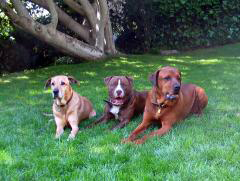
When you have a lightning-quick emergency Sit plus a rock-solid unbreakable Sit-Stay, you have a pretty well-trained dog that will have a better quality of life because people will welcome his integration into the social scene.
Proofing stays comprises increasing duration, distance, and distractions. Start by teaching short stays simply by delaying the food reward after a position change and counting out time in “good dogs” — “good dog one, good dog two, good dog three etc.” Alternate periods of instructive feedback — "Good Sit-Stay Rover" — with short periods of silent appreciation. With each successive trial, gradually decrease the amount of praise and increase the length of silence.
Most dogs will give you lots of warning that they are about to break the stay; first they look away, then they sniff away, and then they go away. So, if your dog looks away from you, or if he even looks like he is about to break a sit-stay, for example, simply re-instruct your dog, “Rover, Sit!” No need to shout, but do create a sense of urgency and quickly get your dog sitting again. Even though he has moved out of body position, do not give him time to move from the spot. Get him back sitting as quickly as possible and praise him as soon as he sits again. Only use your voice as an instructive reprimand. Never use your hands to re-position your dog, otherwise it will be a longtime before you have any distance control over your dog.
Always train with a stopwatch, so you have a good objective grasp of your dog’s reliability. Remember, to practice at least three types of stay — sit-stay, down-stay and stand-stay. Do not forget stand-stays. You will find that the more you practice stand-stays, the more rock-solid your dog’s sit- and down-stays. Practice standing toe-to-toe in front of your dog, until your dog comfortably performs a 30 second stand-stay, a one-minute sit-stay and a three-minute sown-stay.
Now it’s time to gradually and progressively increase distance. Take one step back and after just one second return to your dog and praise him. After every successful short proofing episode, always return to the toe-to-toe position and praise your dog to “capture” the stay. Then take two steps back and after two seconds return to your dog and praise. Then take three steps back and after three seconds return to your dog and praise. With each successive trial, gradually increase the distance. Should your dog look like he is about to break, immediately re-instruct him to “Sit.” This is why we taught distance position changes before teaching stays. Unless you have an arm like Inspector Gadget, verbal commands are the only way to immediately correct and reposition your dog at a distance.
Now it’s time to gradually and progressively increase distractions. Of course by increasing the distance and distractions in this fashion, the cumulative duration will increase dramatically. First we to get the dog used to silly and unexpected things that we do. Most dogs will break a stay if the owner simply gets down on the ground and rolls over. This is not good enough. We want the dog to reliably stay when around children and children spend a lot of time jumping, skipping, shouting and rolling on the floor. So, let’s gradually proof the dog to stay when we move slowly, quickly, when we jump, clap our hands, laugh, sing, and perform all sorts of silly walks and actions. Remember, after each incremental proofing episode, return to your dog and praise. After thirty minutes or so, your dog should be able to remain in a sit-stay while you kneel down, approach your dog on all fours, kiss him on his nose, rollover, waggle your arms and legs in the air, squeak, and then stand up to return to your dog and praise.
Now comes the fun part, you are going to praise your dog for staying, while other people try to get your dog to break. Check out Musical Chairs competition in the K9 GAMES.
Heel On-Leash
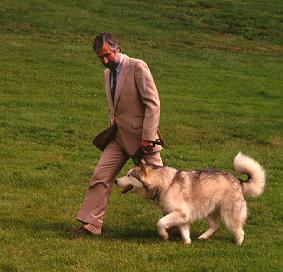
Teaching your dog to heel has been described in some detail in the Puppy Training chapter, Lure/Reward Training and so please go back and review that section. Here, we shall present some additional tips.
Use food or toys in your left hand to lure your dog to heel on your left side. Each time before stopping, use your right arm (across the front of your body) to signal your dog to sit by your left side.
Practice short sit-heel-sit sequences in a straight line, then practice turns in place — sit-turn-sit and eventually, turns in motion. Slow down your dog (move your left hand lure backwards) before turning left but speed up your dog (move your left hand lure forward) before turning right.
It is really important to teach your dog to slow down (Steady) and to speed up (Hustle) on command. Forging ahead and lagging behind are the two major problems when heeling and of course, each is the antidote for the other. By teaching your dog to slow down and speed up on command you can prevent a lot of tight-leash walking and leash-jerks.
To teach your dog to slow down. Walk at a fast or normal pace and 1. Say, “Steady” 2. Immediately and dramatically reduce your speed so that 3. Your dog slows down to accommodate to your change in pace, and 4. Praise your dog. After half a dozen or so repetitions, your dog will anticipate that you are about to slow down whenever he hears you say, “Steady” and so, your dog learns that Steady means slow down.
To teach your dog to speed up: Walk at a slow or normal pace and 1. Say, “Hustle” 2. Immediately and dramatically increase your speed so that 3. Your dog speeds up to accommodate, and 4. Praise your dog. After half a dozen or so repetitions, your dog will anticipate that you are about to speed up whenever he hears you say, “Hustle” and so, your dog learns that Hustle means speed up.
Practice by frequently and randomly changing gears between fast, normal and slow when walking your dog in a straight line on sidewalks. Once you have taught your dog Hustle and Steady, walking your dog on leash will be so much more enjoyable for you, and for your dog. Also, Hustle is the solution to slow recalls. Shouting at your dog will usually make him slow down. I mean, who wants to hurry to a person who’s shouting at them. But if you say, “Hustle” at least your dog now knows that you would like him to speed up.
Woof/Shush
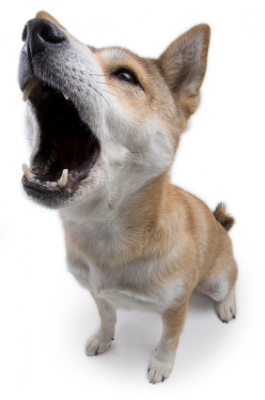
So many owners, or to be more precise, their neighbors, find excessive barking to be an intolerable problem when dogs are left at home alone. But also, many owners find excessive and uncontrollable barking to be a problem even when they are at home with their dogs. The solution is simple. Teach the dog to shush on cue. This may sound OK in theory but many owners experience huge problems trying to put theory into practice, largely because they try to teach the dog to shush when he is amped up and barking so loud that he cannot even hear the owner’s instructions. We have a better way.
First, let’s put the “problem” on cue and teach the dog to speak on command. Some may think this strange: “My dog barks so much, so why on earth would I teach him to bark more?” Well, if you have taught your dog to speak on command, you may now teach your dog to shush at times when your dog is not over-the-top with excitement and at times that are convenient to you.
Lure/Reward training always comprises the same four-step process:
1. Request 2. Lure 3. Response 4. Reward.
And so to teach your dog to speak on cue:
1. Say “Speak” 2. Lure your dog to speak, and 3. When the dog speaks, 4. Reward your dog. However, what shall se use for a lure? How about having an accomplice ring the doorbell? After six to eight repetitions of the training sequence, your dog will learn that “Speak” predicts that the door bell is about to ring and so, he will bark when you say “Speak” in anticipation of the doorbell.
Lure/Reward training is so quick and easy, we may as well teach the dog to shush at the same time. But again, what shall we use as a lure to shush the dog? Certainly, a food treat is the very best lure. A dog cannot sniff a food treat and bark at the same time. These are two mutually exclusive behaviors. Go on, try it yourself.
And so, the Woof/Shush training sequence becomes:
1. Say, “Speak”
2. Accomplice rings the doorbell or knocks on the front door
3. Dog barks at the doorbell
4. Praise your dog for barking, “Good boy! Good woofs!”
1. Say, “Shush!”
2. Waggle a piece of freeze-dried liver in front of your dog’s nose
3. Dog sniffs food and stops barking
4. Praise your dog, “Good Shush. GoooooodShush.” And then give your dog the treat.
Repeat the above woof/shush sequence a number of times and with each repetition, progressive increase the length of shush-time following each barking session by delaying giving the food treat. You may count out the length of the shush-time — “Good shush one. Gooood shush two. Goooood shush three… etc.”
Now practice on a walk, so that your dog learns to Speak and Shush in a variety of different settings.
Adopting an Adult Dog
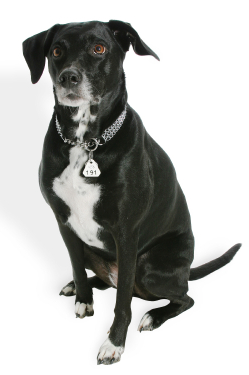
Adopting an adult dog can be a marvelous alternative to raising and training a puppy. Alternatively, a new adult dog can be a full-time project. Adult dogs can be perfect or problematic — carrying the behavioral benefits or baggage of their previous owners.
Take your time to search for the right dog for you and only choose one that you know your family knows how to train. Some shelter and rescue dogs are purebred, but most are one-of-a-kind mixed-breeds.
Some shelter dogs are well trained, well behaved, friendly, and simply in need of a caring human companion. Others may have a few behavior problems (housesoiling, chewing, barking, hyperactivity, etc.,) and require their puppy education in adulthood. Other dogs are shy and fearful and require a dedicated owner who is going to spend the time that it takes to rebuild the dog's confidence.
Raising and training a puppy requires a lot of time and know-how. The puppy's behavior is always changing, for better or for worse, depending on his socialization and training. However, an adult dog's behavior and temperament are already well established, for better or for worse. Traits and habits may change over time, but compared with the behavioral plasticity of young puppies, an older dog's habits are much more resistant to change. Whereas temperament problems may take longer to resolve in an adult dog, good habits are also just as hard to break. Thus the key to adopting a good shelter or rescue dog depends on selection, selection, selection! Take your time to test drive plenty of prospective candidates. The perfect dog is waiting for you somewhere. Be patient, search well, and be realistic about your choice, i.e., choose with your brain as well as your heart. When selecting an adult dog, you need to evaluate whether you like the dog, whether the dog likes you (and other people), and the dog's basic manners and household etiquette.
Mutual Affection
All family members must be involved in the selection process and agree 100% on the final choice. You must equally check that the dog likes all family members. Make sure that the dog eagerly approaches each family member and thoroughly enjoys being handled and stroked. Additionally, check that the dog likes other people. Observe the dog's behavior when he interacts with a wide variety of people, especially children, men, and strangers. The most important quality in a companion dog is friendliness: he should enjoy the company and attentions of people. If he is at all fearful or standoffish, you will need to devote time to teach him that people are non-threatening.
Test-Driving
Make sure that you get a good feel for your prospective dog before you take her home. First, check her general demeanor. Is her kennel soiled or clean? Does she play with chewtoys? Is she calm and quiet, or hyperactive and barking? Make sure all family members spend plenty of time "test-driving" the dog. Check to see that everyone can get the dog to pay attention, come when called, sit, lie down, and roll over. Take the dog for a spin around the block to evaluate how she walks on leash. Especially spend lots of time handling and petting (examining) and hugging (restraining) the dog. Check that she enjoys having her muzzle, ears, neck (and collar), paws, and rear end handled. If you find she has areas that are sensitive to touch, check to see how she responds to progressive desensitization exercises. There is little point in sharing your home with a dog that you (or others) cannot touch.
Your Dog's First Couple of Weeks at Home
An environmental change offers a wonderful opportunity for a dog to learn new household rules. First impressions are extremely important and leave an indelible impression. Regardless of your new dog's presumed housetraining and chewtoy-training status, teach her where to eliminate, what to chew, and how to settle down calmly and quietly during her first couple of weeks at home. In the beginning, your dog is likely to be somewhat stressed with all the recent changes in her life. She may be depressed, or she may react with exuberance (hyperactivity and barking) in her newfound home. She may become anxious (bark, chew, pee, and poop) when left alone.
It is incredibly important that your dog does not establish any bad habits during her first couple of weeks at home. Consider a short-term and long-term confinement program (see Puppy’s First Month: Home Alone), so that housetraining and chewtoy-training are errorless. For the time being, do not feed your dog from a food bowl. Instead, have family, friends and strangers handfeed most kibble as training lures and rewards for housetraining, classical conditioning, and teaching basic manners. Stuff the rest of her kibble into Kongs to teach her to settle down quietly, calmly, and confidently. Once your dog adapts to her new surroundings and human companions, she has a lifetime to enjoy full run of her new home.
Fearful Dogs
Many dogs are undersocialized and may become fearful in the shelter environment. You are a saint to rescue a fearful dog from the stress of a shelter environment, but you must realize that for fearful dogs, confidence-building can be an extremely lengthy and heart-rending procedure. You must have both the time and the know-how. The last two dogs that I adopted were fearful and aggressive toward men and strangers. Both dogs became friendly and confident but each one required a couple of years work to help them reach that goal. (For information on how to rehabilitate a fearful dog read Help For Your Fearful Dog by Nicole Wilde.) To learn more about training, read the Open Paw Four-Level Training Manual and Doctor Dunbar's Good Little Dog Book. To locate adolescent and adult dog training classes in your area, contact the Association of Pet Dog Trainers
A good place to search for the right dog for you is the Dogtime matchup.
Ch 6: Behavior Problems
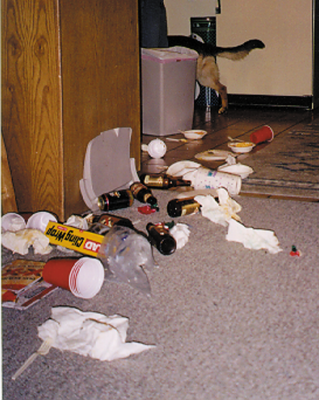
Why do dogs misbehave? Or, perhaps we should ask, do dogs misbehave? Certainly, dogs are dogs, and unless given appropriate guidance, puppies will grow up to behave like dogs. However, most behavior problems that irritate owners are, in fact, perfectly normal, natural and necessary canine behaviors. From a dog’s point of view, it is as normal to bark, chew, dig and urine-mark as it is to wag a tail or bury a bone. Moreover, just as it is a physiological necessity for dogs to urinate and defecate, it is a psychological necessity for dogs occasionally to bark, howl, chew, sniff, dig, run, jump, chase and play. Obviously, dogs have an inherent need, desire, drive, or motivation to act like dogs. So, the dog's behaviors per se are quite normal and utterly necessary, rather it is their manner of expression that is inappropriate. Well, here again, dogs might disagree. I am lucky to be fluent in several canine languages — including Labradorian, Malamutian and Yorkiese — and Labradors have convinced me that they consider it perfectly appropriate to jump-up, knock over folding chairs, pounce in mud puddles, and socialize with a fallen leaf, just as Malamutes and Yorkies have taught me that it is entirely acceptable and even expected to howl in the middle of the night and to pee on carpets (so as not to get one’s feet wet). So, dogs consider their behavior to be both appropriate and acceptable, rather it is owners who consider some dog behaviors to be inappropriate and unacceptable. Since people have invited dogs into their human homes, and since people (and not dogs) consider some dog behaviors to be inappropriate and unacceptable, then people should do their best to understand and respect dogs as dogs and to try and understand their point of view, yet to teach them how to express their natural dogginess in a manner that does not frustrate or offend their human housemates. It is unrealistic to expect all dogs to grow up automatically to behave like Lassie. (“Lassie” was in fact several highly trained dogs.) If owners understandably have rules and regulations as to how they would like their dog to behave, they should not keep these rules a secret from the dog. Otherwise, the poor dog will predictably break rules that he didn't even know existed and no doubt, be punished for these inevitable “transgressions.” Owners must teach dogs how to express their basic doggy nature in a manner that is both acceptable and appropriate within the domestic setting. The owner must at least meet the dog halfway and establish a mutually agreeable arrangement vis a vis the dog's conduct in urban, suburban and rural neighborhoods. Otherwise, the dog will be left to improvise in his endless quest for some kind of occupational therapy to pass the time of day and most likely, the owners will take considerable exception to the dog's selection of activities and entertainment. Specifically, owners should teach their dogs what to chew, where to eliminate, where to dig, when and for how long to bark, how to enjoy spending time at home alone, when to pull on leash, when and how to be hyperdog, and especially how to greet, socialize and play with other dogs and people.
Housesoiling
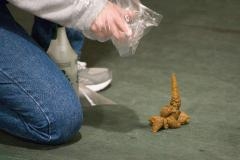
Housesoiling is a spatial problem. Your puppydog has been allowed to eliminate in the wrong place. Housesoiling quickly becomes a bad habit because dogs develop strong location, substrate, and olfactory preferences for their improvised indoor toilet areas. To housetrain your puppydog: first, prevent any more mistakes; and second, teach your puppydog where you would like him to eliminate.
Prevent Mistakes
Mistakes are a disaster since they set a bad precedent and create bad habits, which can be hard to break. Consequently, you must prevent mistakes at all cost. Whenever you are not at home, leave your dog in a long-term confinement area, such as a single room indoors with easy-to-clean floors (bathroom, kitchen, or utility room)—this will be your puppydog’s playroom.
Provide your dog with fresh water, a number of stuffed chewtoys for entertainment, a comfortable bed in one corner, and a doggy toilet in the corner diagonally opposite from his bed. Your dog will naturally want to eliminate as far as possible from his bed, and so will soon develop the good habit of using his toilet. And remember, good habits are just as hard to break as bad habits.
For a doggy toilet, use sheets of newspaper sprinkled with soil, or a litter box filled with a roll of turf, or a concrete paving slab. Thus your dog will develop olfactory and substrate preferences for eliminating on soil, grass, or concrete.
The purpose of long-term confinement is to confine your dog’s natural behaviors (including urinating and defecating) to an area that is protected (thus preventing any mistakes around the house when you are not there), and to help your dog quickly develop a strong preference for eliminating on soil, grass, or concrete.
Teach Your Dog to Eliminate in the Right Place
When you are at home, confine your dog to a short-term confinement area with a number of stuffed chewtoys for entertainment. A portable dog crate makes an ideal doggy den. Alternatively, keep your dog on a short leash fastened to an eye-hook in the base board near her bed, or attach the leash to your belt. This way your dog may settle down beside you while you read, work at the computer, or watch television.
Every hour on the hour, say "Let’s go pee and poop" (or some other appropriate toilet instruction), and hurry your dog (on leash) to her toilet (in your yard, or at curbside outside the front door of your house or apartment building). Stand still with your dog on leash and repeat the instruction to eliminate. Give your dog three minutes to empty herself.
When your dog eliminates, praise her enthusiastically and offer three freeze-dried liver treats. Most puppies will urinate within two minutes on each trip to a toilet area, and defecate within three minutes on every other trip. Once your dog realizes that she can cash in her urine and feces for tasty treats, she will want to eliminate in her toilet area. Soiling the house just does not have comparable fringe benefits. Moreover, after a dozen or so repetitions, you will have taught your dog to eliminate on command.
If your dog does not eliminate during the allotted three-minute toilet break, put her back inside her crate for another hour.
The purpose of short-term close confinement is to prevent any mistakes around the house when you are home (but cannot devote undivided attention to your dog) and to predict when your dog needs to eliminate. Temporarily (for no more than an hour at a time) confining a puppydog to a small space (e.g., a dog crate) inhibits elimination, since the dog does not want to soil her sleeping area. Consequently, your dog will want to go immediately upon release from confinement—especially since hurrying to the toilet area will jiggle her bladder and bowels. Since you choose when to release your dog, you may choose when your puppy eliminates, and since you can predict when your dog needs to eliminate, you may be there to show her where to go, to reward your dog for going, and to inspect and immediately clean up after your dog.
Never confine a puppy or an unhousetrained adult dog to a crate for longer than an hour. A dog confined too long will be forced to soil her crate, making her extremely difficult to housetrain.
Once your pup is old enough to go on walks, make sure she eliminates (in the yard, or in front of your house) before each walk. If your dog does not go within three minutes, put her back in her crate and try again an hour later. However, if your dog does go, praise and reward her as usual and then say “Let’s go for a walk.” With a no-feces/no-walk policy, you will soon have a very speedy defecator. Moreover, elimination close to home facilitates clean-up and disposal; you will not have to stroll the neighborhood weighed down with a bag of doggie doo.
If you require a more detailed description of housetraining, download BEFORE You Get Your Puppy. To housetrain your dog, you need a dog crate, a number of chewtoys, and some freeze-dried liver treats. All of these products are available from your local pet store.
Destructive Chewing
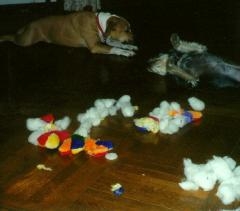
Chewing is essential for maintaining the health of your dog's teeth, jaws, and gums. Puppies especially have a strong need to chew to relieve the irritation and inflammation of teething. Dogs chew to relieve anxiety and boredom, as well as for entertainment. Your dog’s jaws are his tools for carrying objects and for investigating his surroundings. Essentially, a dog’s approach to all items in his environment is “Can I chew it?”
Chewing is Normal, Natural, and Necessary
Dogs generally sleep at night and in the middle of the day. However, chewing is your dog’s primary form of entertainment during his morning and late afternoon activity peaks. After all, there are only so many things your dog can do when left at home alone. He can hardly read a novel, telephone friends, or watch the soaps! Indeed, most chewing sprees stem from your dog's relentless quest for some form of occupational therapy to pass the time of day when left at home alone.
Chewing is a perfectly normal, natural, and necessary canine behavior. Prevention and treatment of destructive chewing focus on management and education—to prevent your dog from chewing inappropriate items and to redirect your dog's natural chewing-urge to appropriate, acceptable, and resilient chewtoys.
Prevent Destructive Chewing
When leaving home, confine your puppydog to a long-term confinement area, such as a single room—your puppydog’s playroom—with a comfortable bed, a bowl of water, a doggy toilet (if not yet housetrained), and nothing to chew but half a dozen freshly-stuffed chewtoys. Housetrained adult dogs may be confined (with their chewtoys) to a dog crate. When you return, instruct your dog to fetch his chewtoys so you can extricate the freeze-dried liver pieces and give them to your dog. Your dog will happily settle down and entertain himself with his chewtoys as soon as you leave in the morning, and he will be more inclined to search for chewtoys when he wakes up in anticipation of your afternoon return. This is important since most chewing activity occurs right after you leave home and right before you return.
When you are home, confine your puppy to her doggy den (crate) with nothing but a freshly-stuffed chewtoy for entertainment. Every hour on the hour (or at longer intervals with housetrained adult dogs), take your puppydog to her doggy toilet (see Housetraining blueprint), and if she goes, praise her and play some chewtoy games with her before putting her back in her crate with a freshly stuffed chewtoy.
The purpose of confinement is to prevent your dog from chewing inappropriate items around the house and to maximize the likelihood your dog will develop a chewtoy habit.
Redirect Chewing to Chewtoys
The confinement schedule described above optimizes self-training; your dog will train herself to chew chewtoys. In fact your dog will soon become a chewtoyaholic. With a good chewtoy habit, your puppy will no longer want to destroy carpets, curtains, couches, clothes, chair legs, computer disks, children's toys, or electrical cords. Your dog will be less likely to develop into a recreational barker. And also, your dog will happily settle down calmly and quietly and will no longer be bored or anxious when left alone.
You must also actively train your dog to want to chew chewtoys. Offer praise and maybe a freeze-dried liver treat every time you notice your dog chewing chewtoys. Do not take chewtoy chewing for granted. Let your dog know that you strongly approve of her newly acquired, appropriate, and acceptable hobby. Play chewtoy games with your dog, such as fetch, search, and tug-of-war.
Chewtoys should be indestructible and nonconsumable. Consumption of non-food items is decidedly dangerous for your dog's health. Also, destruction of chewtoys necessitates their regular replacement, which can be expensive. However, compared with the cost of reupholstering just one couch, $70 worth of chewtoys seems a pretty wise investment.
Kongs, Biscuit Balls, Squirrel Dudes, Busy Buddy Footballs, and sterilized long-bones are by far the best chewtoys. They are made of natural products, are hollow, and may be stuffed with food to entice your dog to chew them exclusively. To prevent your dog from porking out, ensure that you only stuff chewtoys with part of your dog's daily diet (kibble or raw food). Firmly squish a piece of freeze-dried liver in the small hole in the Kong, fill the rest of the cavity with moistened kibble, and then put the Kongs in the freezer. Voila, Kongsicles! As the kibble thaws, some falls out easily to reinforce your dog as soon as she shows interest. Other bits of kibble come out only after your dog has worried at the Kong for several minutes, thus reinforcing your dog's chewing over time. The liver is the best part. Your dog may smell the liver, see the liver, (and maybe even talk to the liver), but she cannot get it out. And so your dog will continue to gnaw contentedly at the Kong until she falls asleep.
Until your dog is fully chewtoy-trained, do not feed her from a bowl. Instead, feed all kibble, canned food, and raw diets from chewtoys, or handfeed meals as rewards when you notice your dog is chewing a chewtoy.
If you would like better insight into your dog’s chewing psyche, read Chapter 3, "It’s All Chew Toys to Them," in The Culture Clash by Jean Donaldson. If you require a more detailed description of chewtoy training, download BEFORE You Get Your Puppy. To chewtoy train your dog, you need a dog crate, a number of hollow chewtoys, and some freeze-dried liver treats. All of these products are available from your local pet store.
Excessive Barking
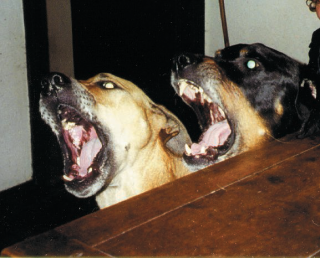
Some dogs get extremely worked up when visitors ring the doorbell, or when dogs walk by the house. Some spaniels and terriers bark at the drop of a hat. And our good friend Larry Labrador will bark whenever a leaf falls from a tree three blocks away. Barking is as characteristically doggy as wagging a tail or burying a bone. It would be inane and inhumane to try to stop your dog from barking altogether: "You’ll never bark in this town again!" After all, some barking is extremely useful. My dogs are much more efficient than the doorbell and much more convincing than a burglar alarm. The goal then, is to teach dogs normally to be calm and quiet but to sound the alarm when intruders enter your property. The barking problem may be resolved to our advantage by management and education: first, immediately reduce the frequency of barking before we all go insane; and second, teach your dog to "Woof" and "Shush" on cue.
Reduce the Frequency of Barks
Dogs bark the most right after their owners leave home for the day. The easiest way to immediately reduce woof-frequency is by exclusively feeding your dog from hollow chewtoys. Each evening weigh out and moisten your dog’s kibble or raw diet for the following day. Squish the gooey food into hollow chewtoys (Kong products and sterilized bones) and put them in the freezer overnight. In the morning, give your dog some frozen stuffed chewtoys. Your dog will spend well over an hour extricating his breakfast from the chewtoys. And if your dog is busying himself with chewtoys, he will be lying down quietly!
Do not leave an excessive barker outdoors. Yard-bound dogs are exposed to many more disturbances and their barks more easily penetrate the neighborhood. Leave your dog comfortably in a single room (away from the street) with a radio playing to mask outside disturbances. If you have been leaving your dog outside because he soils or destroys the house, housetrain and chewtoy train your dog so he may enjoy indoor comforts when you are away from home.
Teach "Woof" and "Shush" On Cue
It is easier to teach your dog to shush when he is calm and focused. Therefore, teaching your dog to "Woof" on cue is the first step in "Shush" training, thus enabling you to teach "Shush" at your convenience, and not at inconvenient times when the dog decides to bark. Moreover, teaching "Shush" is now much easier because your dog is not barking uncontrollably — barking was your idea!
Station an accomplice outside the front door. Say "Woof" (or "Speak," or "Alert"), which is the cue for your assistant to ring the bell. Praise your dog profusely when he barks (prompted by the doorbell); maybe even bark along with your dog. After a few good woofs, say "Shush" and then waggle a tasty food treat in front of his nose. Your dog will stop barking as soon as he sniffs the treat because it is impossible to sniff and woof simultaneously. Praise your dog as he sniffs quietly, and then offer the treat.
Repeat this routine a dozen or so times and your dog will learn to anticipate the doorbell ringing whenever you ask him to speak. Eventually your dog will bark after your request but before the doorbell rings, meaning that your dog has learned to bark on command. Similarly, your dog will learn to anticipate the likelihood of sniffables following your "Shush" request. You have then taught your dog both to speak and shush on cue.
Over repeated "Woof" and "Shush" trials, progressively increase the length of required shush-time before offering a food reward — at first just two seconds, then three, then five, eight, twelve, twenty, and so on. By alternating instructions to woof and shush, the dog is praised and rewarded for barking on request and for shushing on request.
Remember, always speak softly when instructing your dog to shush, and reinforce your dog's silence with whisper-praise. The more softly you speak, the more your dog will be inclined to pay attention and listen (and therefore, not bark).
Teach Your Dog When to Bark
Invite a dozen people for afternoon tea to teach your dog when, and when not, to bark. Instruct your visitors (some with dogs) to walk by the house a number of times before ringing the doorbell. When the first person walks by the house, it will take all of your attention to keep your dog shushed. But persevere: it will be easier when the same person walks by the second time, and again easier on the third pass by. Eventually your dog will habituate and will no longer alert to the same person's presence in the street. Profusely praise your dog and offer treats for silent vigilance. Repeat reinforcement for quiet vigilance several times on subsequent passes by. But when the visitor starts up the garden path, eagerly and urgently say "Speak! Speak! Speak!" Praise your dog when he woofs, and then instruct him to sit and shush at the front door while you welcome the visitor. If your dog exuberantly barks and bounces at this point, simply wait until he sits and shushes and then praise and offer a treat. Have the visitor leave and come back a number of times. Eventually, your dog will greet him by sitting in silence. This procedure becomes easier with each new visitor. Your dog soon learns to watch passersby in silence and to give voice when they step on your property, but to sit and shush when they are invited indoors—a trained neighborhood watchdog, which even non-dog-owning neighbors will welcome on the street where they live.
If you require a more detailed description, read Dr. Dunbar’s Good Little Dog Book. To teach your dog to be calmer and bark less, you will need numerous stuffable chewtoys. To teach your dog to "Woof" and "Shush" on cue, you need some freeze-dried liver treats. All of these products are available from your local pet store.
Digging
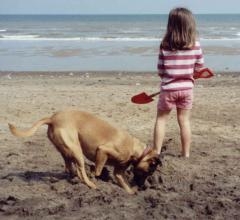
Dogs dig to bury bones, and later to dig them up again. Dogs dig cooling hollows in the summer, and warming pits in the winter. Dogs dig after eavesdropping on private ultrasonic conversations of subterranean critters. Bitches dig dens when they are pregnant. Dogs dig out of boredom, and dogs dig to escape. But by and large, most dogs dig for the sheer fun of it.
Dogs Don’t See Your Problem
Dogs consider digging to be a perfectly normal and natural doggy activity. In fact, terriers consider digging to be their very reason for being. It would therefore be fruitless to try to stop your dog from digging altogether. Prevention and treatment of misplaced digging focus on management and education: preventing your dog from digging in inappropriate areas and redirecting your dog's natural digging-desire to a suitable area.
Prevent Digging in Your Absence
When you are away from home, keep your dog indoors. When you are at home, try your best to accompany your dog outdoors to supervise and teach garden rules.
Housesoiling, destructive chewing, and hyperactivity are the most common reasons why dogs are relegated to unsupervised, solitary confinement in the yard, where they predictably learn to bark, dig, and escape, and become over-excited whenever let indoors. Consequently, it is important to housetrain and chewtoy-train your dog. (See Housetraining and Destructive Chewing) Teach your dog to settle down calmly and quietly indoors, and to sit when greeting visitors (see HyperDog!). Then your dog may remain safely indoors whether you are home or not. Your air-conditioned and centrally-heated house is the safest and most comfortable place for your dog to spend the day. When you are at home, go outside and enjoy your garden with your dog.
Some dogs dig to escape because they cannot bear the boredom and anxiety of solitary confinement in the yard. Escaping is exceedingly dangerous for your dog's health. So if you decide to leave your dog in the yard, make the yard more interesting and be sure to fix the fence. Also make sure your dog has a cool resting place in the summer and warmth in the winter. Teach your dog to dissipate digging energy with other activities. Make sure your dog is well exercised (psychologically as well as physically) and entertained, and thus has no need to dig to escape from the yard. Teach recreational diggers to become recreational chewers. If your dog is busying himself with a chewtoy, he has little time to dig. Consequently, chewtoys stuffed with breakfast kibble are the best objects to leave indoors, or to bury in your dog’s digging pit. You must teach your dog how to entertain himself outdoors. This means your dog needs chewtoys outside, too.
Redirect Digging to a Digging Pit
Since you consider your dog’s choice of digging locations to be inappropriate, choose a location to your liking and teach your dog to dig there. Build your dog a digging pit (much like a child’s sandbox) in a suitable corner of the yard.
Bury a cow's femur (the whole thing) in your dog's digging pit. Your little doggie will be utterly delighted when she finds a huge meaty bone. Now, this single simple procedure may not totally prevent holes in other areas of the garden, but your dog will now be much more inclined to dig in her digging pit. I mean, in 1849 everyone started rushing westwards to California. They didn't rush to New Jersey. And why did they rush to California? Because one person discovered a nugget of gold at Sutter's Mill. They didn't find gold in New Jersey, and so they didn’t rush to New Jersey. And so it is with dogs. After just one remarkable find, your dog will prefer to excavate in that California corner—her digging pit, where she once found something very worth finding.
Every morning, fill several chewtoys with your dog’s breakfast kibble and bury them in her digging pit. Your dog will discover that the digging pit is a virtual treasure trove where she can find toys for sustenance and entertainment.
Garden Rules
Once the dog's digging activities have been redirected to a suitable location in your yard, you might consider protecting other parts of the garden. Lay down chicken wire or chain-link fencing over the lawn and flower beds, add plenty of topsoil, and reseed.
Use boundary fences to partition the yard into doggy and non-doggy zones. The fences are not meant to be dog proof; rather, they are used as training aids to clearly demarcate lawn and garden boundaries to help you teach the rules. Always try to accompany your dog when he goes outside, especially during puppyhood or the first few months an older dog is at home. Remember, an owner in the yard is worth two in front of the television! It is not fair to keep garden rules a secret from your dog and then get angry with the dog for breaking rules he didn’t even know existed. Encourage and praise your dog for walking on paths and for lying down in dog zones. Tie a number of stuffed chewtoys to ground stakes or hang them from tree branches in dog zones to encourage your dog to want to spend time in those areas. Discourage your dog from entering non-doggy zones.
To teach your dog to use a digging pit, you will need numerous stuffable chewtoys and some freeze-dried liver treats. These products are available from your local pet store.
Photo of Cleo and friend enjoying some joint digging courtesy of Sue Harbon. Thanks Sue!
Separation Anxiety
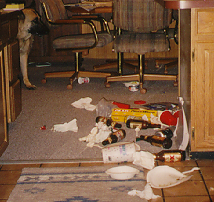
Your new puppydog needs lots of attention (companionship, education, and play), but also to be taught how to entertain himself appropriately and how to thoroughly enjoy his time when left at home alone. Otherwise, a social vacuum can be a very lonely place.
Puppies and dogs predictably develop housesoiling, chewing, digging, and barking problems if allowed too much freedom and too little supervision and guidance during their first few weeks at home. Puppies and newly adopted dogs may become overdependent if allowed unrestricted access to their owners during the initial time in their new home. Overdependent dogs often become anxious when left at home alone, and they attempt to adapt to the boredom and stress of solitary confinement by busying themselves with doggy activities—chewing, digging, barking—which soon become owner-absent behavior problems. What else is there to do? Severely stressed dogs may work themselves up into a frenzy and spend the day circling, pacing, and panting.
A Special Place
Dogs are den animals, and they value their own special place — a place for peaceful retreat, a methodical chew, or even a snooze. A doggy den (a collapsible and portable dog crate and dog bed) is an ideal training tool. Apart from its obvious uses for transporting dogs by car or plane, a crate may be used for short-term confinement when you cannot supervise your puppydog—to keep him out of mischief and prevent him from making housesoiling, destructive chewing, and digging mistakes. In addition, the crate may be used specifically to create good household habits: to housetrain your puppydog; to establish a hard-to-break chewtoy habit; to reduce excessive barking; to prevent inappropriate digging; and to foster confidence and calmness.
Right from the outset, when you are home, regularly confine your pup for "little quiet moments" in his dog crate in order to teach household manners and imbue confidence. Then your dog can look forward to enjoying a lifetime with the full run of your house, whether you are home or not.
Teach Your Puppydog to Enjoy His Doggy Den
A dog crate is really no different than a child's crib, playpen, or bedroom. The first item on the agenda is to teach your puppydog to thoroughly enjoy spending time in his doggy den. Stuff your puppy's first meal into a hollow chewtoy (see Chewing), tie the chewtoy inside the crate, and leave the door open so the pup may come and go as he pleases. Praise your puppy while he chews the chewtoy and supervise the puppy if he leaves the crate. Once the pup has settled down for a quiet chew, you may close the crate door. For your pup's second meal, put the stuffed chewtoys inside the crate and shut the door with the puppy on the outside. Once your puppy worries at the crate to get to his dinner, let the puppy enter his crate and close the door behind him. From now on, always give your puppy a stuffed chewtoy when confining him to his crate. Your pup will soon learn that confinement is for a short time—and an enjoyable time.
Teach Your Dog to Teach Herself
When at home, always confine your puppydog with a variety of hollow chewtoys stuffed with kibble and treats. Confining a dog to a crate with an attractive chewtoy is like confining a child to an empty room with a video game. This is called autoshaping. All you have to do is set up the situation, and your dog will automatically train herself. Each treat extricated from the chewtoy progressively reinforces chewing chewtoys and settling down calmly and quietly. Your dog will soon become hooked on her chewtoy-habit, leaving very little time for inappropriate chewing, digging, or barking. And if your puppydog is happily preoccupied chewing her chewtoy, she will fret less.
Housetraining
A dog crate may be used to predict when your puppy needs to relieve herself. Regular, but short-term (one hour or less) confinement inhibits your puppy from eliminating. This means that she will want to eliminate immediately when released each hour and taken to her toilet area, where she is handsomely rewarded with tasty training treats. However, never confine your unhousetrained puppy to her crate for longer than an hour, or when you are away from home; otherwise, the poor pup may be forced to soil her bedroom. As a temporary necessity until your puppy is housetrained, leave her in a special long-term confinement area. (See Housetraining)
Home-Alone Dogs Need An Occupation
Preparing dogs for inevitable periods of solitary confinement—and specifically teaching them how to occupy their time when left at home alone—is the most pressing humane consideration for any new puppydog in any household. Every dog requires some form of enjoyable occupational therapy. Vocational chewtoy chewing is the easiest and most enjoyable solution.
Dogs are crepuscular (most active at dawn and dusk), and so it is pretty easy to teach them how to calmly pass the time of day. During your puppydog's first few days and weeks at home, regularly confine him to a crate with stuffed chewtoys. Prepare the pup for your absence when you are present. When at home, it is possible to monitor your pup's behavior when confined for numerous short periods throughout the day. Your puppydog's first impressions of an established daily routine create an acceptable and enjoyable status quo for years to come. Remember, once your puppydog is confident, independent, and trained, he may enjoy free range of your house and garden for the rest of his life.
If you require a more detailed description, read AFTER You Get Your Puppy. To teach your dog to be calmer and bark less, you will need a dog crate, a number of hollow chewtoys, and some freeze-dried liver treats. All of these products are available from your local pet store.
To read this information in Ukrainian please click here. Thank you Sofya!
To read this information in Portuguese please click here. Thank you Artur!
Fearfulness
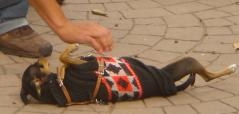
Socializing a puppy to people is the easiest and most enjoyable aspect of raising a dog. On a regular and ongoing basis, puppies need to meet, play with, and be handled and trained by a wide variety of people, especially including strangers, men, and children.
Narrow Window of Opportunity
Old dogs can indeed be taught new tricks. An adult dog may learn basic manners and good behavior (where to eliminate, what to chew, and when and for how long to bark) at any time in his life. However, socialization must occur during puppyhood—during the critical period of socialization, which ends when puppies are 12–13 weeks old. Shy and fearful dogs can be substantially rehabilitated, but they will never develop the confidence and social savvy of a well-socialized puppy. They will never become what they could have been.
Puppy socialization is critical for your puppy to develop the confidence and social savvy to continue socializing with people as an adult dog. Unless your puppy meets unfamiliar people every day, it will become fearful.
After eight weeks of age, puppies start to become shy and wary of unfamiliar people, and between five and eight months of age, they become fearful of strangers, especially men and children. Fearfulness and aggression worsen very quickly, because once a dog becomes fearful or aggressive, socialization stops. If your puppy becomes fearful, his life as a companion dog will be riddled with anxiety and stress and he will be useless as a working, competition, or protection dog.
If you notice any signs of shyness, standoffishness, or fearfulness in your puppy or adolescent dog, seek help immediately. Contact the Association of Pet Dog Trainers (1–800 PET DOGS or www.apdt.com to locate a Certified Pet Dog Trainer (CPDT) in your area.
Neonatal Handling
There is no better time to accustom puppies to enjoy being handled than when they are still neonates. The puppies cannot see or hear, but they can taste, smell, and feel. The puppies recognize and accept the handlers as strangers. What could be easier that inviting friends and family to gently hold, handle, and stroke neonatal puppies? Additionally, the ideal time to accustom puppies to sudden movements and loud, strange, and sudden noises is when the eyes and ears begin to open (between two and three weeks).
Socialization in the Puppy's Original Home
To fully enjoy life as a human companion, a puppy must be taught to thoroughly enjoy the company and actions of all people, especially strangers, men and children. It is not sufficient for puppies to meet the same small circle of familiar friends each day. Puppies need to meet unfamiliar people every day—especially men and children. Before they are eight weeks old—and the critical period of socialization is almost two-thirds over—puppies need to have been handled and trained by at least 100 different people. Puppy socialization and handling exercises are so simple, so important, and so much fun. Each person should use kibble to lure-reward each puppy to come, sit, lie down, and roll over. Then visitors can pick up, cradle, cuddle, and stroke the pups, while looking in their eyes and gently examining their jaws, paws, ears, belly, and private parts.
Remember to maintain routine hygiene: All people should leave outdoor shoes outdoors and wash their hands before handling puppies less than 12 weeks of age.
Socialization in the PuppyDog's New Home
By eight weeks of age socialized puppies will start to become shy and wary of unfamiliar people. Consequently, it is necessary to accelerate their socialization program. During his first month in his new home, a puppy needs to be handled and trained by an additional 100 different people—at least three strangers daily. Puppy handling is still so easy and enjoyable. (Please note: All these exercises will work with adult dogs, they just take much more time.)
Weigh out the puppy's dinner kibble and divide it into bags to give to each guest to handfeed to the puppy. Put a few treats into the men's bags and lots of treats into the children's bags. Each guest will train your puppy for you, using kibble and treats to lure-reward the puppy to come, sit, lie down, and roll over. Each person will also pick up and handfeed the pup, examining his mouth, ears, paws, and rear end, before passing the puppy to someone else. "Pass the puppy" is marvelous game and prepares the puppy for handling and examination by veterinarians and groomers. At the end of the evening, your puppy will love household guests and especially enjoy the company and actions of men and children.
Puppy Classes, Walks, and Parties
As soon as your puppy is old enough, enroll in a puppy class so your puppy may socialize with other dogs and people and fine-tune his bite inhibition. Without a doubt, walking your puppy is the very best socialization and confidence-building exercise. Stop every 25 yards and instruct your puppy to sit (for control), and occasionally to settle down (with a stuffed chewtoy) and watch the world go by. Handfeed dinner when anyone approaches—one piece of kibble for a woman, three pieces for a man, three pieces of freeze-dried liver for each child, and five pieces of liver for a boy on a bike or skateboard. You may allow passersby to handfeed your pup once you have shown them how to lure him to sit to say hello. Above all, don't keep your puppy a secret. Continue to have regular puppy parties at home and invite family, friends, and especially neighbors to meet your puppy. Instruct each person to bring a friend. When you socialize a puppy properly, you will find your own social life improves dramatically.
For a more detailed socialization agenda, read AFTER You Get Your Puppy by Ian Dunbar and Help For Your Fearful Dog by Nicole Wilde.
To locate puppy socialization classes in your area, contact the Association of Pet Dog Trainers.
Fighting
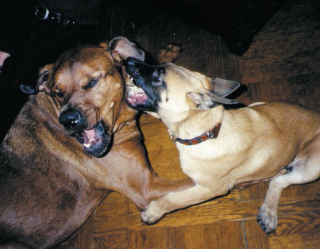
Many people have unrealistic expectations about dog-dog social behavior. Dogs are expected to behave perfectly and get along with all other dogs, even though people have difficulty being universally accepting and friendly. However, although people may often disagree, argue, and sometimes resort to pushing and shoving, very few people inflict severe injuries. When tempers flare, extreme physical aggression is strongly inhibited. Really, dogs are not that much different.
Most dogs have frequent disagreements and arguments, and on occasions resort to scrapping noisily, but only extremely rarely does one dog severely harm another. Whereas it is unrealistic to expect dogs never to squabble, it is perfectly realistic to raise and train dogs to never hurt each other when fighting.
To teach canine social savvy: first, socialize your puppy to be friendly, so that he would rather play than fight; second, prevent predictable adolescent de-socialization, but most important; third, teach your puppy bite inhibition, so that if he does scrap as an adult dog, he causes no harm.
Socialization
Socializing a young puppy is as easy as it is enjoyable. Enroll in an off-leash puppy class, visit different dog parks on a regular basis, and walk your puppy at least once a day. To socialize your puppy, he must meet unfamiliar dogs on a regular basis.
Prevent Developmental Desocialization
Adolescence is a particularly stressful time for young dogs, especially males, who are repeatedly harassed by older dogs, especially males. The ritualized harassment is both normal and necessary, allowing older dogs to put developing youngsters "in their place" before they are strong enough to compete on the social scene. Harassment is triggered by rude adolescent behavior and by extremely elevated testosterone levels in five- to eighteen-month-old adolescents. Castrating your puppy will prevent most harassment from older dogs.
Additionally, to maintain self-confidence and offset the stress of adult-doggy discipline, an adolescent dog requires many positive social interactions. Regular play sessions and repeated friendly encounters are vital. However, for many dogs, socialization with other dogs is abruptly curtailed at between six to eight months, usually following the first couple of scraps. This is especially true for small dogs and large dogs. Worrying that a little dog may get hurt, the owner is more likely to pick him up and less likely to let him play. Similarly, worrying a large dog might hurt other dogs, the owner now tends to keep her restrained on a tight leash. Thus, at a crucial developmental stage, many dogs are seldom allowed to interact with unfamiliar dogs. A vicious circle develops—the dog desocializes and his bite inhibition begins to drift, whereupon fights and potential damage now become more likely, making it even more difficult to socialize the dog.
To prevent your puppy from becoming asocial or antisocial during adolescence, he must continue to meet unfamiliar dogs on a regular basis. Always praise your puppy for meeting, greeting, and playing with unfamiliar dogs. Never take friendly behavior for granted. Always let your dog know that you are very happy when he is friendly. Throughout adolescence and adulthood, praise and reward your dog with food treats after every friendly encounter with another dog.
Bite Inhibition
Most dogs, especially males, are involved in a number of scraps during adolescence. If the dogs acquired good bite inhibition during puppyhood and learned how to resolve differences without causing harm, there is little, if any, damage. However, if the dogs did not learn bite inhibition as puppies, there may be substantial damage.
Dog fights are noisy and scary, and many owners insist: "He fights all the time and is trying to kill the other dogs!" It is essential to objectively assess which dogs are dangerous and which are not. Calculate the dog's fight/bite ratio by asking, "How many times has the dog fought?" and "How many fights warranted veterinary treatment for severe bites?" The observation (that the dog fights a lot of the time) and the assumption (that the dog is trying to kill other dogs) are quite contradictory. If the dog is trying to kill other dogs, then obviously he is not that good at it, since he has had numerous attempts and failed on every occasion. On the contrary, a large number of fights and the absence of injury, offers proof the dog is definitely not trying to kill other dogs. (If one dog were truly trying to harm another dog, the physical damage from a single incident would be extreme.) Certainly he is undersocialized but he has marvelous bite inhibition.
"Growl classes" provide an effective solution for scrappy dogs that have never harmed another dog. Owners can safely practice controlling their dogs in a controlled setting, and dogs may gradually rebuild their confidence so that eventually they may resume socialization and play.
For dogs that harm other dogs, common-sense and precautionary management are the only options. The dog should be kept on-leash and muzzled whenever on public property. Allowing a dog that harms other puppies and dogs the opportunity to interact with other dogs would be unfair, irresponsible, and potentially dangerous.
Bite inhibition is the key. The issue is not really whether dogs fight, but whether or not one dog harms another. Puppies that had ample opportunities to socialize, play-fight, and play-bite with other puppies usually develop good bite-inhibition. They learned how to inhibit the power of their jaws and consequently may resolve adulthood differences without causing harm. Bite inhibition can only safely be established during puppyhood. Giving your puppy the opportunity to develop good bite inhibition is the most important reason for enrolling in puppy class.
To learn more, read AFTER You Get Your Puppy and watch the Canine Aggression: Fighting DVD. To locate puppy classes and "growl classes" in your area, contact the Association of Pet Dog Trainers
HyperDog!
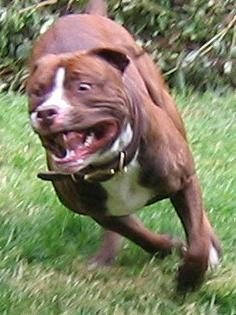
Puppies are naturally noisy and hyperactive. Puppies are exuberant when greeting, playing, and when expressing friendliness and appeasement. However, adult dogs are noisy and hyperactive because they are untrained and have unintentionally been encouraged to act that way. For example, eagerly jumping puppies are petted by people, who later get angry when the dog jumps up as an adult. The dog's only crime? It grew!
Sadly, adult dogs receive considerable abuse for expressing their enthusiasm and exuberance. For example, "The Trainers from the Dark Side" recommend teaching a dog not to jump up by shouting at the dog; squirting him in the face with water or lemon juice; swatting him on the nose with a rolled-up newspaper; yanking on the dog's leash; hanging the dog by his choke-collar; squeezing the dog's front paws; treading on his hind paws; kneeing the dog in the chest; or flipping the dog over backwards. Surely these methods are a bit cruel for a dog that's just trying to say hello. Indeed, in the words of Confucius, "There is no need to use an axe to remove a fly from the forehead of a friend." Why not just teach dogs to sit when greeting people?
Be smart. Be kind. Teach your puppy (or adult dog) to settle down and shush when requested and how to greet people in a mannerly fashion. Both dog noise and exuberance may be controlled and channeled into appropriate outlets.
Sit and Settle Down
Lure-reward train your puppy or dog to come, sit, and lie down. Simple instructions such as "Sit" and "Lie down" are extremely effective solutions for nearly all doggy activity problems. Rather than telling the pup "No, no, no!" and "NO!" for everything she does that annoys you, simply ask her to lie down, and then praise and reward her for doing so. If she lies down obediently, she cannot run around the living room, chase her tail, chase the cat, hump the cat, jump on the furniture, jump up and down in the car, run out the front door, or chase and jump on children. Lying down and most behavior problems are mutually exclusive; your dog cannot lie down and misbehave at the same time. Take the initiative and direct your puppy's behavior by teaching her to lie down on request.
Rather than feeding your puppy from a bowl, weigh out his kibble in the morning and use individual pieces as lures and rewards during oodles of five-second training interludes throughout the day. Practice in every room of the house, in the car (while stationary), and on walks. Pause every 25 yards and instruct your puppy to perform a series of body positions: for example, sit-down-sit-stand-down-stand. Within just a couple of days you'll have a totally different dog.
Simple reward training methods work wonders with out-of-control adolescent and adult dogs. Hold a piece of kibble in your hand but don't give it to your dog. Stand perfectly still and give no instructions; simply watch to see what your dog does. Characteristically, the dog will run through his entire behavior repertoire. Your dog will wiggle, waggle, circle, twirl, jump-up, lick, paw, back-up, and bark...but eventually he will sit or lie down. Praise him and offer the piece of kibble as soon as he sits (or lies down—your choice). Then take a gigantic step (to reactivate Rover), and stand still with another piece of kibble in your hand. Repeat the above sequence until Rover sits immediately after you take each step and then begin to progressively increase the delay before offering the kibble. Maybe count out the seconds in "good dogs"—"Good dog one, good dog two, good dog three, etc." If Rover breaks his sit while you are counting, simple turn your back on him, take a three-second timeout, and repeat the sequence again. In no time at all you will be able to count out 20 "good dogs" as Rover sits and stays calmly, looking up at you expectantly.
Move from room to room repeating this exercise. When walking Rover, stand still every 25 yards and wait for him to sit, then praise him and continue the walk. After handfeeding your dog just one meal in this fashion indoors and on one long walk with sits every 25-yards, you'll have a calmer and much more attentive dog.
Jumping Up
Jumping up deserves a special mention because it is the cause of so much frustration and abuse. Right from the outset, teach your puppy to sit when greeting people. Sitting is the obvious theoretical solution because a dog cannot sit and jump up at the same time. However, it may initially be difficult to teach your dog to sit when greeting people because he is so excited that he doesn't hear what you say. Consequently, you will need to troubleshoot his training.
First practice sits (as described above) in locations where your dog normally greets people, e.g., on-leash outdoors, and especially indoors by the front door. Then invite over ten friends for a dog training party. Today your dog's dinner will be handfed by guests at the front door and by friends on a walk. After eventually getting your dog to sit to greet the first guest, praise your dog and have the guest offer a piece of kibble. Then ask the guest to leave and ring the doorbell again. In fact, repeat front-door greetings until your dog greets the first guest in a mannerly fashion three times in a row. Then repeat the process with the other nine guests. In one training party you will probably practice over a hundred front-door greetings. Then ask your all your guests to leave one at a time and walk round the block. Put your dog on leash and walk around the block in the opposite direction. As you approach each person, instruct your dog to sit. Praise him when he does so and have the person offer a couple of pieces of kibble. After five laps, you will have practiced 50 sidewalk greetings. Now your dog will be ready to sit to greet bona fide guests at home and strangers on the street.
Put Doggy Enthusiasm and Activity on Cue
To be fair to your dog, make sure that she has ample opportunity to let off steam in an acceptable fashion. Sign up for flyball and agility classes. Play fetch with tennis balls and Frisbees and do yo-yo recalls (back and forth between two people) in the park. Formalize "crazy time"—train your dog to jump for bubbles, or play "tag" and chase your dog around the house. And maybe train your dog that it is acceptable to jump up on cue—to give you a welcome-home hug.
To learn more, read Doctor Dunbar's Good Little Dog Book. To locate puppy, adolescent, flyball, and agility classes in your area, contact the Association of Pet Dog Trainers at www.apdt.com .
Pulling on Leash
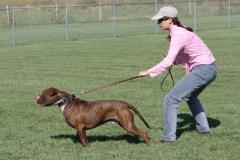
By and large, leash-pulling masks the real problem: without a leash you would probably be without a dog. It is indeed a sobering thought to think that most dogs prefer to forge ahead to sniff the grass or other dogs' rear ends than to walk by their owner's side. There are some dogs who simply don't want to walk beside owners who keeping yanking the leash. However, regardless of why your dog pulls, all dogs need to be trained to walk nicely on leash. If not, they are unlikely to be walked at all. Trying to teach a dog to heel using leash prompts and corrections requires a lot of skill and time. And even then, all you have is a well-behaved dog on-leash. Let him off-leash and he's history; you cannot safely take him for off-leash rambles, and you still cannot control him around the house, where he is off-leash all the time.
Luckily, there are more effective and enjoyable ways to get the job done. First, teach your dog to follow off-leash. Second. incorporate many sits and stays for control and attention. Third, teach your dog to heel off-leash and on-leash. After following these steps, you will find it is easier to teach your dog to walk calmly on-leash.
Teach Your Dog to Follow Off-Leash
Your dog's desire to follow and remain close is the necessary foundation for walking politely on-leash. You must become the center of your dog's universe. You need to stimulate and strengthen your dog's gravitational attraction towards you by moving away enticingly and heartily praising your dog all the time he follows. Click your fingers, slap your thigh, or waggle a food treat or a toy in your hand to lure the dog to follow. Proceed with a happy heart and a sunny disposition: talk to your dog, tell him stories, whistle, walk with a jaunty step, or even skip and sing.
Do not accommodate your dog's improvisations; you are the leader, not the dog. Whenever your dog attempts to lead, accentuate his "mistake" by doing the opposite. Stretch the psychic bungee cord: if your dog forges ahead, slow down or smartly turn about; if your dog lags behind, speed up; if your dog goes right, turn left; and if your dog goes left, turn right. Practice in large areas, such as in your backyard, friends' yards, tennis courts, dog parks, and safe off-leash areas. Feed your dog his dinner kibble, piece by piece as you walk. Once your dog is following closer, time yourself while practicing following-courses at home, going around furniture, from room to room, and from the house to yard.
Sits, Downs, and Stays
Enticing your dog to follow off-leash takes a lot of concentration and it is easy to let your dog drift. Consequently, instruct your dog to sit or lie down and then stay every ten yards or so. Frequent sits, downs, and stays teach your dog to calm down and focus. They also give you the opportunity to catch your breath, relax your brain, and to objectively assess your dog's level of attention. Sitting is absolute: either your dog is sitting or not. Only have the dog sit or lie down for a couple of seconds (just to check that he is paying attention) and then walk on again. Occasionally ask your dog to lie down for a minute or so to watch the world go by. You will find that the more down stays that you integrate into the walk, the closer, calmer, and more controlled your dog will be when following you.
Teach Your Dog to Heel Off-Leash & On-Leash
Instruct your dog to sit, and then lure him to sit using a food or toy lure in your right hand. Transfer the lure to your left hand, say "Heel," waggle the lure in front of your dog's nose, and quickly walk forwards for a few steps. Then say "Sit," transfer the lure to your right hand to lure your dog to sit, and maybe offer the kibble as a reward if your dog sits quickly and stylishly. Repeat this sequence over and over. Practice indoors and in your yard, where there are fewer distractions, before practicing in the dog park and off-leash walking areas. Then just attach the dog's leash and you will find he heels nicely on-leash.
Walking On-Leash
Teach your dog not to pull while you are both standing still. Hold the leash firmly with both hands and refuse to budge until your dog slackens the leash. Not a single step! It doesn't matter how long it takes. Just hold on tight and ignore every leash-lunge. Eventually your dog will stop pulling and sit. As soon as he sits, say "Good dog," offer a food treat, and then take just one large step forward and stand still again. Hold on tight; your dog will likely explode to the end of the leash, thereby illustrating the reinforcing nature of allowing your dog to pull for just a single step. Wait for your dog to stop pulling again (it will not take as long this time). Repeat this sequence until your dog walks calmly forward (because he knows you are only going one step) and sits quickly when you stop and stand still. Your dog quickly learns he has the power to make you stop and to make you go. If he tightens the leash, you stop. But if he slackens the leash and sits, you take a step. After a series of single steps and standstills without pulling, try taking two steps at a time. Then go for three steps, then five, eight, twelve, and so on. Now you will find your dog will walk attentively on a loose leash and sit automatically whenever you stop. And the only words you have said are "Good dog." Alternate heeling and walking on-leash. For most of the walk, let your dog range and sniff on a loose leash, but every 25 yards or so, have your dog sit, heel, and sit, and then walk on again. Always sit-heel-sit your dog when crossing a street: sit before crossing, heeling across, and then sitting on the other side of the street.
To learn more, read the Open Paw Four-Level Training Manual and Doctor Dunbar's Good Little Dog Book and watch the Training The Companion Dog DVD series.
Ch 7: Dog Behavior
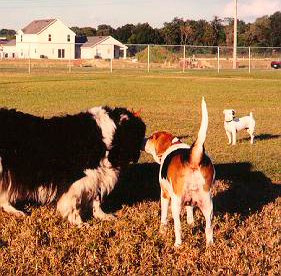
Dog behavior is a hugely fascinating yet widely misunderstood topic. All too often, normal play behavior and communication is misinterpreted as aggression and all too often, a myopic “understanding” of dog social behavior is used as an excuse for people to use aggression when training dogs.
The whole macho-dominance-alpha fallacy is just too much. If the alpha fallacy and its unwarranted and utterly misguided extrapolation to dog training were not so serious (and painful and potentially dangerous), the mere “concept” would be laughable. I hardly think that dogs meet secretly in late-night coffee bars to plot the overthrow and demise of their human families. To completely misunderstand the complexities of dog social structure and hierarchical interaction, to cite these misinterpretations as proof of the dog’s supposed desire for world domination, and then to use such flagrantly flawed “logic” as an excuse to make a dog’s education (training) a living hell is simply unthinking and unfeeling — both dumb and cruel.
Certainly, it is essential that we have household rules for dogs and that we take the time to adequately teach dogs our household rules and regulations, rather than punishing them for breaking rules that they never knew existed. And certainly, it is essential that we can modify and reliably control our dog’s behavior and actions at home and especially, when the dog is on public property. But surely we can accomplish this using brain instead of brawn… Yes, we should strive to use our supposedly superior human brains to teach our dogs, not only to act the way we want but also, to want to act the way we want. The secret to successful pet dog training is to respect, understand and engage dogs as dogs and to motivate them to be happily and willingly compliant, rather than coercing and forcing them to comply out of fear of mental anguish and physical pain. Indeed, in the world of pet dog training, wherein a large proportion of the trainers are children, happy and willing compliance is the only way.
Additionally, we should learn how to better understand and objectively interpret dog communication and dog play behavior to be able to ensure that our dogs are happy are neither stressed nor anxious, and that the behavior is normal and not potentially dangerous.
By observing repetitive play-signals, such as pawing, paw raising, play bows, or rhythmic or sudden staccato movements, it is possible to interpret the growls and yowls, snarls and snaps, and barks and bites as play rather than fear or aggression. Via preference testing — grabbing a playmates collar to see if the other puppy resumes or avoids continued interaction — it is possible to discern whether a puppy is being bullied, or having a darn good time. When dogs fight, we may objectively determine whether they are simply having a doggy disagreement (no injury is inflicted on either dog), or whether the behavior is dangerous (one dog is injured because the other has no bite inhibition).
The Alpha Fallacy
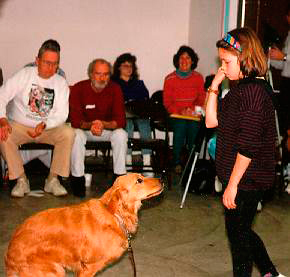
The Alpha Fallacy It is popularly held that rank is established and maintained by physical strength and dominance and that the more dominant (i.e., higher ranking) dogs are more aggressive. Hence, dogs that frequently threaten, growl, fight and bite are often assumed to be “alpha” animals. Not so Joe! The above assumptions are quite awry. Not only do they betray a theoretically simplistic view of a most sophisticated social structure but also, such notions tend to be counterproductive, inhumane and dangerous when cavalierly extrapolated to dog training, or the treatment of behavior problems.
In reality, a growly, macho topdog is a rare find. Topdogs seldom growl — they don’t need to. A true topdog is usually a pretty cool customer, who is secure and confident of his (or her) privileged position and has no need to fluster and bluster to bolster up his rank. Moreover a true topdog is more likely to share a toy, a bone, or a sleeping place, than fight over one. On the other hand, bottom-ranking dogs rarely growl either. The prime directive of a low ranking individual is to maintain a low profile. Barking, growling and snarling only draw unwanted attention and if it came to a fight, the underdog would most certainly lose.
A topdog has little need to threaten and an underdog would be crazy to. Without a doubt excessive growling and repeated fighting are indicative of an underlying insecurity and uncertainty about social rank vis a vis other dogs. Protracted, blustery displays of aggressiveness are the hallmark of middle-ranking males.
Subordinance Hierarchy When the framework of a successful hierarchy is viewed in a developmental context, it becomes apparent that subordinance hierarchy is a more descriptive term for canine social structure. Maintenance of an existing hierarchy depends on underlings advertising their respect for higher-ranking individuals. The status quo is maintained because, lower-ranking individuals seldom challenge authority and so only occasionally, is there need to enforce higher rank with a display of physical, or more likely psychological, dominance.
Growing up around larger pups, adolescents and adult dogs, puppies simply cannot compete on the social scene in view of their smaller size and inferior physical and psychological strength. Thus, puppies learn their station in life well before they become sufficiently large and strong to be a threat to the established order. Most adult dogs are quite lenient with young pups until they approach adolescence, whereupon adults (males especially) relentlessly pursue, stand-over and growl at the adolescents (males especially). Even so, harassment by adult dogs is largely psychological, rather than physical. It would be a perversely undersocialized adult dog, which physically beats up young puppies.
Nonetheless, during the crucial puppy/adolescent stage of hierarchical development, youngsters are perpetually intimidated and harassed by adults and understandably learn to respond with exaggerated appeasement gestures to assuage the torment from their elders. Moreover, young adolescents quickly learn that bother from older dogs may be largely prevented by taking the initiative and demonstrating active appeasement before they are harassed. The pups' preemptive apology characteristically comprises: a low slung, wriggly approach with ears back, submissive grin and with tail and hindquarters awag. The youngster may paw the brisket and lick the muzzle of the older dog. The infantile pawing and muzzle-licking food-soliciting behaviors of puppyhood now acquire new meaning and are retained as neotenic appeasement gestures in adolescence and adulthood. In addition, the underdog may rollover and lift a leg to expose his inguinal region. And some may submissively urinate. Adult dogs may determine the age of a puppy/adolescent from the smell of the youngster's urine.
From this stage on, higher-ranking dogs need only chastise those individuals that do not voluntarily show deference and respect in their presence. Fighting and physical dominance rarely come into play during the maintenance of hierarchical harmony. On the contrary, the major function of hierarchical structure is to lessen the amount of fighting. Once established, the hierarchy provides most of the solutions before problems arise. For example, when there are two dogs but only one bone, the ownership of the bone is pre-decided and therefore, there is nothing to fight about.
As a role model, we should always bear in mind the geriatric Yorkie, who habitually lords it over the two-year-old Great Dane. Any attempts in physical domination would no doubt end in one gulp. Instead the Yorkie patiently and gently, yet confidently and firmly trained the Great Dane by defining and setting limits for appropriate behavior. The Yorkie had the forethought and common sense to take the time to train the Great Dane at the right time — when he was still a puppy. Perhaps we should learn from this and do the same with pet dogs. Indeed, using brain over brawn to educate young puppies is the only safe, expedient and efficacious means for children to gain respect from adult dogs. Mental control is the key to success.
To read this information in Russian please click here
Dog Play
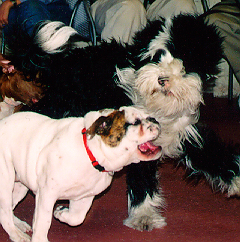
Dog Play Puppies and play are virtually synonymous. The very thought of a group of young puppies conjures up a picture of virtually non-stop, fun-loving, boisterous and bumbling play sessions. In fact young pups spend over 90% of their waking hours playing. But aside from the fun-factor, puppy play is also serious business. Play has many important functions. Puppies spend most of their play sessions practicing all-important hunting, fighting and survival skills. At four- to five-weeks-of-age, puppy play is characterized by puppies bumbling around, bumping into each other with frequent and amusing, bungled ambush attempts. But by eight weeks, most pups have become good little hunter-fighters and are quite adept and stalking, chasing and pouncing on their littermates.
In addition to perfecting all the ingredients of an adult dog’s social and sexual behavioral repertoire, play affords puppies the opportunity to learn the relevance and appropriateness of each individual behavior. The choreography of early puppy play behavior is often hilariously inappropriate and utterly unacceptable socially. A young pup will playfully chase down and bite a littermate, only for the surprise attack to gently dissolve into ribald mounting sequence. Most young pups appear to adhere to the Puppy Prime Directive: if it moves, attack and/or mount at will. Soon they learn that animate objects are more fun to hunt and mount and that inanimate objects are best reserved for destruction. Thereafter, the puppy learns to further restrict his hunt and mount activities to animals that are in the mood. The puppy learns not to bother grumpy old adult dogs, not to bother people, not to bother the cat, etc. Eventually, the puppy learns to restrict his playful advances to like-minded individuals. And eventually he learns the relative social appropriateness of fighting versus mounting.
Invariably, puppies go “over the top” as they get worked up during the course of play-fighting, Many sessions are temporarily terminated with short time-outs, usually following a short spat or disagreement. How to recover quickly, or bounce back, from a disagreement and resume playing is one of the most important skills pups have to learn before they can confidently enjoy the world of big dogs. Puppies learn that play has many rules, that breaking rules has unpleasant consequences, but that the unpleasant consequences are not necessarily the end of the world. All the puppy has to do is apologize, resume playing once more, and not break the rules in the future. Play tutors young puppies in social savvy, enabling them to develop the requisite know how and confidence to become a player in the exquisitely complicated and sophisticated social scene of adult dogs.
From the viewpoint of raising domestic puppies, bite inhibition is the single most important lesson learnt from play. With their penchant for biting and their needle-sharp teeth, many owners consider puppies to be on par with seek and destroy missiles. It would be disastrous for this type of behavior to continue into adulthood. Paradoxically though, it is the puppies’ biting behavior which ensures that adult dogs develop soft mouths.
Puppies are veritable biting machines and their bites hurt. And indeed they should! Sharp teeth enable puppies to inflict pain with their weak jaws, so puppies have adequate opportunity to learn that biting hurts. Puppies chew and bite everything. The first thing they learn is the difference between inanimate objects and sentient beings (people and other animals) that feel and react to the bites. The negative feedback from the bitee (cessation of play) prompts puppies to tone down both the force and the frequency of their biting behavior. It is essential puppies learn this before they develop the strong jaws of adults.
It is a rare dog (as it is a rare person) that never squabbles or fights. However, just as people can resolve disagreements without resorting to physical violence and inflicting bodily harm, dogs can do likewise. Squabbling and fighting are quite normal for dogs. Causing harm to other dogs is not normal. Whether or not a dog harms humans or his own kind depends almost entirely on the level of bite inhibition he developed during puppyhood and adolescent play sessions.
Play sessions in puppy classes offer a wonderfully precise diagnostic tool for assessing the success of each puppy’s ongoing socialization and its developing temperament. It is easy to determine the level of confidence in each puppy — to spot aggressive and fearful pups, bullies and wimps and to recommend immediate remedial socialization.
As a word of caution, if a puppy’s socialization program is restricted to only one night a week at puppy class (heaven forbid!), the puppy is highly likely to develop into a rambunctious bully, or a cowering wimp. The level of energy within a group of playful puppies creates a chain reaction that quickly approaches critical mass. The play becomes excessively fast and physical. Those puppies entering into the fray are inadvertently trained as play-maniacs, which become extremely difficult to control around other dogs. Also, the sheer level of becomes too much for some of the more sensitive and smaller puppies in class, which quickly start to de-socialize. Play should not destroy obedience and it should not ruin temperament.
The hard and fast rule for puppy play sessions is that they should be temporarily interrupted every 15 seconds or so. At the very least, owners should take each puppy by the collar and wait for him to sit and acknowledge his owner’s presence before offering a food treat and allowing play to resume once more. In this fashion, the instruction “Go Play” rewards the puppy for sitting calmly and paying attention to his owner. Thus, rather than becoming a distraction to training, play is the best reward in training. In fact, play-training is the way to go.
Certainly, puppy classes are a fun night out for puppies and owners to socialize and have a good time. And certainly, the dynamic chain reaction of puppy play sessions is ideal to therapeutically re-vamp the pup’s dog-dog socialization program, which has temporarily been on hold over the past few weeks (while the puppy was confined indoors). But even so, puppy classes should not be considered an entire socialization curriculum. In order to become and remain fully socialized, puppies, adolescents and adult dogs must continue to meet and play with unfamiliar dogs of different ages. There is no socialization exercise that surpasses a good old dog walk to play in a local dog park.
Dog Communication
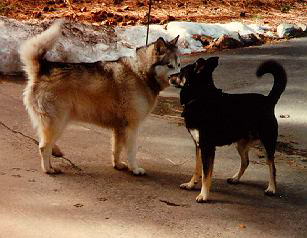
“In man, social intercourse has centered mainly on the process of absorbing fluid into the organism, but in the domestic dog and to a lesser extent among all wild canine species, the act charged with most social significance is the excretion of fluid. For man the pub, the estaminet, the Biergarten, but for the dog the tree trunk, the lintel of door or gate, and above all the lamppost, form the focal points of community life. For a man, the flavors of alcoholic drinks, but for a dog the infinitely variegated smells of urine are the most potent stimuli for the gregarious impulse.”
From The Lamppost, A Study of the Social Life of the Domestic Dog by Sirius (quoted in Sirius by Olaf Stapledon)
Humans communicate largely by the spoken and written word. (Hence this book.) Dogs, however, employ several different “languages”
Body language — comprising a broad repertoire of facial expressions and body postures such as, play bows, butt-swings, submissive grins, pilo-erection, ear dips and tail wags
Vocal communication — via a wide variety of barks plus all sorts of whimpers, whines, howls and growls
Olfactory communication — by investigating muzzles, ear glands, tail glands, vaginal and anal sac secretions and particularly, from sniffing urine and fecal deposits of other dogs. Dogs may discern an enormous amount of social information using their well developed sense of smell
Body Language
Even though few of us are fluent in the many dog languages, most of us can tell the difference between a friendly dog and an unfriendly one. The dog seems to get the message across with very little difficulty. It is as easy to sense the aura of a confident, relaxed and easygoing dog as it is to observe specific behaviors and body postures. Such dogs fairly exude warmth and friendliness: Head held high with a big doggy laugh, gamboling gait, with a relaxed, curved tail wagging the dog's rump. Similarly one can literally feel the tension emanating from a dog which is not friendly: Head lowered, ears flattened, piercing stare, teeth bared, growling, piloerection along the back, stiff-legged, and tail held high, straight, stiff and usually vibrating.
Similarly, it is easy for most people to distinguish between high-ranking and low-ranking dogs. Characteristically a high-ranking dog walks with a confident and purposeful gait, with head and tail held high, large eyes and raised ears, whereas a low-ranking slinks along in a fawning, obsequious gait, with lowered head, drawn back lips and protruding or licking tongue, narrow blinking eyes, lowered or flattened ears, raised paw and tail tucked between the legs. In extreme submission the dog may roll over and urinate.
It is hard to live with a dog for even a few days without learning a wide vocabulary of his body language. Most owners have a fairly firm grounding on how a dog acts when he is happy, confident, friendly, deferential, fearful, or aggressive. In fact, most dog owners have successfully compiled a comprehensive and descriptive doggy dictionary of body language covering much of the dog's behavior repertoire.
Vocalizations
The most misunderstood canine cues are vocalizations. Barking and especially growling are nearly always interpreted as threats, and on occasions, they are. But often they aren't. Barking, by its very nature is thought to be the ultimate vacillatory cue, expressed when the dog experiences conflict between two courses of action. For example, barking means: "I want to play... but I daren't," "I like you... but I'm not sure," or "Come here... but keep your distance." Once the dog makes up his mind what he wants to do, he generally does it, whereupon ihe has neither the time nor the inclination to bark.
Growling is more commonly used as a threat. Even so, feeling uneasy in a given situation is by far the most common reason for a dog to growl. Alternatively, growling and maybe soft biting/mouthing may be used as solicitations to play. Growling can be particularly worrying to owners, because often there are no discernible differences between threat-growls, insecure-growls and the dog's vast repertoire of play-growls.
What if you have a lot of difficulty stopping the dog from growling? Are we dealing with a dreaded dominant delinquent dog? — An aggressive cur? — An alpha leader of the pack? Most likely not. Characteristically, growly and blustery dogs are middle-ranking males, who have limited experience and are insecure of there social standing and so, usually resort to bluff and protracted threats. Often the dog may growl incessantly to add major emphasis to a minor point. Most overtly aggressive dogs are all bark and no bite. Indeed, a true top dog is a rather cool and relaxed customer, who very rarely resorts to threats of any kind, let alone lengthy blustery bluffs. Instead the threat is subtle and the follow up is immediate, short and sharp.
Often, “atmosphere cues” provide the only clue to correctly interpret the dog's intentions. Atmosphere cues may range from quite subtle movements (e.g., paw-raising) to gross body gestures (e.g., playbows and prances), which signal a change in the meaning of everything that follows. For example, raising a paw signals that subsequent chasing, growling and biting are all meant in play. Dogs excel in reading contextual cues; most people do not.
Olfactory Communication
Many dog owners have realized, dogs urinate far more frequently than is required by physiological need. Indeed, urinary scent marking serves many important functions, including territorial demarcation, sexual attraction, individual recognition and advertisement of puppy license.
Puppy License To Misbehave
Testosterone is the hormone which makes male urine smell male. Thus, the “maleness” of a dog's urine depends on level of testosterone in the body. In most mammals, adults have much higher testosterone levels than youngsters. This is not true for dogs though. Plasma testosterone levels start to rise by the time the male pup reaches four to five months old, whereafter testosterone levels reach a maximum at ten months of age and then fall to adult male levels by eighteen months of age. At the ten-month peak, testosterone levels in adolescent male dogs may be as much as five to seven times greater than adult levels.
Urine odor, therefore, betrays the age of young male dogs. The odor of puppy urine is quite distinct. The puppy's size, shape, sound, color, behavior and especially, his smell, all advertise the youngster's age. A rollover with a leaky urethra is a means for the pup to display his puppy license to older and/or higher ranking individuals: "Yo! Sniff this urine. See, I'm just a young puppy and don't know any better. Please don't harm me. I didn't mean to jump on your tail and bite your ears. He! He! He!" And sure enough, most socialized adult dogs are quite tolerant and lenient towards young pupskis. However... once testosterone levels start to rise, the male puppy's license to misbehave is rudely canceled. In fact, by ten months of age, adolescent male urine smells sooper-dooper, ultra-mega-hyper-male, informing all adult dogs: "Why lookyhere. This young urinater must be a developing male adolescent — a potential thorn in the side of social harmony. Let's educate the young fellow right now, while we still can." And sure enough, most adult dogs (especially males) start to harass developing male pups to put them in their place before they become a significant challenge on the social scene.
Territorial Marking?
The concept of territoriality incorporates the notions of marking as well as defence. In wolf packs, a greater concentration of male urine marks appear to be distributed along the peripheral buffer zone of the pack's territory compared with the core of the territory.
Perimeter marking by males is similarly prominent with domestic dogs. But, since most domestic dogs are confined to artificial “territories” by walls and fences, and since male dogs tend to urinate against vertical objects, one would expect the majority of urine marking to occur along the perimeter. Surprisingly though, perimeter marking was not observed in an observational study of free-ranging suburban domestic dogs, i.e., dogs which silly owners allowed to roam the neighborhood at different times of the day and night. Instead, free-roaming dogs regularly and heavily marked a number of often-used radial routes, which lead away from and back to their individual homes. Thus, most marking occurred close to home.
Free-roaming dogs did not actively protect the central area of their home range from other free-roaming dogs, nor did urinary scent marking appear to be effective in repelling other dogs, which freely entered and marked inhabited areas, sometimes when the resident was present. Free roaming domestic dogs do not appear to be in the least bit territorial and in fact, some dogs welcome visitors.
Dogs can distinguished between urine marks from different individuals and male dogs sniff and urinate more frequently in response to urine marks from unfamiliar males, compared with urine from familiar males and compared with their own urine. Also, a dog’s response to unfamiliar urine decreases with repeated exposure, as if “strange-male” urine progressively loses its strangeness. Rather than being an agonistic display of territorial defense, urinary scent marking by domestic dogs appears to be a means to make a strange environment smell like home, by masking the unfamiliar odors with individual urine. Urine marking appears to be the canine equivalent of personalizing a new home with furnishings and possessions.
Urinary scent marking is not the prerogative of male dogs. On the contrary, many bitches urine mark and also, many bitches will raise a leg when doing so. However, the female manner of raising a hind leg usually differs from the characteristic male leg lift posture. Male dogs stand with body weight forwards while a hind leg is abducted at the hip joint and the stifle swings out and upwards to lie above the backbone, so that urine may be jetted laterally towards some vertical object, which was in dire need of marking. Bitches, on the other hand, normally raise a hind paw which is brought forwards underneath the body, usually while the bitch is partially squatting. Often her rear end may be swiveled to one side to direct the urine.
Basically, dog urine is the canine equivalent of e-mail. P-mail if you like. Each urine mark contains its own message displayed on a communal message board. “Spot was here!” “So was Rex!” “Me too! Little Twerpie here.” “Hi! My name’s Butch and I’m ten months old.” “Well, my name’s Roger and I’ve been neutered.” “Shame! This is Trixie and I’m just hot to trot!” “Spot was here!” “Me too!” “Me too!” “Me too!” “And me. It’s Twerpie again!”
Ch 8: K9 Games®
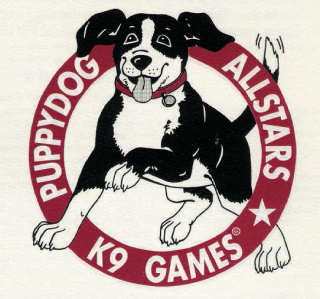
— The Ultimate Dog Show —
Over the past few years, television has gone to the dogs! Dogs have become more and more prominent in the media, movies and sitcoms. Puppy dogs have a proven “Ahhhhh!-factor” and are used to advertise numerous products from cars to beer. In England dogs even advertise toilet tissue! Dogs have everything. The time has come for dogs to advertise themselves!
Twenty years ago, I predicted, that dog events (especially Dog Dancing) would become the next big-money TV sport, in much the same way that Figure Skating (skating repetitive figures) has evolved into Ice Dancing. It is just begging to happen.
The K9 GAMES® is a fast-moving, fun-filled, action-packed, doggy extravaganza with puppies and dogs, children and adults all having a great time. Winning is only the tertiary reason for competition. The secondary reason for competition is to entice spectators to want to train their dogs the dog-friendly way. At all times K9 GAMES® competitors are ambassadors for dogs, and for dog-friendly dog training. The primary reason for competing is for people to have fun with their dogs. Indeed, laughter and giggles, and woofs and wiggles are the hallmark of the K9 GAMES®.
The K9 GAMES® bring back some sparkle, some excitement and razzle-dazzle to pet dog training, by providing an organized forum to motivate owners to want to train their dogs using easy and enjoyable, dog-friendly dog training techniques. All events are designed to improve the quality of the relationship between dogs and people and each individual event, (including doggy-dashes, retrieval races, woof relays and the signature event — doggy dancing), is specifically designed to fine-tune essential ingredients of a pet dog's training repertoire.
The K9 GAMES® showcases dog-friendly dog training — showing people having fun with their dogs and dogs having fun with their people. The K9 GAMES® provides educational entertainment to an ever-expanding audience, which is all but begging for more dog-related good times. People love to laugh. People and dogs love fun, action, athleticism, competition, excitement and family events. People are seduced by game shows and repetitive sporting activities. (In England, show jumping and sheep herding competitions are prime time viewing!) People even enjoy watching the variety of different breeds stand around and look pretty at conformation dog shows. The K9 GAMES® offers all of the above and much more.
The K9 GAMES® is a team competition with each team having a maximum of nine dogs and nine handlers. The teams compete in nine games: Musical Chairs, Doggy Dash, Kong Retrieve, Distance Catch, Take & Drop, Joe Pup Relay, Recall Relay, Woof Relay, and the K9 GAMES® signature event — Waltzes with Dogs
In the pursuit of proofing, reliability of performance and surprise in competition, K9 GAMES® Rules may be changed at any time during a competition and certainly, from event to event. The K9 GAMES® were initially held in 1995 at Fort Mason in San Francisco. In subsequent years they have been held in Long Beach (‘96), Upper Marlboro MD (’97), Toronto (’97, ’98 & ’99), England (’03, ’04 & ’05) and Japan (’05 ’06 ‘07).
Musical Chairs
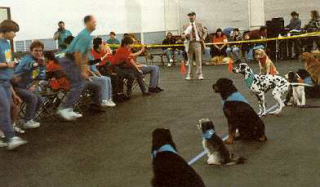
Musical Chairs is a doggy variation of the classic children’s game. Music plays as handlers walk with their dogs off-leash counter-clockwise around a rectangular area. A line of chairs (with alternating chairs facing in opposite direction) runs down the centerline of the rectangle. When the music stops, the handlers instruct their dogs to sit by verbal request and/or hand signal only, (i.e., without touching them), and rush to sit on a vacant chair in the center of the rectangle. Musical chairs is meant to be a non-contact sport; with the exception of two human rear ends making contact when attempting to sit simultaneously on the same seat, physical contact with any dog or other competitors is not allowed.
The dogs must remain in sit-stays outside of the rectangle. If a dog breaks his sit-stay, or if any part of the dog’s body causes a Line Fault by cutting the line of the rectangle, (paw-faults and tail faults included), the handler must vacate their chair and completely leave the rectangular area to re-sit their dog without contact before trying to find an empty chair once more.
There are always fewer chairs than handlers. The chair-less handler may attempt to get other dogs to break their sit stays by sweet-talking, calling, offering food treats, and by generally acting silly. However, the handler must not use any dog’s name and they must not touch or frighten any dog. Once all of the chairs are occupied by handlers whose dogs remain in sit stays outside of the rectangle, the handler left standing is eliminated. One chair is removed from the line and the next round begins. The top two qualifiers from each round go into the Final.
Training Tips
Playing musical chairs teaches dogs two of the most useful pet dog skills — a lightning-fast, off-leash, emergency Sit plus a rock-solid Sit-Stay. When dogs are successful at playing Musical Chairs, they will take a quantum leap in terms of their quality of life because when owners have such a high degree of off-leash control, they are much more likely to take their dogs to dog parks and on off-leash walks.
Also, dogs with prompt and reliable Sit-Stays are likely to be given full-run of the house, rather than being locked away when visitors arrive. Dogs with reliable Sit-Stays are just much more fun to live with. A quick Sit and solid Stay prevent or resolve well other 90% of possible behavior and training problems because sitting and misbehaving are usually mutually exclusive activities. For example, your dog cannot jump-up, chase his tail, chase the cat, practice agility in your living room, dash out the front door, or lunge on leash and sit at the same time. When in doubt, just say, “Sit!”
Musical Chairs is played off-leash and handlers are not allowed to touch their dogs, so that owners are encouraged to achieve verbal, off-leash, and distance control over their dogs. If owners were allowed to tug on the dog’s leash to encourage him to follow, or to push on the dog’s rump to prompt or coerce him to sit, they would come to rely on leash-tugs and rump-pushes and so, would have no control over their dog if he were off-leash and out of hands reach. When a dog is off-leash, at a distance and looking away from his owner, verbal control is essential.
To gain a competitive edge in Musical Chairs, heel your dog on your right-hand side to keep him as far away from the rectangle when walking counter-clockwise, then he will be less likely to cause a Line Fault when you hustle towards the chairs when the music stops. Whereas, if your dog heels on your left, he will likely sit very close to the Fault Line of the rectangle.
In the earlier rounds, ask your dog to sit and make sure he is in a solid-stay before calmly walking to the line of chairs. In the earlier rounds, a chair will always become available. Dogs will likely be breaking sit-stays every which way but loose. The goal is to qualify for the Final. However, in the Final, your dog will need to sit immediately after the music stops and you give the command while running for a chair. Lure/Reward training is by far the best way to achieve such speedy distance control.
When first watching Musical chairs, many people ask whether it is fair for the chair-less competitors to try and get other dogs to break their Sit-Stays, especially when the chair-less people call the dog, “Puppy, come here,” when they say and signal “Down!” and when they enticingly waggle or toss a food treat. Of course it’s fair! Not only is it fair, but also, ultra-proofing a dog’s Sit-Stay is one of the most important training exercises. For example, let’s say your dog is off-leash in the dog park and suddenly, you notice that some unthinking owner is holding the gate wide open and your dog is rushing towards the street. You instantly shout, “Rover, Sit” and your dog immediately and obediently screams to a halt in a Sit-Stay. However outside the park a little girl is calling her dog in a sweet voice, “Come here, Molly. Come on puppy. Come and get a cookie.” Do you want your dog to remain in a Sit-Stay, or run out of the park to the little girl? Obviously, we would like the do g to remain in a Sit-Stay, that’s why we proof dogs to respond only to commands, that are preceded by their name and to ignore all others. When you instruct your dog to Sit-Stay, you do not want him to respond to other people. Similarly, if you live with more than one dog and say, “Rover, Sit. Fido, Come,” you want Rover to sit and Fido to come, not vice versa. A dog has a name for a reason and so; let’s use it prior to every command where a reliable response is essential.
Doggy Dash - Racing Recalls
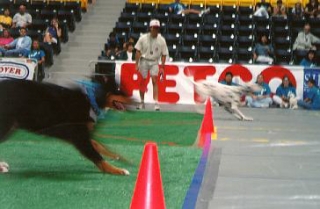
Pairs of dogs race against each other and the winning dogs go through to the next round. Each dogs is held at the Start Line by a steward who releases the dog as soon as the judge says, “Ready, steady go!” The first dog to sit across the Finish Line wins and goes through to the Second Round. Dogs are disqualified if they leave their racing lane. Winning dogs from the Second Round go through to the Quarter Finals. Eventually, two dogs compete in the Final to determine who is the fastest dog of the competition.
Training Tips
Slow recalls and no recalls are quite common with many pet dogs. Unless numerous short training interludes have been thoroughly integrated into the dog’s off-leash investigation and play (by frequent come here/go play, come here/go play sequences), for many dogs, “Come Here” usually signals the end of an otherwise very enjoyable off-leash romp. And of course, it doesn’t improve matters that the contorted-faced owner is screaming, “COME HERE YOU MISERABLE CUR!!!”
On the other hand, prompt and fast recalls are seldom a problem for dogs that compete in the Doggy Dash. The handlers become extremely lively and animated and so not surprisingly, the dogs come flying at warp speed. The dog now has good reason to come when called to his happy owner and will be more than praised when he gets there. In fact, in the Doggy Dash most dogs come so fast that a reliable recall is pretty much a given. Winning this game is all about teaching your dog to sit quickly. So many times I have seen the first dog to cross the Finish Line come second, because he shot through the owner’s legs, circled, barked and jumped up.
Increase the speed of your dog’s sit by practicing multiple, short come-sits and differentially reinforcing only the quicker sits. Take one step back and then instruct and signal your dog to Come and Sit. Repeat this sequence 20 times with ten pieces of kibble and three pieces of cheese or liver in your hand. Give no feedback to your dog if you have to repeat the verbal command or hand signal. Similarly, give no feedback for slow Sits. Only praise your dog and offer a single piece of kibble for the faster Sits. And for the fastest Sits… celebrate as if your dog has won the Olympics, praise, hug, jump up and down and offer one or two pieces of cheese or liver.
When competing, your timing is crucial. Stand on the Finish Line when calling your dog and hold your signal hand out in front as a point of focus for the dog. As your dog crosses the halfway point, back up across the Finish Line (be careful not to fall over when running backwards) and shout and signal Sit just as your dog is two dog-lengths from the Finish Line. A seasoned competitor will dash towards you and slide across the Finish Line in a Sit-Stay.
Additionally, it is vital that your dog understands the whole point of the game — to come as quickly as possible and to be the first dog to sit across the Finish Line. It is essential that your dog understands the concept of Fast vs. Slow and it is advisable to instill a desire to win in your dog!
Even though you are going to jump up and down and scream like a banshee to get your dog to come as quickly as possible, we want to teach the dog to understand that this is a race and that urgency is essential. Whereas it makes sense to teach a slow dog to move faster, very few owners appreciate that a very fast dog can also be taught to move even faster. Training fast dogs to move faster can be quite difficult, unless you first teach your fast dog to move slowly, then the change in pace between slow and fast is quite dramatic and much more obvious to the dog and therefore, easier to put on cue.
You may train your dog while walking him on-leash. Walk in a straight line and periodically adjust your speed through three gears — very slow, normal and very fast. Your dog will soon begin to adjust his pace accordingly. Now we are going to put the dog’s change of pace on cue.
When you are walking very slowly, 1. Say, “Rover, Quickly” or “Rover, Hustle” (you may chose to use whichever verbal command you prefer… instruct your dog in French or Italian if you wish), 2. Abruptly change pace from very slow to very fast, and as soon as… 3. Your dog changes pace accordingly, 4. Praise and reward your dog. And then, when you are walking very quickly, 1. Say, “Rover, Slowly” or “Rover, Steady,” 2. Abruptly change pace from very fast to very slow and as soon as… 3. Your dog changes pace accordingly, 4. Praise and reward your dog. Repeat this training sequence a dozen or so times, and you will find your dog will speed up when you say “Rover, Quickly” and slow down when you say “Rover, Slowly.”
Now call your dog and when your dog is running towards you at Warp Factor Nine, say “Quickly! Quickly!! Quickly!!!” and you will discover that he has an extra, ultra-hyper-mega turbo drive.
Now, it’s time to teach your dog to have an overwhelming desire to win, so that he will offer that little bit extra when in competition. Practice with another handler and dog plus two dog holders. Race both dogs against each other and reward them differentially, according to who comes first and who comes second. Praise the second place dog and let him sniff a liver treat but not eat it. Celebrate with the winning dog and give him three liver treats. By staggering the starts it is easy to set it up that each dog wins 50% of the time. Periodically race and time the dogs over the standard 49-yard distance and you will see their times improve from week to week.
Kong Cup Challenge
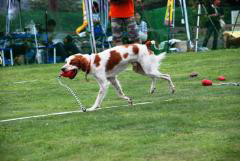
In one of the most exciting and fast-paced games, dogs have just one minute to accumulate as many points as possible by retrieving chewtoys of different point values from an enclosed retrieval area. Light-blue (water) Kongs are valued at 5 points, red Kongs at 3 points and black Kongs 1 point. The handler stands in a two-yard square Handler's Box within a five-yard square penalty box. In order for points to score, the handler must be able to take or pick up the object (with at least one part of their body remaining grounded in the Handler's Box) and place it in a plastic bucket. If the dog brings back a Bonus Kitty (soft toy) the final score is doubled, whereas if the dog’s paw enters or cuts the line of the Penalty Box while he is carrying a Penalty Bone in his jaws, the final score is halved. Retrieving a Kong Biscuit Ball increases the allotted retrieval time by 15 seconds. The dog with the highest score wins.
Training Tips
Practice as a group in many different places, with other dog’s Kongs and make sure to teach your dog discriminated-retrieves, i.e., your dog needs to be trained to reliably retrieve a Kitty or a blue Kong when requested.
Many owners fall into the comfortable trap of only training in familiar settings with familiar objects — the dog’s own Kongs. When it comes time to compete, the dog spends the entire minute running round the arena sniffing each Kong in turn looking for his own, and the final score is zero. It is important to practice with other dog’s Kongs and to do so in a variety of settings — in different people’s homes and yards and in parks and on walks. It is essential that your dog is as reliable in the arena as he is at home. Walk your dog with friends and their dogs and every 25 yards each person puts down a Kong for another dog to retrieve.
Many handlers think that it is sufficient to compete with a “retrieving fool” — a high-speed retriever who simply lives to retrieve and will bring back object after object non-stop. Usually they fair pretty well in competition because they bring back so many objects. However, sometimes their tally consists of toys with a low point value, or even Penalty Bones. For example, the dog may bring back ten objects within the one minute period — six black Kongs, two red Kongs and two penalty bones, the total score is only 3 points. Compare this to a dog (competing in the Toronto Sky Dome), who picked up three stuffed Kitties and shoveled the fourth Kitty back to his handler on his very first run. This meant that his next three retrieves — three blue Kongs — were each worth double-double-double-double 5 points (80 points) for a total score of 240.
To win this game your dog needs to be taught which specific objects he should retrieve. Teach your dog discriminated-retrieves in the same way that you would teach your dog to find your lost keys, or the remote control for the television.
Dogs that compete successfully in Kong Retrieve become absolutely Kong crazy and seldom become destructive chewers or excessive barkers when left at home alone. They have become Kongaholics and would much rather lie down and chew their food-stuffed Kongs than destroy the house or bark all day. Also, dogs are taught not even to touch, let alone pick up, forbidden articles, such as Penalty Bones but instead, to redirect their retrieving urges to Kongs.
Distance Catch
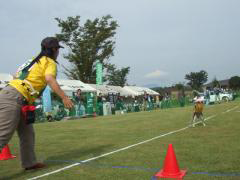
Each handler has three attempts to throw an object of their choice (ball, toy, bean bag, Frisbee, etc.) for their dog to catch. All competitors take their first throw, before the Second Round of throwing. In both the Third Round of throwing and in the Final, the competitors throw in reverse order to the current standings, i.e., the competitor with the shortest distance throws first and the competitor with the longest distance in the first two rounds throws last. Prior to each throw, the dog may wait at any point in the arena, or the handler may instruct their dog to stay at a specific location. The owner must remain behind the Throwing Line before throwing the object and until a Fair Catch has been signaled by the judges. For a Fair Catch, the dog must catch the object using jaws and/or paws before the object touches the ground and after catching the object, the dog must land with all four paws inside the four-yard wide Catching Lane. The dogs with the eight longest Fair Catches qualify for the Final.
Training Tips
Aside from dog training tips, there are some obvious human requirements for this game. Considerable thought should be given to the choice of object, handlers should practice throwing straight and increasing the distance of their throws, and handlers should address the strategy of the game.
Choose an object that is safe. Also, the choice of object will strongly influence accuracy, distance and ease of catching. The owner should try to throw the object on as low a trajectory as possible High throws go a long way up and a long way down but not too far horizontally. Also, with high throws, the dogs often lose the object in the arena lights. Tennis balls tend to bounce out of the dog’s jaws. Soft toys are easy to catch but too light to throw great distances and are much more difficult to throw accurately. In one competition a handler threw a soft toy so high, that it caught the air currents and landed behind them! Frisbees travel the greatest distance, but require greater expertise to throw accurately. A beanbag with a rope tail is one of the easiest objects for the dog to catch and it may be thrown accurately and over great distances with a low trajectory.
Distance Catch is a strategic game, similar to a long jump competition. When starting the Second and Third Round of throws, each competitor is aware of the standings and knows exactly where to place their dog to qualify for the Final. Similarly, in the Final, each competitor knows exactly where to place their dog to win first, second or third place. Aside from the ability to catch the object, a solid and attentive sit-stay is the secret to success when positioning the dog at a specific distance within the Catching Lane. Many dogs will walk back towards their owners after being positioned and even if they catch the object, the distance is much less than the handler had hoped for.
Take and Drop
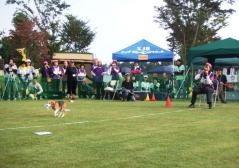
Within the allotted one-minute time period, the dog must take an article from the handler and follow the handler’s directions, so as to drop the article as close as possible to a $100 bill, which is taped on the floor approximately 30 feet away. The article (usually a squeaky and/or soft toy) is supplied by the judge and is the same for each dog in any competition but is different for each competition. While giving directions to the dog, the handler must remain seated at all times. The handler is disqualified if the judge can see daylight between the handler’s butt and the chair. Once the dog has placed the object to the handler’s satisfaction, the handler raises an arm and shouts, “Mark!” and the distance is measured. The area is littered with other paper markers, so that it is not a practical strategy simply to teach the dog to go to a single and obvious marker. Instead, to compete successfully in the Take and Drop, the dog needs to be taught to take precise directions from the handler.
Training Tips
Take & Drop is by far the most difficult event in the K9 GAMES because the dog’s performance has to be so precise in an arena with many distractions, including many people and dogs, numerous dropped food treats, music playing and spectators laughing and clapping. A dog that competes successfully in Take & Drop is simply an extremely well-trained dog — an advertisement that he has the good fortune to live with and extremely talented dog handler.
Many dogs become very adept at this game when playing with own toy in their own back yard or in a familiar park, yet they fail in competition. Indeed, a surprising number of dogs even fail to take the object from their handler. Some dogs take the object but fail to leave, and spend the entire minute sitting by the handler’s side. Other dogs eagerly take the object and work well for a while but then become distracted and drop the object and fail to pick it up again. Perhaps even more frustrating are dogs that take the object and follow the handler’s directions to go and sit by the $100 bill, but then fail to drop the object. The object must be on the floor and the handler must shout, “Mark!” before the distance can be measured.
When offered an unfamiliar object, especially in an unfamiliar place, most dogs want to thoroughly investigate the object before taking it. In unfamiliar places, many dogs want to remain close to their handler.
Aside from teaching your dog directional commands, you also need to teach your dog to take any article on command, to pick-up and drop any article at a distance and to do so in a wide variety of settings.
Gun dog trainers usually teach the dog to run out in a straight line and at the sound of a whistle to sit facing the handler to take further directions for left/right and back/forward. For Take and Drop, I much prefer to train dogs to walk backwards. Aside from the fact that this is hilarious to watch, having the dog walk backwards allows for more precise directions because the dog walks slowly and can always see the handler’s hand signals to go back, right/left, sit, or lie down. Additionally, it is a huge advantage to teach the dog to move slowly on cue, especially when instructing the dog to come closer.
The best way to proof for different objects and environments is to train with a friend on a walk. Have the friend bring half a dozen or so different objects for your dog, and you bring half a dozen for their dog. Every 25 yards, stop and train; ask your dog to take the object (from your hand) and to carry, drop and retake the object (from the ground). Tie the dog’s leash to a tree and instruct the dog to pick up and drop the object at a distance. Now practice the entire Take and Drop in a variety of safe settings, indoors, in a friend’s yard and dog parks. Have specific criteria. Choose specific places in the environment to send your dog. For example, direct your dog to go and lie down on a specific spot on the living room carpet, or on a specific floor tile in the hallway. Or, instruct your dog to go and sit by a specific tree or bench in the park. Or, instruct your dog to take and drop the object next to a flower or fallen leaf on the grass.
Joe Pup Relay
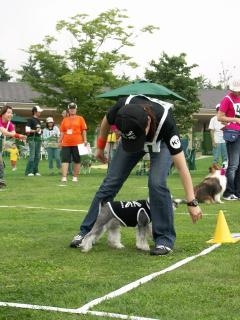
Each team consists of one dog and four handlers. Two teams compete at a time and the winning team goes through to the next round. Dogs race in individual lanes and run from person to person, performing a different obedience routine with each handler stationed at each of four stations. The exact nature of the routines to be performed at each station is only made known to competitors on the morning of the competition.
Training Tips
I designed the Joe Pup game in 1989 at the request of the owner of Blue Springs Dog Training Center in Colorado to help prepare nervous handlers for competition by teaching them to think quickly under pressure while performing extremely complicated and varied routines. In the original Joe Pup Relay, each handler (plus dog) raced one-at-a-time against the clock. The handler started at Home Plate and raced around a baseball diamond performing a different, recently-learned, complicated obedience routine at each base. The game was an instant success and so I adapted it for use in SIRIUS® puppy classes.
For pet owners, each base represented a virtual reality pet dog training scenario. Starting with their dog in a Sit-Stay on Home Plate, the owner had to run to First Base, which represented a veterinary clinic and the dog had to perform a Sit-Down-Sit-Stand-Down-Stand sequence to prepare him to Down-Stay in the waiting room, Sit on the scale and Stand for examination. Second base represented a Range Rover and the dog had to jump-up on a platform and remain in a Sit-Stay while the owner placed two grocery bags (with dog treats) beside the dog, circled the platform twice singing How Much is That Doggie in the Window (don’t ask me why) and then sit in a chair for ten seconds with their back to the dog. Third base represented the TV room couch and the owner had to lie down on the floor (couch) and then instruct their dog to lie down (so they could see the TV) for a count of five “Good dogs.” Then the owner had to run back to Home Plate, ask their dog to sit and tap him on the head.
In the early 90s we randomized the exercises at each base, by asking each owner in class to teach their dog a new trick or training sequence and to write the routine on a card. All the cards were put in a hat and each competitor would draw three cards for their round. Sometimes they would pick a routine that their dog didn’t know yet. Well, you’re racing against the clock and so… train that do g NOW! We found that this format gave owners lots of confidence and that rather than making excuses for what their dog didn’t know, they just trained their dog on the spot.
By playing Joe Pup in the K9 GAMES format with one dog and four handlers, now the dog’s owner has to learn the pet dog trainer’s role — how to teach other people to handle the dog that you have already trained. This of course prepares families for living with dogs. Dog owners learn how to teach other family members and friends to work with the dog that they have already trained.
To successfully compete in Joe Pup, all you need an ultra-socialized dog, who is perfectly willing to work with a variety of people plus three other people, who can improvise when the pressure’s on. To avoid confusion, only one person should instruct the dog at a time. It is especially important that the owner does not talk when other handlers are working with the dog, otherwise the dog will ignore the handler and run back to his owner.
Recall Relay
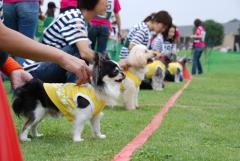
Two teams of four dogs race against each other and the winning team goes through to the next round. Dogs may be instructed to Sit Stay, or be held by other team members behind the Start Line, while the handlers walk across the arena to stand behind the Finish Line, facing their respective dogs ten yards away. Most teams elect to have holders, because after three false starts, the team is eliminated. Also the dog holders may amp-up the dogs prior to a catapult release.
After the judge, says, “Ready… Steady… Go!” the two handlers (from opposing teams) at either end of the line call their dogs first. Each dog is required to come and sit (entirely across the Finish Line, whereupon the handler taps the dog on the head as a signal for the next handler in line to call their dog. When the fourth handler has tapped the dog on the head for sitting, all handlers instruct their dogs, “Down!”
Training Tips
All dogs need to be super-friendly and confident around people, because they are held by other team members at the Start Line. As in the Doggy Dash, fast and reliable recalls are pretty much taken for granted. To gain the competitive edge, team members want to teach their dogs quick Sits and Downs and learn to pay attention to what their team members are doing.
This game is pretty simple, yet so many teams disqualify. Holders let go of dogs too soon. Handlers call dogs too soon or forget to tap the dogs on the head. One handler forgot to Down his dog at the end and lost the race for his team.
The Recall Relay is all about awareness — paying attention to what other dog handlers are doing with their dogs and what you should be doing with yours. Recall Relay handlers become safer handlers; when walking their dogs, they are very quick to get the dog to come and/or sit should the safety or distracting nature of the environment change for the worse, for example, if children are approaching, or if other dogs or animals are on the loose.
Woof Relay
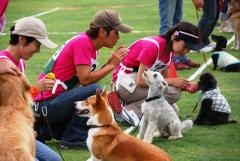
The Woof Relay is a timed event; each team, comprising five dogs and five handlers, competes one-at-a-time against the clock. Each dog has to woof three times and then shush. The team with the shortest total time for 15 woofs wins.
Training Tips
First, you need to teach your dog to speak on cue. Your dog might bark eventually, especially if you do all sorts of silly things, like jump up and down, roll on the floor, sing, or bark at your dog. But that won’t fly for this competition. The Woof Relay World Record is 7.11 seconds for 15 woofs by the Dealing With Dogs team in the Toronto Sky Dome (1999). What you need for this game is a dog who instantly barks three times when you say “Speak!” anytime, anywhere. You need to teach your dog to speak on cue in a variety of different settings and to objectively test your dog’s reliability. Walk your dog and every 25 yards say, “Speak!” (Just once). Note the percentage of times your dog barks following a single request and how long it takes for your dog to bark three times on each occasion.
The wonderful bonus of teaching your dog to Woof on cue is that Woof Relay dogs seldom become problem barkers. Teaching your dog to speak on cue enables you to teach your dog to shush at times that are convenient to you. For example, it is inconvenient and difficult to teach your dog to shush at 3:00am when you’re asleep and your dog is bent out of shape because a raccoon is raiding the trash. Instead, relax, say, “Speak,” praise your dog for woofing and then, 1. Say, “Shush! and immediately, 2. Waggle a piece of Liver Biscotti under your dog’s nose. As soon as your dog sniffs the Biscotti, 3. He will stop barking and so, 4. Calmly praise him, “Good shush one. Good shush two. Good shush three… and so on and then, eventually give him the treat. Repeat the Woof/Shush sequence over and over.
After teaching dogs to “Speak” and “Shush” on cue, owners may further teach their dogs to shush when people walk by the house, to bark should people step on the property, but to shush again as soon as people are invited indoors. One of my dogs (who used to be a serious problem barker) used to love this game and would sit for hours looking out of the front window, silently observing passersby, just daring them, or maybe willing them, to step on our property. Several of my neighbors told me that they appreciated this dog, because he always told them if anyone was going door-to-door.
Waltzes with Dogs - Doggy Dancing
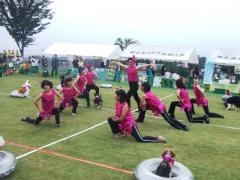
Each owner performs a unique choreography set to music. The various routines are marked out of 10 by a panel of five celebrity judges for both Technical Merit and Artistic Impression. The only rules are that the handler(s) has only 30 seconds to “set up” props and that the performance should last less than three minutes. The rest is left to the handler’s and dog’s creativity and imagination. Waltzes With Dogs is the signature event of the K9 GAMES.
Training Tips
Waltzes with Dogs is all about a close and special relationship between a dog and owner, who both thrill in having a good time together and entertaining spectators. Both dog and handler alternate between leading and following, each adjusting to the other to cover up mistakes. In this event, other competitors, spectators and even the judges smile and clap and laugh out loud when they see the amazing connection between handler(s) and dog(s). Handlers come up with the most creative and captivating routines, often moving, sometimes quite bizarre, but always a joy to watch. I won’t attempt to explain, just watch the videos.
Coordinated group performances are usually pretty hard to pull off, especially with an obedience drill team format because if just one dog makes a mistake, it stands out like a sore thumb. Groups need to practice, practice, practice until perfect and then pray that the performance will still be perfect on the day. One dog/one handler performances are usually easier to pull off because it is easier for handler and dog practice more often and easier for them to cover up mistakes during the final performance. However, recently, several Japanese teams have come up with unique group choreography, with each handler performing different (often pretty crazy) routines.
But regardless of the competition, dancing with your dog is simply the best of activities — a wonderful way to wind down after a hectic day at work. Just be yourself. Relax. Let go. Enjoy your dog. It only takes two to tango!